
2021 TRANSPLANT SALE
03/01/21 — Ada Broussard
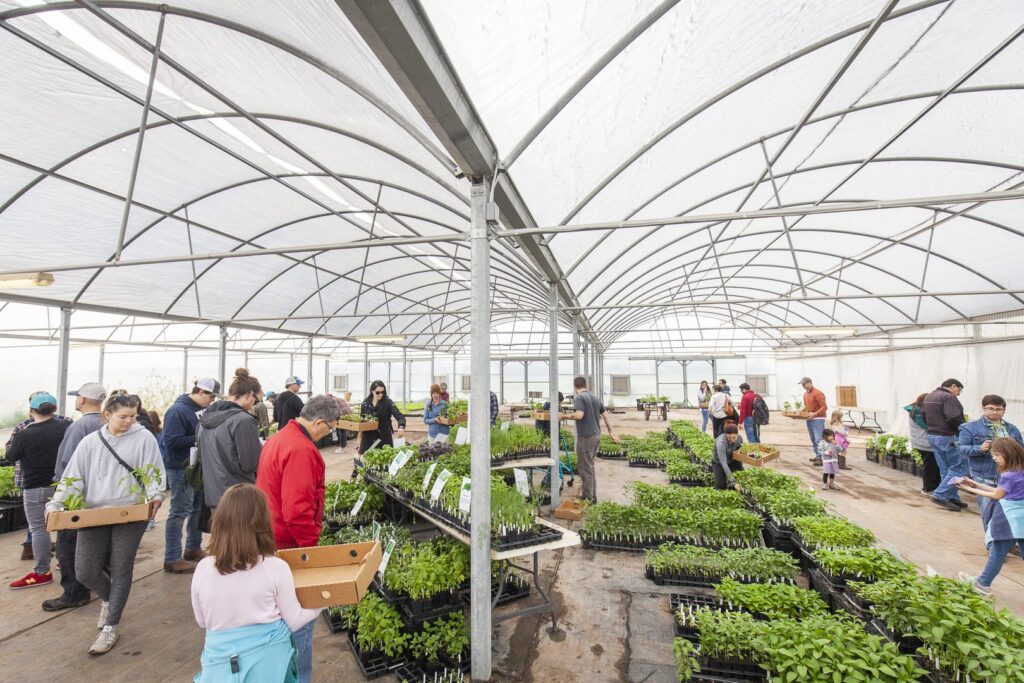
The 2021 Transplant Sale is underway! We are selling transplants from the JBG Greenhouses every Saturday from now until at least mid-May, or until we sell out. (We will update this page if we sell out.)
When: Saturdays! Feb 28 - mid-May (possibly later!) (9am-1pm)
Transplant sale is still on for May 15th. Come and get 'em!
50% off all transplants!
Where: 4008 River Road, Garfield, 78612
Make sure to use this address! Google may lead you to our other location. We will have our biggest selection of certified-organic transplants at this greenhouse sale, and will also be setting up a market stand so you can get some veggies, too! We will open all the doors to our large greenhouses, masks will be required, and social distancing procedures will be enforced. Luckily, there is plenty of space to spread out in. Head to the sale to see each of the 108 varieties we've grown, but expect endless options of tomatoes (including paste, slicing, and cherry), as well as peppers, eggplant, herbs, greens, and more! We've only grown transplants that we know are well suited for Central Texas gardens. We will also have a selection of organic compost, soil amendments, and farm-grade tomato cages and stakes available for purchase.
*Online Sales: Due to an overwhelming response, we have closed online orders or our transplants. We simply do not have the labor, nor truck space (!), required to put together and distribute the number of orders that were coming in. (If you already placed your order, we've already packed your order and will deliver it to your selected market!). Thank you for your understanding. Visiting the in-person sale is truly the best way to see the endless varieties we have and prepare for your best spring garden, yet! See you at the farm!
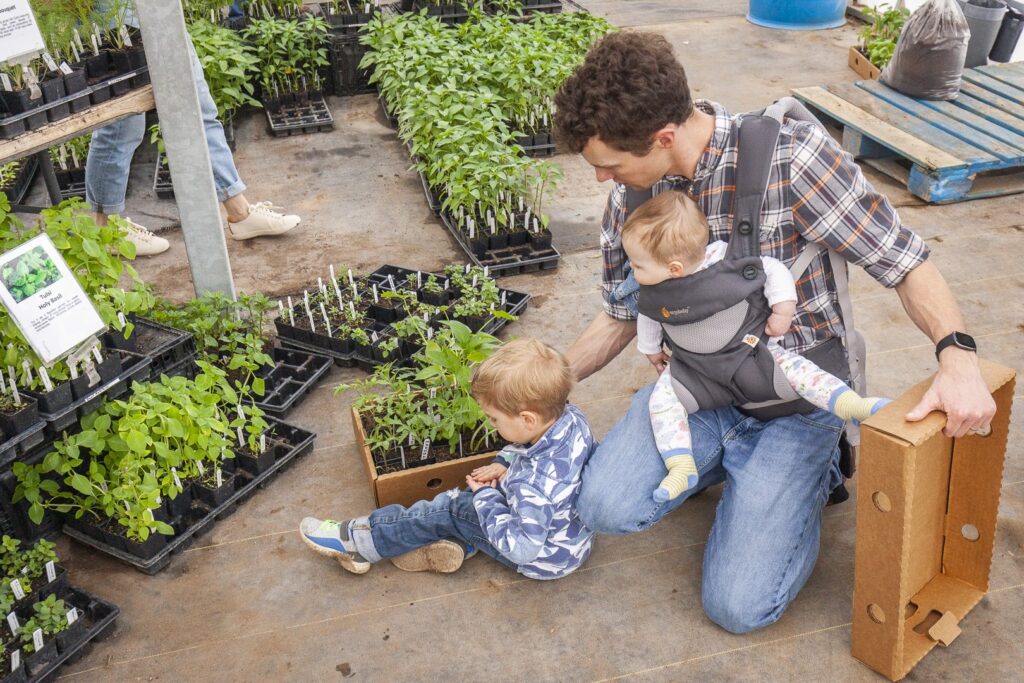
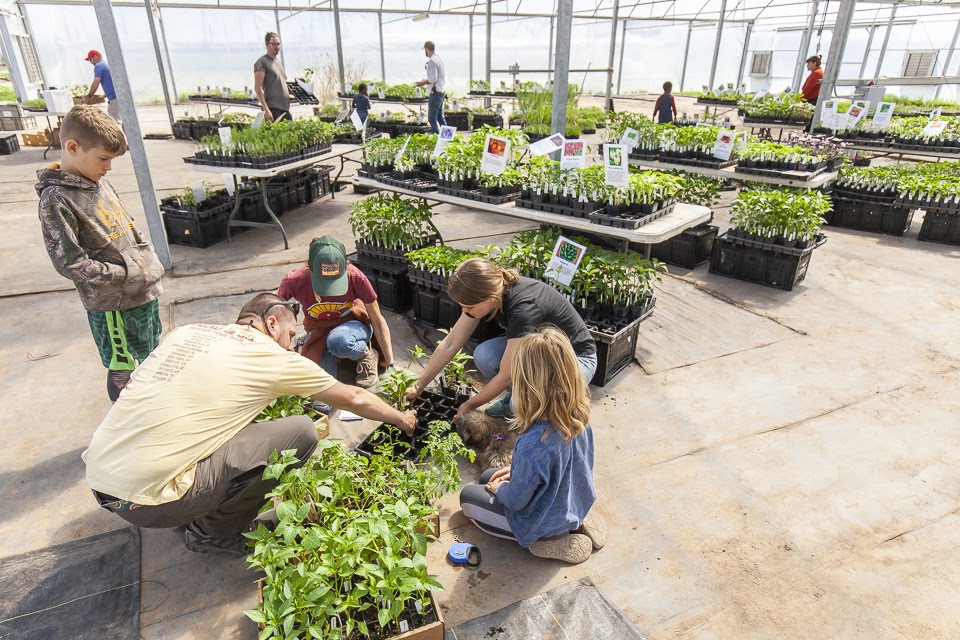
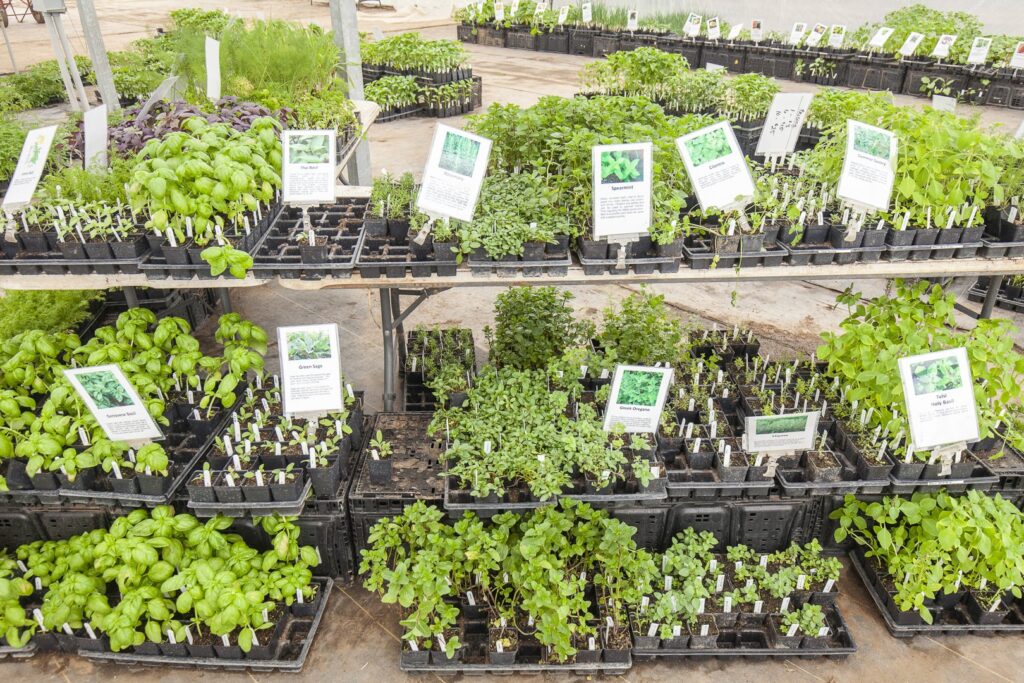
Each spring we usually have a large party at our farm where guests can meander through our fields and check out the spring crops. Although we're not having a big gathering this year, we still would love for you and your family to come out and enjoy the farm. Bring a picnic, and feel free to walk around with your family and stay awhile. There are 200 acres of vegetables for you to explore! Truly. When we first extended this invitation, we anticipated you strolling through lush and verdant fields, but of course things look a little grim, right now. Nonetheless, it’s a poignant reminder of the risk (and future reward!) inherent in farming (and gardening).
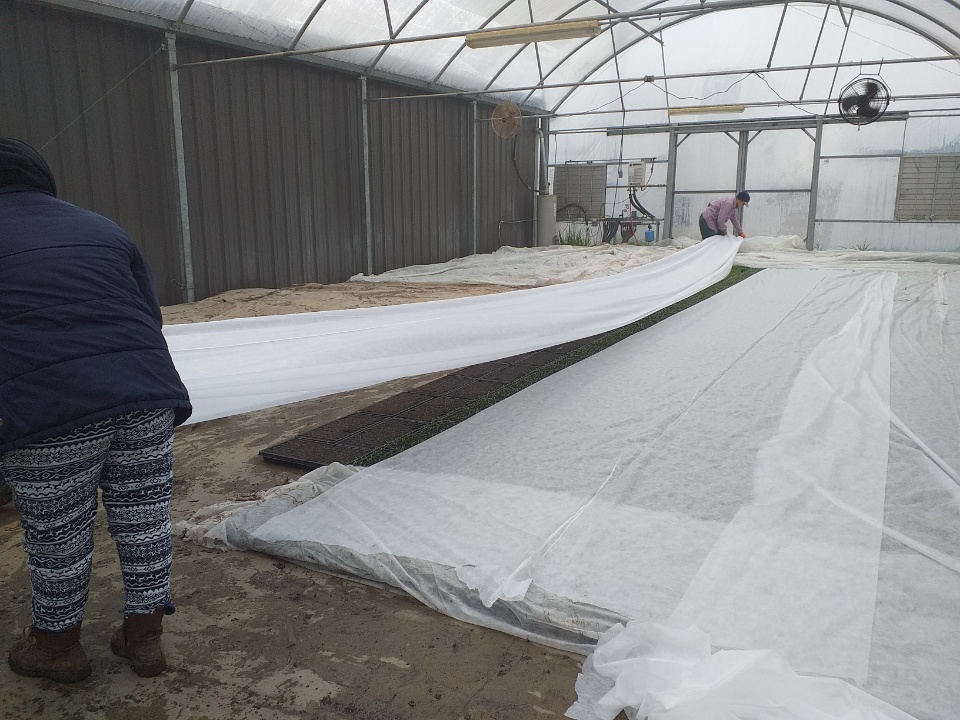 This one section of our greenhouse has a grid of copper coils underneath the concrete. The hot water heater in the corner pumps hot water through the coils, creating a heated floor. Transplants that wouldn't fit in the office or warehouse were covered in burlap, and then two layers of frost cover, and managed to stay nice and cozy. Photo snapped by Isabel.
This one section of our greenhouse has a grid of copper coils underneath the concrete. The hot water heater in the corner pumps hot water through the coils, creating a heated floor. Transplants that wouldn't fit in the office or warehouse were covered in burlap, and then two layers of frost cover, and managed to stay nice and cozy. Photo snapped by Isabel.
Some closing thoughts: All of our transplants did not survive by chance, and some of the heroes of the past weeks are our staff that work in our greenhouse including Gianna, Adam, Isabel, and Ki who spend 2 frantic days moving thousands and thousands of transplants from our greenhouse into our office, warehouse, and the one greenhouse space with heated floors. Checkout this quick clip on our Instagram to see a shot of the warehouse, usually used to store soil amendments, empty cell trays, and equipment, covered floor to ceiling with trays of plants. Our office, a small 500 or so square feet, was also completely full of transplants. Computers and keyboards were draped with lettuce, and desks crammed with tomatoes. The transplants that couldn't fit in the office or warehouse were crammed into our one greenhouse space that has heated floors, that were then covered with burlap (leftover from seed potato deliveries) and two layers of frost cover that we luckily had hidden in a storage closet. Thank you Brenton for never getting rid of anything. Truly, the transplants looked as though nothing had happened, making our replanting and your spring gardens destined for success.
See you at the farm!
>>>>>>>>>>>>>>>>>>>>>><<<<<<<<<<<<
Many of you have been asking about the types of plants you can find at this year's sale. Below is a list of vegetables we planted for this year's sale. *This list, however, is just to give you an idea of the types of plants we have - we may sell out of a specific variety, and won’t necessarily be able to keep the page updated… so don’t hold us to it!* But! The good thing about our sale is that we truly have a bounty of options. If you had your heart set on growing big, juicy, slicing tomatoes this summer, we’ve got several options for you. We planted over 31 different varieties of tomatoes alone... and that was us practicing restraint!
| Bonny Best | Tomato, Certified Organic |
| Black Krim | Tomato, Certified Organic |
| Brandywine Red | Tomato, Certified Organic |
| Brandywine Yellow | Tomato, Certified Organic |
| Caspian Pink | Tomato, Certified Organic |
| Cherokee Purple | Tomato, Certified Organic |
| Chocolate Stripes | Tomato, Certified Organic |
| German Johnson | Tomato, Certified Organic |
| Green Zebra | Tomato, Certified Organic |
| Lemon Boy | Tomato, Certified Organic |
| Taxi | Tomato, Certified Organic |
| Bush Early Girl | Tomato, Certified Organic |
| Celebrity | Tomato, Certified Organic |
| Golden Sweet | Tomato, Certified Organic |
| Phoenix | Tomato, Certified Organic |
| Tycoon | Tomato, Certified Organic |
| Champion | Tomato, Certified Organic |
| Black Cherry | Tomato, Certified Organic |
| Yellow Pear | Tomato, Certified Organic |
| Red Pear | Tomato, Certified Organic |
| Five Star Grape | Tomato, Certified Organic |
| Sungold | Tomato, Certified Organic |
| Sun Sugar | Tomato, Certified Organic |
| Sweet Baby Girl | Tomato, Certified Organic |
| Sweet Hearts | Tomato, Certified Organic |
| Sweet Treats | Tomato, Certified Organic |
| White Cherry | Tomato, Certified Organic |
| San Marzano | Tomato, Certified Organic |
| Verona | Tomato, Certified Organic |
| Mountain Magic | Tomato, Certified Organic |
| Aura Orange Bell | Sweet Pepper, Certified Organic |
| Bell Pepper | Sweet Pepper, Certified Organic |
| Banana Sweet Pepper | Sweet Pepper, Certified Organic |
| Chocolate Beauty Bell | Sweet Pepper, Certified Organic |
| Delilah Italian Sweet Pepper | Sweet Pepper, Certified Organic |
| Lipstick | Sweet Pepper, Certified Organic |
| Lunchbox | Sweet Pepper, Certified Organic |
| Islander Purple Bell | Sweet Pepper, Certified Organic |
| Sheepnose Pimento | Sweet Pepper, Certified Organic |
| Yummy Orange | Sweet Pepper, Certified Organic |
| Yellow Yummy | Sweet Pepper, Certified Organic |
| Glow pepper | Sweet Pepper, Certified Organic |
| Escamillo | Sweet Pepper, Certified Organic |
| Cayenne | Hot Pepper, Certified Organic |
| Cherry Hot | Hot Pepper, Certified Organic |
| Habanero | Hot Pepper, Certified Organic |
| Jalapeño | Hot Pepper, Certified Organic |
| Padron | Hot Pepper, Certified Organic |
| Pequin | Hot Pepper, Certified Organic |
| Serrano | Hot Pepper, Certified Organic |
| Tabasco | Hot Pepper, Certified Organic |
| Thai Hot Pepper | Hot Pepper, Certified Organic |
| Shishito | Frying Pepper, Certified Organic |
| Mixed Herb 6 Pack | Basil, Cilantro, Parsley, Dill, Mint, Sage |
| Fenugreek | Herb, Certified Organic |
| Catnip | Herb, Certified Organic |
| Chives | Herb, Certified Organic |
| Cilantro | Herb, Certified Organic |
| Curly Parsley | Herb, Certified Organic |
| Flat Parsley | Herb, Certified Organic |
| Dill | Herb, Certified Organic |
| Chamomile | Herb, Certified Organic |
| Genovese Basil | Herb, Certified Organic |
| Holy Basil (Tulsi) | Herb, Certified Organic |
| Sweet Thai Basil | Herb, Certified Organic |
| Red Rubin Basil | Herb, Certified Organic |
| Oregano | Herb, Certified Organic |
| Sage | Herb, Certified Organic |
| Lemongrass | Herb, Certified Organic |
| Lemon Balm | Herb, Certified Organic |
| Orazio Fennel | Herb, Certified Organic |
| Peppermint | Herb, Certified Organic |
| Rosemary | Herb, Certified Organic |
| Spearmint | Herb, Certified Organic |
| Summer Savory | Herb, Certified Organic |
| Thyme | Herb, Certified Organic |
| Texas Taragon | Herb, Certified Organic |
| Nadia Eggplant | Eggplant, Certified Organic |
| Ping Tung Eggplant | Eggplant, Certified Organic |
| Ginkaku Korean Melon | Melon, Certified Organic |
| Lilliput Cantaloupe | Melon, Certified Organic |
| Honeycomb Honeydew | Melon, Certified Organic |
| Mini Love <3 | Melon, Certified Organic |
| Pata Negra Watermelon | Melon, Certified Organic |
| Sugar Baby | Melon, Certified Organic |
| Hime Kansen | Melon, Certified Organic |
| Green Okra | Clemson Spineless Okra, Certified Organic |
| Red Okra | Burgundy Okra, Certified Organic |
| Pickling Cucumber | Citadel Cucumber, Certified Organic |
| Slicing Cucumber | Bristol Cucumber, Certified Organic |
| Lemon Cucumber | Cucumber, Certified Organic |
| Butternut Squash | Winter Squash, Certified Organic |
| Spaghetti Squash | Pinnacle Winter Squash, Certified Organic |
| Yellow Squash | Gold Prize Squash, Certified Organic |
| Zucchini | Payroll Zucchini, Certified Organic |
| Sunburst Patty Pan Squash | Sunburst Squash, Certified Organic |
| Taybelle Acorn Squash | Taybelle Squash, Certified Organic |
| Toma Verde | Tomatillo, Certified Organic |
| Red Butter Lettuce | Red Butterhead, Certified Organic |
| Green Butter Lettuce | Green Butterhead, Certified Organic |
| Green Romaine Lettuce | Green Romaine, Certified Organic |
| Rainbow Chard | Bright Lights Chard, Certified Organic |
| Bok Choy | Joi Choi Bok Choy, Certified Organic |
| Leeks | Lancelot Leek, Certified Organic |
| Toscano Dino Kale | Toscano Kale, Certified Organic |
| Curly Kale | Winterbor Kale, Certified Organic |
| Cauliflower | Freedom Cauliflower, Certified Organic |
| Broccoli | Green Magic Broccoli, Certified Organic |
| Organic Compost 5 Gallons | 5 Gallons NOP-Certified Organic Compost |
| Tomato Cages | Tomato Cages |
| Tomato Stakes | Tomato Stakes |
PUNCHY ORZO SALAD
03/04/21 — Ada Broussard
By Isaac and Heydon
![]()
This recipe is a punchy iteration of an orzo salad that Isaac likes to make for guests. We traded out some of the usual ingredients to make space for the kale in the taste profile. The jalapenos felt just right in this medley, adding crunch and punch. This is a loose guide, so switch out ingredients as you see fit. Design an orzo salad that works for you and what’s in your kitchen. This pasta salad was delectable when we threw it together last night at 10 PM and was just as good if not better when I ate it for an early lunch this morning. Pasta salad is such a lovely transitional weather meal.
Ingredients
Plate the salad. Add 1 piece of crispy bacon per plate. Crush it up and add it on top as a flavor-packed garnish. Grate some parmesan and add some lemon zest, too. Enjoy!

This recipe is a punchy iteration of an orzo salad that Isaac likes to make for guests. We traded out some of the usual ingredients to make space for the kale in the taste profile. The jalapenos felt just right in this medley, adding crunch and punch. This is a loose guide, so switch out ingredients as you see fit. Design an orzo salad that works for you and what’s in your kitchen. This pasta salad was delectable when we threw it together last night at 10 PM and was just as good if not better when I ate it for an early lunch this morning. Pasta salad is such a lovely transitional weather meal.
Ingredients
- 1 cup orzo
- 1 bunch of kale, chopped and blanched
- 5 green onions, finely chopped
- 1 jalapeno, sliced
- 2 cloves garlic, minced / very finely chopped
- 2 pieces of bacon, cooked to your preference
- Parmesan
- 1 Lemon
- Olive Oil
- Salt
- Pepper
Plate the salad. Add 1 piece of crispy bacon per plate. Crush it up and add it on top as a flavor-packed garnish. Grate some parmesan and add some lemon zest, too. Enjoy!
PHOTOS FROM THE FARM: 2.27.21
03/05/21 — Ada Broussard
Weekend one of our transplant sale was well attended, and Scott was there to capture the fun. Thank you to everyone who came out to the farm and snagged some plants! We're happy to report that we have PLENTY more, and we're excited for round 2 of the sale, happening this Saturday. Details on the sale here.
![]() Mushroom mafia, pepper patrol. Photo by Scott David Gordon.
Mushroom mafia, pepper patrol. Photo by Scott David Gordon.
![]() If you're new to gardening or are overwhelmed by the number of varieties we have at our sale, each plant type is clearly labeled with a bit of information about the fruit you can expect to grow. Photo by Scott David Gordon.
If you're new to gardening or are overwhelmed by the number of varieties we have at our sale, each plant type is clearly labeled with a bit of information about the fruit you can expect to grow. Photo by Scott David Gordon.
![]() Start 'em young! Photo by Scott David Gordon.
Start 'em young! Photo by Scott David Gordon.
![]() How many peppers is too many peppers? Photo by Scott David Gordon.
How many peppers is too many peppers? Photo by Scott David Gordon.
![]() We will still be requiring masks at our transplant sale. Thank you for understanding! Photo by Scott David Gordon.
We will still be requiring masks at our transplant sale. Thank you for understanding! Photo by Scott David Gordon.
![]() We spy an herb garden in the making, and maybe a future farmer, too. Photo by Scott David Gordon.
We spy an herb garden in the making, and maybe a future farmer, too. Photo by Scott David Gordon.
![]() No time like farm time to break out the sparkly rubber boots. Photo by Scott David Gordon.
No time like farm time to break out the sparkly rubber boots. Photo by Scott David Gordon.
![]() Or precious floral variety. Photo by Scott David Gordon.
Or precious floral variety. Photo by Scott David Gordon.
![]() Friends don't let friends garden alone. Photo by Scott David Gordon.
Friends don't let friends garden alone. Photo by Scott David Gordon.
![]() Did we mention there is lots of room to explore? And a trampoline to jump? Photo by Scott David Gordon.
Did we mention there is lots of room to explore? And a trampoline to jump? Photo by Scott David Gordon.
![]() And our mountain of a sand pile is just begging for attention. Photo by Scott David Gordon.
And our mountain of a sand pile is just begging for attention. Photo by Scott David Gordon.
![]() We're keeping the number of people in the greenhouse to a reduced capacity, but if there is a line, it moves super quick! Photo by Scott David Gordon.
We're keeping the number of people in the greenhouse to a reduced capacity, but if there is a line, it moves super quick! Photo by Scott David Gordon.
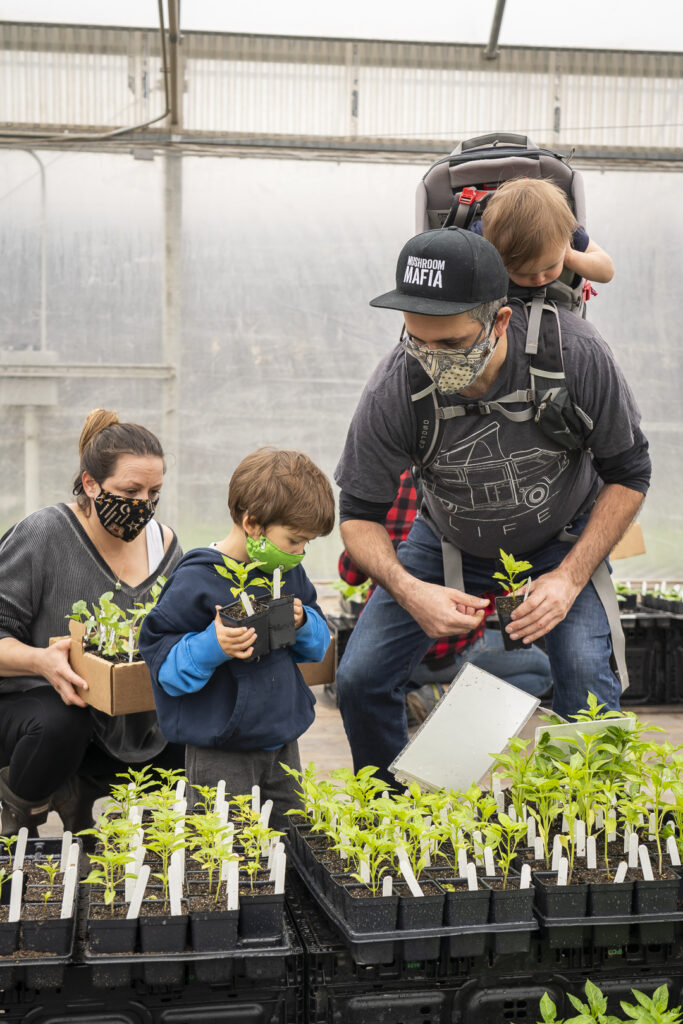 Mushroom mafia, pepper patrol. Photo by Scott David Gordon.
Mushroom mafia, pepper patrol. Photo by Scott David Gordon.
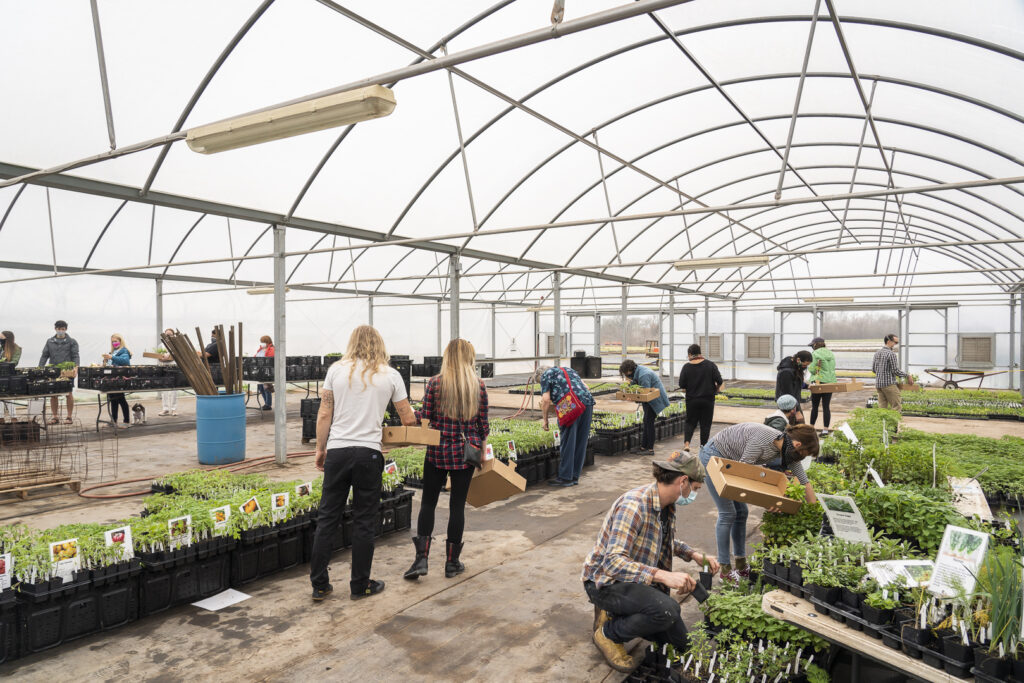 If you're new to gardening or are overwhelmed by the number of varieties we have at our sale, each plant type is clearly labeled with a bit of information about the fruit you can expect to grow. Photo by Scott David Gordon.
If you're new to gardening or are overwhelmed by the number of varieties we have at our sale, each plant type is clearly labeled with a bit of information about the fruit you can expect to grow. Photo by Scott David Gordon.
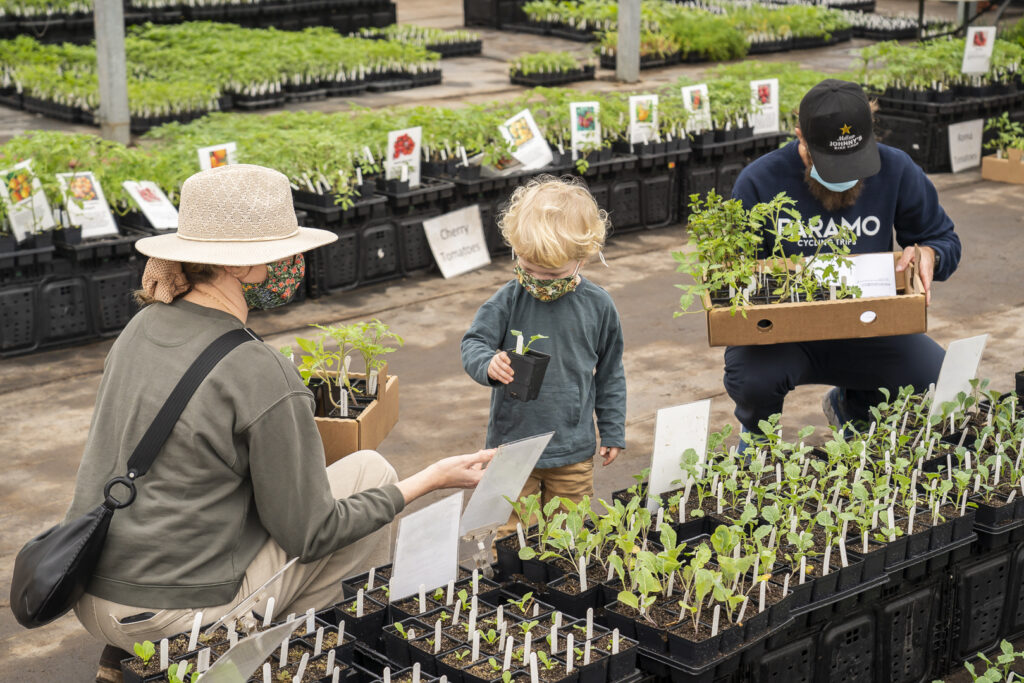 Start 'em young! Photo by Scott David Gordon.
Start 'em young! Photo by Scott David Gordon.
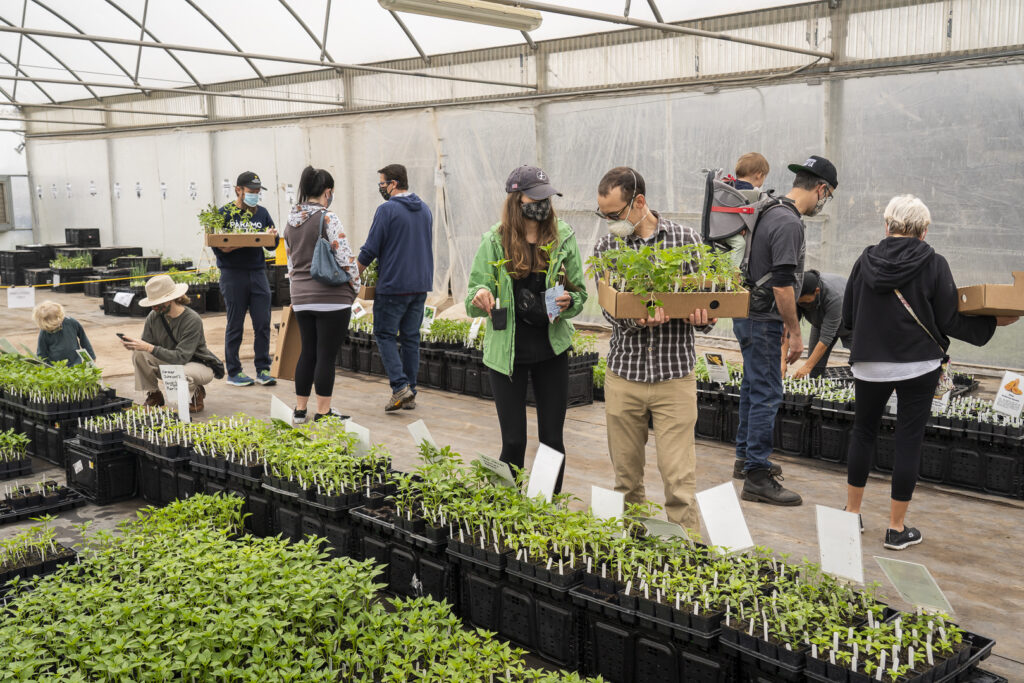 How many peppers is too many peppers? Photo by Scott David Gordon.
How many peppers is too many peppers? Photo by Scott David Gordon.
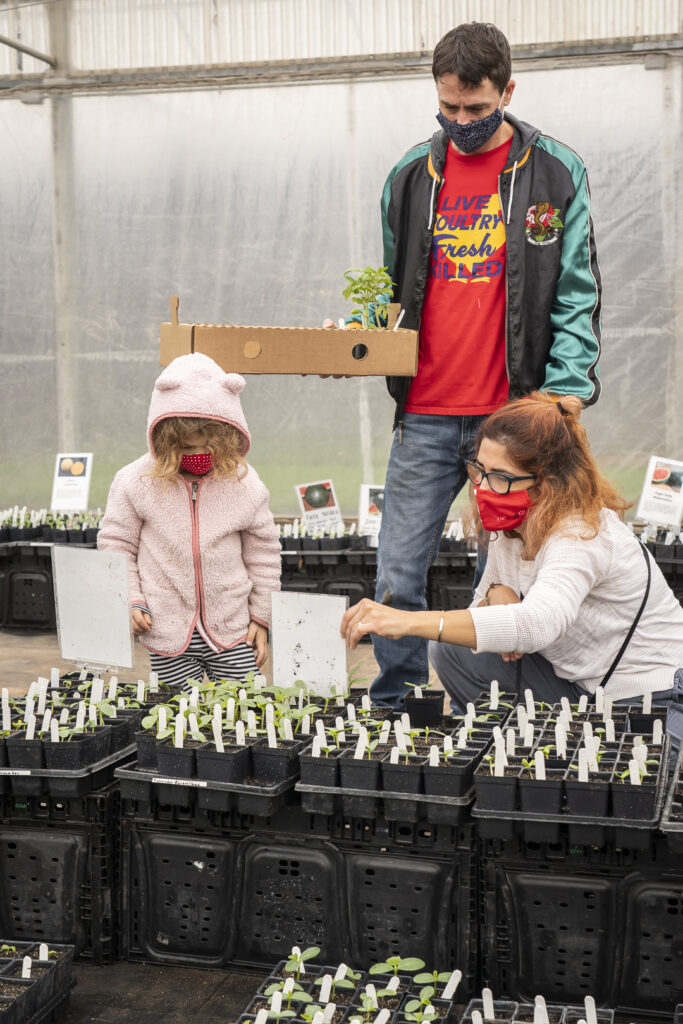 We will still be requiring masks at our transplant sale. Thank you for understanding! Photo by Scott David Gordon.
We will still be requiring masks at our transplant sale. Thank you for understanding! Photo by Scott David Gordon.
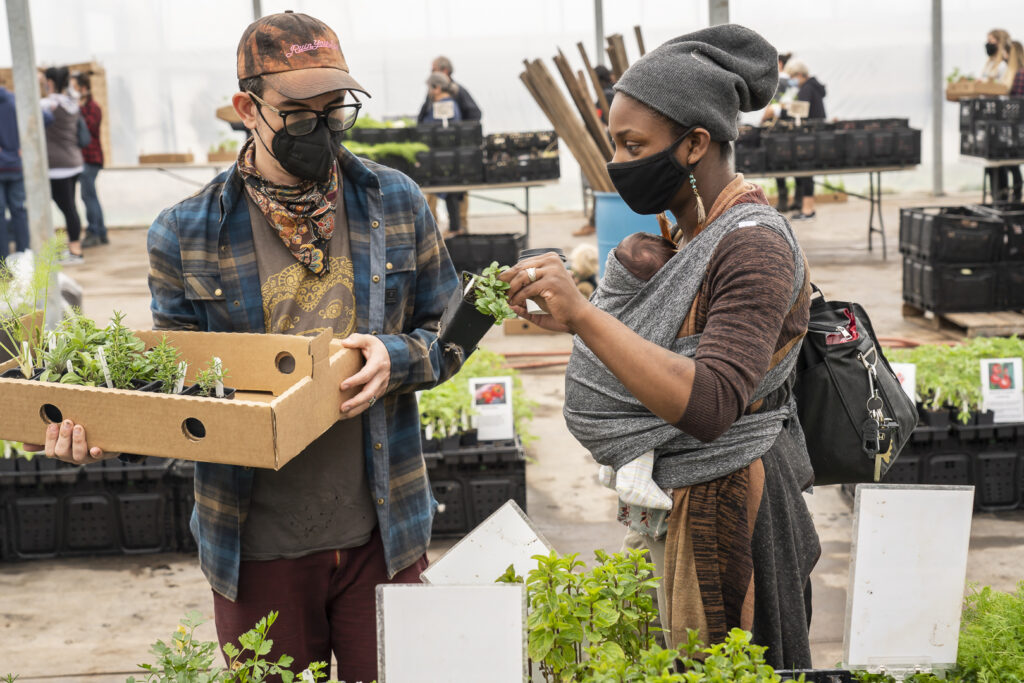 We spy an herb garden in the making, and maybe a future farmer, too. Photo by Scott David Gordon.
We spy an herb garden in the making, and maybe a future farmer, too. Photo by Scott David Gordon.
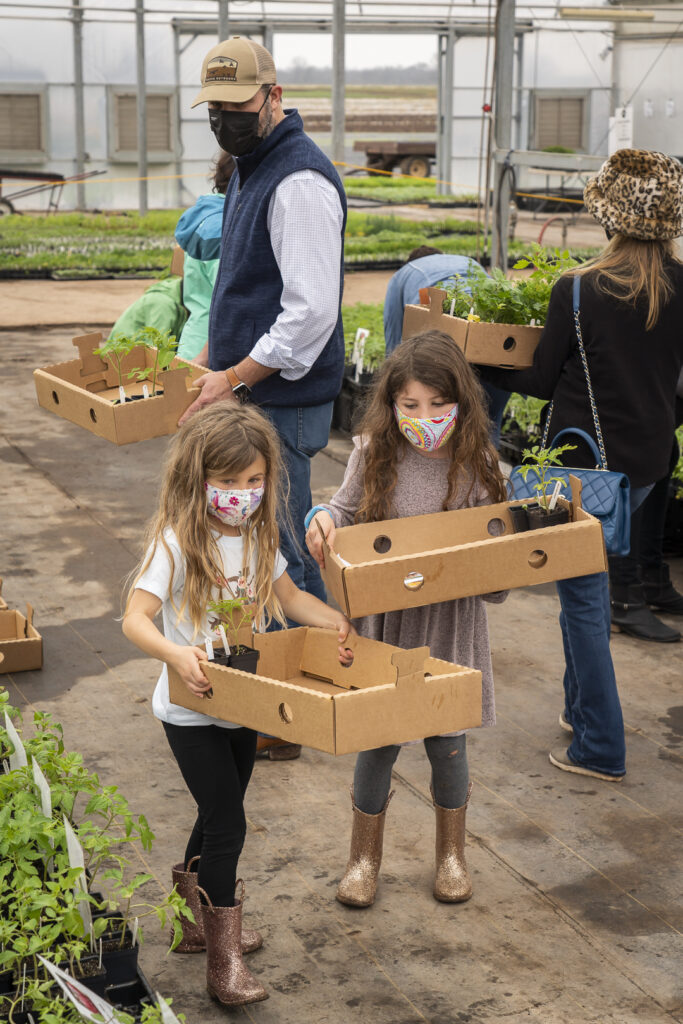 No time like farm time to break out the sparkly rubber boots. Photo by Scott David Gordon.
No time like farm time to break out the sparkly rubber boots. Photo by Scott David Gordon.
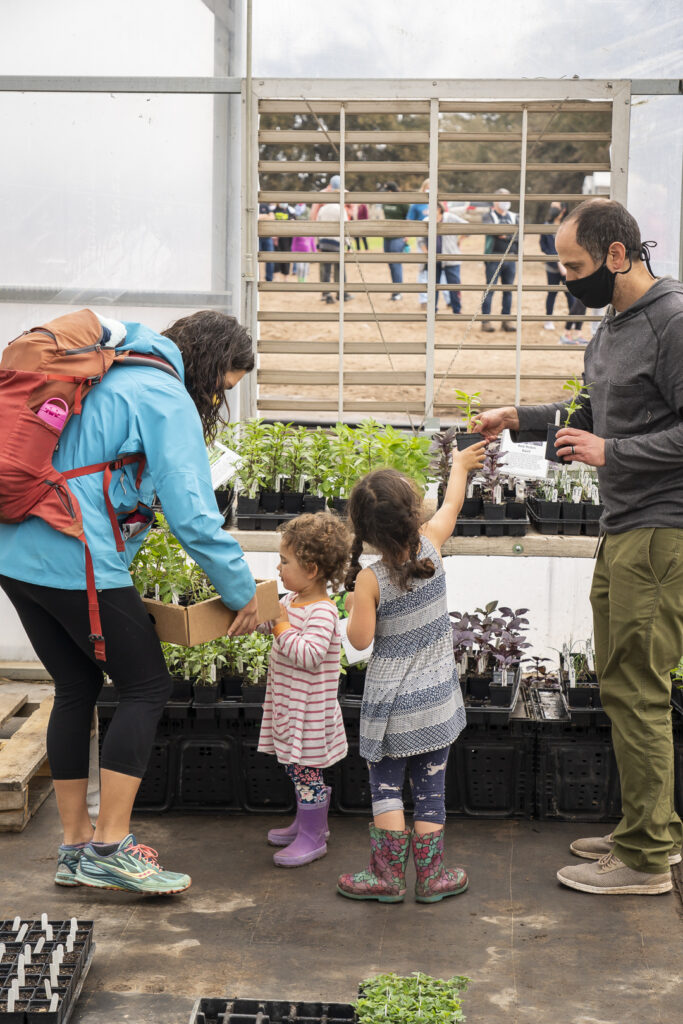 Or precious floral variety. Photo by Scott David Gordon.
Or precious floral variety. Photo by Scott David Gordon.
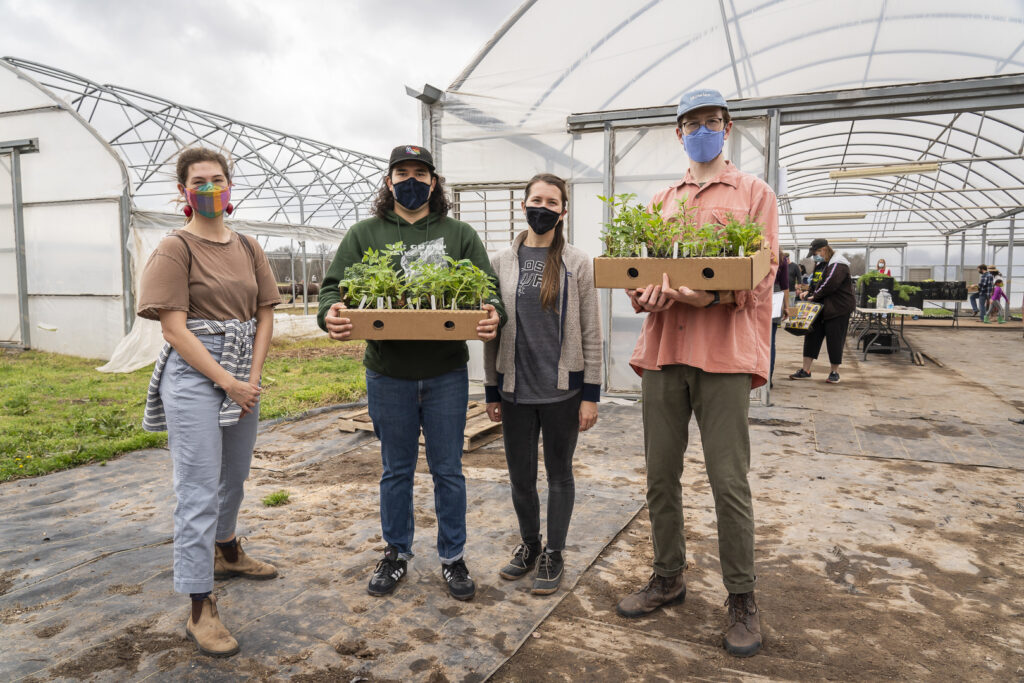 Friends don't let friends garden alone. Photo by Scott David Gordon.
Friends don't let friends garden alone. Photo by Scott David Gordon.
 Did we mention there is lots of room to explore? And a trampoline to jump? Photo by Scott David Gordon.
Did we mention there is lots of room to explore? And a trampoline to jump? Photo by Scott David Gordon.
 And our mountain of a sand pile is just begging for attention. Photo by Scott David Gordon.
And our mountain of a sand pile is just begging for attention. Photo by Scott David Gordon.
 We're keeping the number of people in the greenhouse to a reduced capacity, but if there is a line, it moves super quick! Photo by Scott David Gordon.
We're keeping the number of people in the greenhouse to a reduced capacity, but if there is a line, it moves super quick! Photo by Scott David Gordon.
5 VEGETABLES TO GROW THIS SPRING
03/05/21 — Ada Broussard
Happy Friday!
A few quick housekeeping notes before we dive into this week's post. CSA Members: we have had closed citrus orders until further notice. If you already ordered citrus, we will be honoring those orders, but we are unable to offer additional orders. Like JBG, G&S Groves (where we source the citrus from) is reeling from the recent effects of the winter storm, and their availability of fruit has significantly decreased. Second note for the week: Some of you may have noticed that the online transplant sale is closed. If you already placed an order, it will be delivered to market as planned! If you missed the online ordering, just come on out to the sale and get the full-farm experience! And now onto the post!
Last weekend’s transplant sale was such a success, and we’re so excited for another Saturday of sunshine, community, and lots of eager gardeners. Spring fever is a real thing, and we’ve got it. Do you? The sale is happening on Saturdays from 9 am-1pm at our Garfield, Texas greenhouses: 4008 River Road, 78612. Mask up, and come to the farm!
![]()
Many of you have been asking about the varieties of plants we’ll have at our spring transplant sale. There are many! In fact, we seeded over 100 different vegetables marked specifically for our transplant sale. This includes all the summer favorites like different varieties of slicing tomatoes, cherry tomatoes, and paste tomatoes - perfect for making sauce or canning. On the pepper front, there are a plethora of sweet varieties and a bounty of hot ones… as well as plenty of peppers packing medium spice and lots of flavor. There are other summer stalwarts like melons, cucumbers, squash, and eggplant, as well as endless aisles of herbs - both annual and perennial. If you scroll to the bottom of this page we’ve published a pretty long list of specific varieties that we planted for this year. *This list, however, is just to give you an idea of the types of plants we have - we may sell out of a specific variety, and won’t necessarily be able to keep the page updated… so don’t hold us to it! But! The good thing about our sale is that we truly have a bounty of options. If you had your heart set on growing big, juicy, slicing tomatoes this summer, we’ve got several options for you. We planted over 31 different varieties of tomatoes alone... and that was us practicing restraint! You see, there are many varieties that are near and dear to our farmer-hearts, but that isn’t necessarily suitable for commercial production. In some senses, we live vicariously through your interesting, colorful, and dynamic summer gardens. If you’ve ever flipped through a seed catalog, you know how dazzling the hundreds of pages of thousands of vegetables can be. Lucky for you, Brenton and other farmers at JBG have years of combined experience in variety selection, and we promise you we’re only selling plants we think are well-suited for life in Central Texas.
Without further adieu, here are 5 of our favorite vegetables we think you should grow this spring:![]()
2. Cherokee Purple: It’s our favorite heirloom tomato, plain and simple. Originating from Tenessee, this variety is thought to have been passed down from Native Americans of the Cherokee tribe. The ripe fruit is a beautiful dark dusty pink, with a deep, rich-red interior. The flavor is rich with an unmatched sweetness, perfect for salads or a BLT.
3. Eureka Pickling Cucumber: Uniform, crip fruits that are very green from the earliest stages which makes this cucumber great for pickling when they are 2-5 inches long. Or, you let these fruits grow to maturity (about 7 inches) for an incredible slicing cucumber. We like Eurekas because they’re easy to grow and virtually trouble-free; they’re incredibly disease resistant. These cukes would be happy to climb a trellis or fence for easy harvest and vertical appeal.
![]() Serranos are the red and green peppers pictured in columns two and 4. If you're looking for a little less heat, try a poblano (green pepper pictured) and if you want the full-shebang, go for a habanero (orange).
Serranos are the red and green peppers pictured in columns two and 4. If you're looking for a little less heat, try a poblano (green pepper pictured) and if you want the full-shebang, go for a habanero (orange).
4. Serrano Hot Pepper: If you’re not a fan of spice, maybe skip this recommendation, but if you fancy yourself a hot zing to most dishes, the serrano is for you. Serranos are easy to grow in Texas, and can offer high yields of dark green, finger-sized glossy fruits. Leave the fruit on the vine for a red pepper, if you’d like. Serranos are perfect for all-season enjoyment, and the plants can be very prolific. To boot, the fruit has a long shelf life, making this an ideal plant to save your harvest, and then make a hot sauce, salsa, or fermented pepper mash. They are easy to harvest, and have less sprawl than other peppers, making them more efficient for use in a garden space.
5. Genovese Basil: No summer garden is complete with basil. Genovese is the classic variety, with delicate smooth leaves and a punchy aroma. Basil loves hot weather and does well in a pot, or nestled between tomato plants as a companion. Harvest a few leaves as you needed, or harvest a bunch for a batch of pesto. When grown into maturity, a basil plant will become delightfully bushy, providing an herbal component to meals throughout the summer. And as the summer looms to a close, basil flower will be a wonderful gift for friendly pollinators… or a wonderful sprinkle for a bowl of sliced tomatoes.
![]() A bunch of Genovese basil.
A bunch of Genovese basil.
Other resources: We will be selling farm-grade organic compost at our sale, but if you’re needing mulch, native perennials, flowers, or just some outdoor inspiration we suggest you pay a visit to The Natural Gardener, Tillery Street Plant Co., or The Great Outdoors. If you’re interested in upping your tool-game this season, we recently got a glimpse of our neighbor, Farmshare Austin’s, new hand tools from Easy Digging ... perfect for small-scale farming or committed backyard gardening. If you’re brand new to gardening and feel like you need some support, there are local services like Austin Edible Gardens that can help you plant, plan, and maintain your space. The Wildflower Center usually hosts wonderful classes, and if that doesn’t work for you, Youtube is your friend. Sun, soil, water, and some time. These are all it takes to grow vegetables, and we hope you’ll take the plunge. The rewards are plenty!
![]() Ennie, meenie, miney, mo. You can't really go wrong with any of the varieties in our greenhouse. We planted them all, just for you!
Ennie, meenie, miney, mo. You can't really go wrong with any of the varieties in our greenhouse. We planted them all, just for you!
A few quick housekeeping notes before we dive into this week's post. CSA Members: we have had closed citrus orders until further notice. If you already ordered citrus, we will be honoring those orders, but we are unable to offer additional orders. Like JBG, G&S Groves (where we source the citrus from) is reeling from the recent effects of the winter storm, and their availability of fruit has significantly decreased. Second note for the week: Some of you may have noticed that the online transplant sale is closed. If you already placed an order, it will be delivered to market as planned! If you missed the online ordering, just come on out to the sale and get the full-farm experience! And now onto the post!
Last weekend’s transplant sale was such a success, and we’re so excited for another Saturday of sunshine, community, and lots of eager gardeners. Spring fever is a real thing, and we’ve got it. Do you? The sale is happening on Saturdays from 9 am-1pm at our Garfield, Texas greenhouses: 4008 River Road, 78612. Mask up, and come to the farm!

Many of you have been asking about the varieties of plants we’ll have at our spring transplant sale. There are many! In fact, we seeded over 100 different vegetables marked specifically for our transplant sale. This includes all the summer favorites like different varieties of slicing tomatoes, cherry tomatoes, and paste tomatoes - perfect for making sauce or canning. On the pepper front, there are a plethora of sweet varieties and a bounty of hot ones… as well as plenty of peppers packing medium spice and lots of flavor. There are other summer stalwarts like melons, cucumbers, squash, and eggplant, as well as endless aisles of herbs - both annual and perennial. If you scroll to the bottom of this page we’ve published a pretty long list of specific varieties that we planted for this year. *This list, however, is just to give you an idea of the types of plants we have - we may sell out of a specific variety, and won’t necessarily be able to keep the page updated… so don’t hold us to it! But! The good thing about our sale is that we truly have a bounty of options. If you had your heart set on growing big, juicy, slicing tomatoes this summer, we’ve got several options for you. We planted over 31 different varieties of tomatoes alone... and that was us practicing restraint! You see, there are many varieties that are near and dear to our farmer-hearts, but that isn’t necessarily suitable for commercial production. In some senses, we live vicariously through your interesting, colorful, and dynamic summer gardens. If you’ve ever flipped through a seed catalog, you know how dazzling the hundreds of pages of thousands of vegetables can be. Lucky for you, Brenton and other farmers at JBG have years of combined experience in variety selection, and we promise you we’re only selling plants we think are well-suited for life in Central Texas.
Without further adieu, here are 5 of our favorite vegetables we think you should grow this spring:
- Lunchbox Pepper: Part of the joy of a backyard garden is being able to pluck a fruit, right off a plant, and eat it. Lunchbox peppers, and their indubitable snackability, fit this profile. They are sweet and crunchy, with loads of beta-carotene. Plants tend to give high yields. If planting in a windy location, consider staking with a tomato cage to prevent the stems from breaking. This plant is perfect for a large, 18-inch pot, as well!
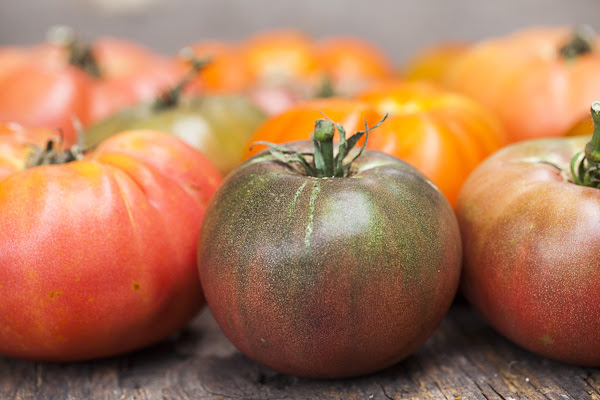
2. Cherokee Purple: It’s our favorite heirloom tomato, plain and simple. Originating from Tenessee, this variety is thought to have been passed down from Native Americans of the Cherokee tribe. The ripe fruit is a beautiful dark dusty pink, with a deep, rich-red interior. The flavor is rich with an unmatched sweetness, perfect for salads or a BLT.
3. Eureka Pickling Cucumber: Uniform, crip fruits that are very green from the earliest stages which makes this cucumber great for pickling when they are 2-5 inches long. Or, you let these fruits grow to maturity (about 7 inches) for an incredible slicing cucumber. We like Eurekas because they’re easy to grow and virtually trouble-free; they’re incredibly disease resistant. These cukes would be happy to climb a trellis or fence for easy harvest and vertical appeal.
 Serranos are the red and green peppers pictured in columns two and 4. If you're looking for a little less heat, try a poblano (green pepper pictured) and if you want the full-shebang, go for a habanero (orange).
Serranos are the red and green peppers pictured in columns two and 4. If you're looking for a little less heat, try a poblano (green pepper pictured) and if you want the full-shebang, go for a habanero (orange).
4. Serrano Hot Pepper: If you’re not a fan of spice, maybe skip this recommendation, but if you fancy yourself a hot zing to most dishes, the serrano is for you. Serranos are easy to grow in Texas, and can offer high yields of dark green, finger-sized glossy fruits. Leave the fruit on the vine for a red pepper, if you’d like. Serranos are perfect for all-season enjoyment, and the plants can be very prolific. To boot, the fruit has a long shelf life, making this an ideal plant to save your harvest, and then make a hot sauce, salsa, or fermented pepper mash. They are easy to harvest, and have less sprawl than other peppers, making them more efficient for use in a garden space.
5. Genovese Basil: No summer garden is complete with basil. Genovese is the classic variety, with delicate smooth leaves and a punchy aroma. Basil loves hot weather and does well in a pot, or nestled between tomato plants as a companion. Harvest a few leaves as you needed, or harvest a bunch for a batch of pesto. When grown into maturity, a basil plant will become delightfully bushy, providing an herbal component to meals throughout the summer. And as the summer looms to a close, basil flower will be a wonderful gift for friendly pollinators… or a wonderful sprinkle for a bowl of sliced tomatoes.
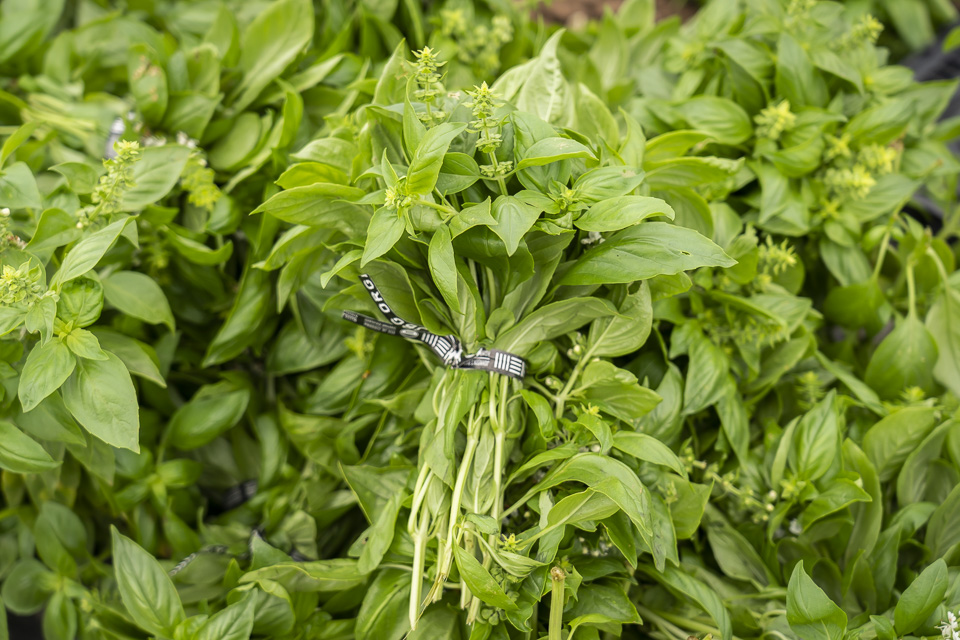 A bunch of Genovese basil.
A bunch of Genovese basil.
Other resources: We will be selling farm-grade organic compost at our sale, but if you’re needing mulch, native perennials, flowers, or just some outdoor inspiration we suggest you pay a visit to The Natural Gardener, Tillery Street Plant Co., or The Great Outdoors. If you’re interested in upping your tool-game this season, we recently got a glimpse of our neighbor, Farmshare Austin’s, new hand tools from Easy Digging ... perfect for small-scale farming or committed backyard gardening. If you’re brand new to gardening and feel like you need some support, there are local services like Austin Edible Gardens that can help you plant, plan, and maintain your space. The Wildflower Center usually hosts wonderful classes, and if that doesn’t work for you, Youtube is your friend. Sun, soil, water, and some time. These are all it takes to grow vegetables, and we hope you’ll take the plunge. The rewards are plenty!
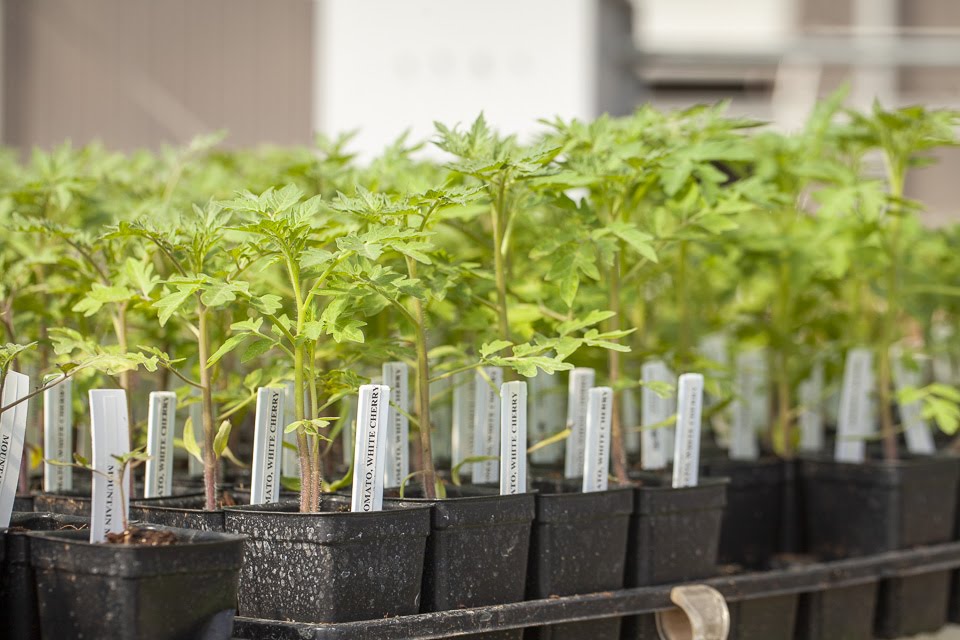 Ennie, meenie, miney, mo. You can't really go wrong with any of the varieties in our greenhouse. We planted them all, just for you!
Ennie, meenie, miney, mo. You can't really go wrong with any of the varieties in our greenhouse. We planted them all, just for you!BAKED CARROT CAKE OATMEAL
03/11/21 — Ada Broussard
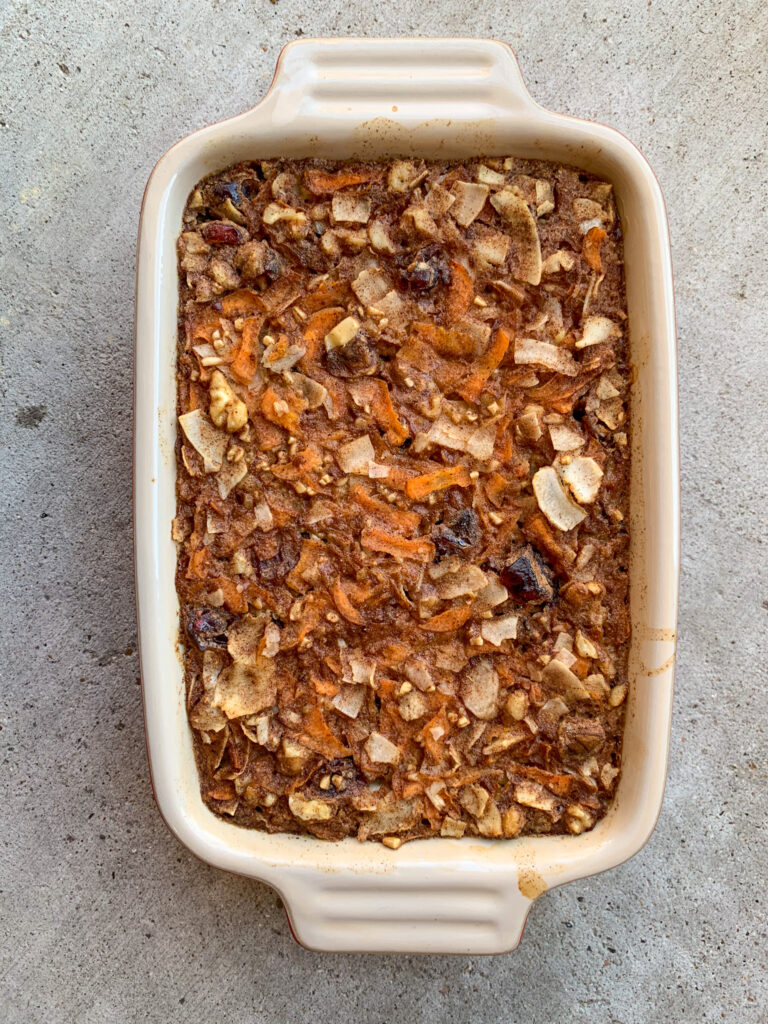 Baked Carrot Cake Oatmeal. Photo by The Migoni Kitchen.
Baked Carrot Cake Oatmeal. Photo by The Migoni Kitchen.
Author: The Migoni Kitchen
Carrots are so versatile we often forget that they are great for sweet AND savory dishes. With spring around the corner, we thought what better way to use carrots than in carrot cake! But wanting to keep things on the lighter side, we opted to create some carrot cake flavored oats for a healthy and delicious breakfast. Baking the oatmeal gives a slightly different texture that we loved. Perfect for a Saturday morning breakfast.
Serves 2 people
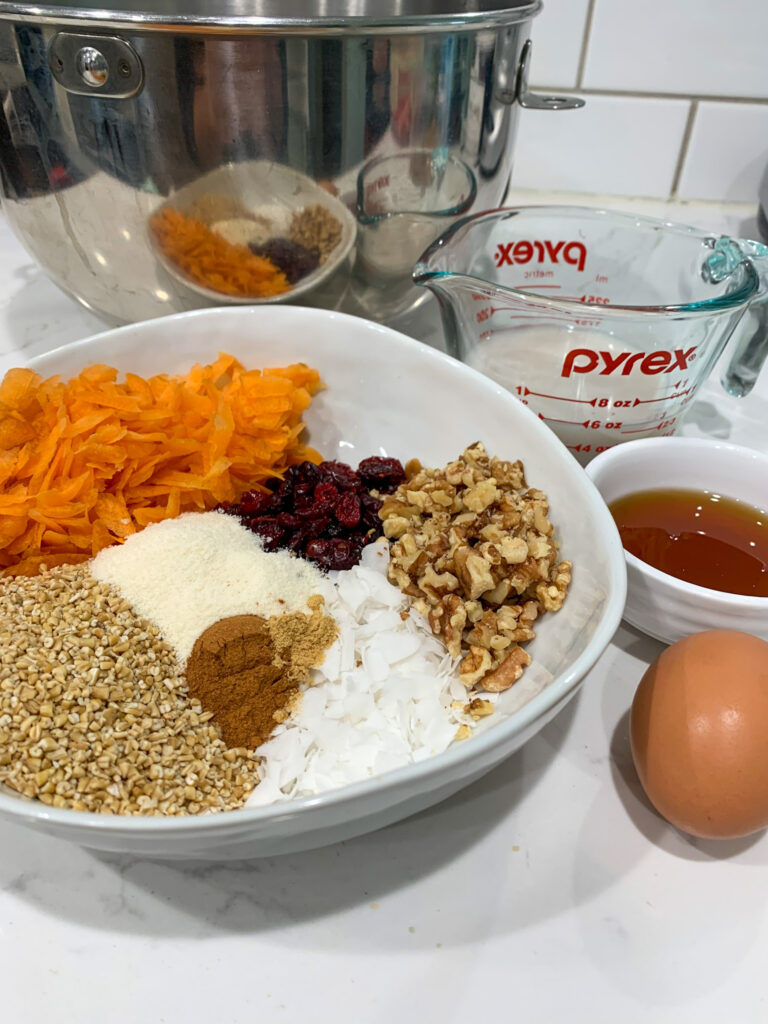 Carrot-oatmeal mise en place. Photo by The Migoni Kitchen.
Carrot-oatmeal mise en place. Photo by The Migoni Kitchen.
Ingredients:
- 2 medium carrots, grated
- ¼ cup dried cranberries
- ¼ cup crushed walnuts
- ¼ cup shaved coconut
- ½ cup steel cut oats
- 1 scoop protein powder of choice (optional)
- 1 teaspoon baking powder
- 1 egg
- 3 tablespoons maple syrup
- ⅔ cup vanilla almond milk
- ½ teaspoon cinnamon
- ¼ teaspoon dried ginger
- Preheat the oven to 350F
- Whisk together the milk, egg, and maple syrup in a large bowl.
- Add in the remaining dry ingredients and stir to combine.
- Pour into a small casserole dish (we used one that’s 7x4.5 in) or a loaf pan (reduce cook time to 25-30 minutes).
- Bake for 30-35 minutes or until liquid has absorbed and oats are tender.
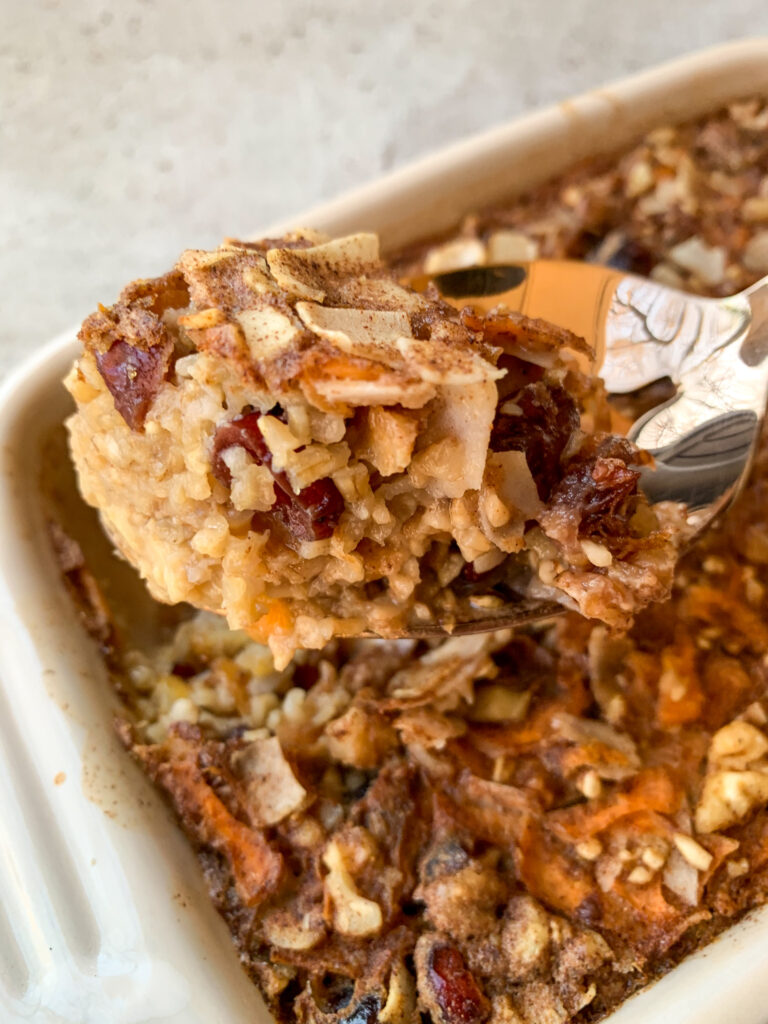 The perfect bite. Photo by The Migoni Kitchen.
The perfect bite. Photo by The Migoni Kitchen.BEETS: THE UNDERDOG OF THE UNDERWORLD
03/12/21 — Ada Broussard
Beets. They can feel divisive, at times. For the farm, they’re a wonderful storage crop that is relatively easy to grow. They have a long growing season and do well in spring, winter, and fall.
We consider these sweet and starchy roots a wonderful staple that can work their way into dishes both sweet and savory. They’re dense, and like a potato, can serve as a meal’s foundation, an anchor vegetable to which herbs, sauces, and cheese are sprinkled. But we’re farmers, and we were born to love each and every one of our vegetables, equally. We adore beets, but know that some of you are experiencing a case of beet-fatigue. We hope this week’s blog post will help solve your woes, and that the beets bouncing around the bottom of your CSA box will delight you.
![]()
VARIETIES & COLOR
Beets are in a group of plants commonly referred to as the “goosefoot” family. They share this distinction with crops like chard, amaranth, spinach, and even quinoa, and are nicknamed as such because the leaves are said to resemble goose feet. You be the judge. Here at JBG, we grow three types of beets: red beets, golden beets, and the candy cane striped Chioga beets. Deep scarlet red beets get their rich hues from very special pigments, called betalains, which are unlike the color-causing molecules in most plants. Evolutionarily, these pigments are different from what makes a tomato or bell pepper red, and leave scientists scratching their heads as to why, exactly, beets are so richly red. Fun fact: check the label on red food products like tomato paste, jams, jellies, and even strawberry ice cream. Most of these commercially-produced products rely on beet’s betalains to achieve a dark red or pink hue.
![]() A 365 day project of unique panorama photos by Austin photographer Scott David Gordon
A 365 day project of unique panorama photos by Austin photographer Scott David Gordon
Another interesting feature of beets are the rings which you can see when slicing through the bulb. The darkest rings are the vascular tissue of the beets - structures called xylem and phloem. Xylem is responsible for transporting water and nutrients from the soil into the beet, and phloem is responsible for carrying sugars from the leaves. The lighter rings visible in beets are simply storage tissues, and in the case of beets, they’re storing lots of sugar. Beets are one of the sweetest vegetables around, and there is even a type of beet called a sugar beet that is grown specifically to produce sugar. In fact, over half of the world’s refined sugar is made from beets!
NUTRITION
When beets were first domesticated, the leaves were consumed for food, and the roots as medicine. Which makes sense, because beetroots are just zinging with nutrition. Beetroots have an impressive amount of vitamins and minerals. A single serving of beets contains a healthy dose (2 grams) of fiber as well as Vitamin C, B6, Folate, Magnesium, Potassium, Phosphorous, Manganese, and Iron. Nutrition experts claim beets can help reduce blood pressure, improve athletic performance, fight inflammation, improve digestive health, support brain health, and so much more.
RECIPES
Beets are often described as “earthy” tasting which can be attributed to a compound called geosmin (which means “dirt smell”). For some, this dirt-taste is a delicasey. For others, it can be off-putting. In her article “The Beet Goes On”, botanist Katherine Preston, PhD, poses a good question: “There are many scents and flavors that attract or repel, depending on their context. Parmesan cheese smells like vomit, white pepper smells like wet dog, and expensive Italian truffles smell like feet. Geosmin flavor in water or wine is off-putting because it indicates contamination (harmless as it may be), but we love it after a gentle rain because it belongs there. Beet lovers welcome geosmin as a normal flavor component of beets. Do beet haters, by contrast, attribute it to something unhealthy?”
Below are some recipes, both in and out of the box, to help you adore your beets.
![]()
Beet Hummus: Beets can make a wonderful anchor to an entire meal, but they can also be foundational as a snack. Enter: beet hummus. There are a dozen ways to blitz roasted beets and make the vegetable into a dippable, spreadable snack. Optional ingredients include things like yogurt, tahini, chickpeas, and herbs.
Beet Chips: Since we’re on the snack train, why not make chips out of your beets, and then use these as vessels for regular-hummus? Or dip beet chips in beet-hummus if you’re looking for full immersion.
![]()
Beet Kvas:
Beet Kvas is an easy-to make fermented beet beverage. This salty, sour, and sweet beverage is perfect on its own, taken as a post-workout shot, mixed into a cocktail, or even stirred with sparkling water. If you’re looking for a quick, no-frills recipe to use those beets, look no further.
Beet Ketchup A bounty of beets can be preserved in the form of ketchup - a perfectly dippy alternative to tomato-ketchup, there to tide you over as you anxiously await the summer fruit.
![]()
Chocolate Beet Cupcakes Just trust us. You’ll never look back.
![]()
Beet Salad There are endless options that play off the classic combination of roasted beets, a tangy cheese, good olive oil and herbs. This version includes citrus. Additions like fennel, onions, herbs, nuts, and cooked grains are all wonderful ways to build a salad around roasted beets.
![]() All Rights Reserved
All Rights Reserved
Fried Beets This recipe is really a story about a fried-beet-failure, but the story includes links to actual fried beet recipes. Breaded and fried beets + creamy dip = heavily snack even for the most skeptical consumer.
For more beet recipes, checkout our recipe archive. And don’t forget about the leaves!
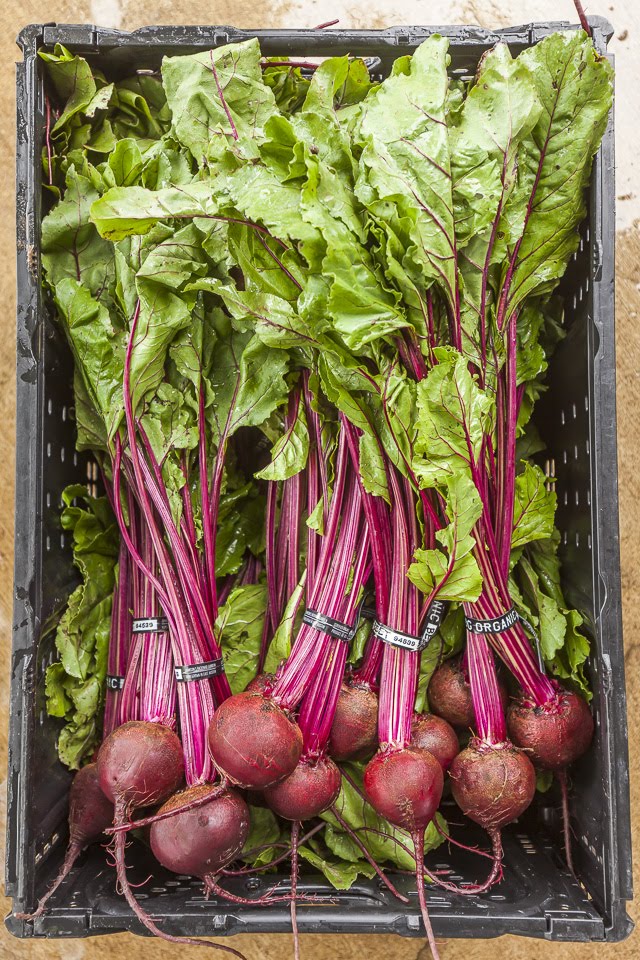
VARIETIES & COLOR
Beets are in a group of plants commonly referred to as the “goosefoot” family. They share this distinction with crops like chard, amaranth, spinach, and even quinoa, and are nicknamed as such because the leaves are said to resemble goose feet. You be the judge. Here at JBG, we grow three types of beets: red beets, golden beets, and the candy cane striped Chioga beets. Deep scarlet red beets get their rich hues from very special pigments, called betalains, which are unlike the color-causing molecules in most plants. Evolutionarily, these pigments are different from what makes a tomato or bell pepper red, and leave scientists scratching their heads as to why, exactly, beets are so richly red. Fun fact: check the label on red food products like tomato paste, jams, jellies, and even strawberry ice cream. Most of these commercially-produced products rely on beet’s betalains to achieve a dark red or pink hue.
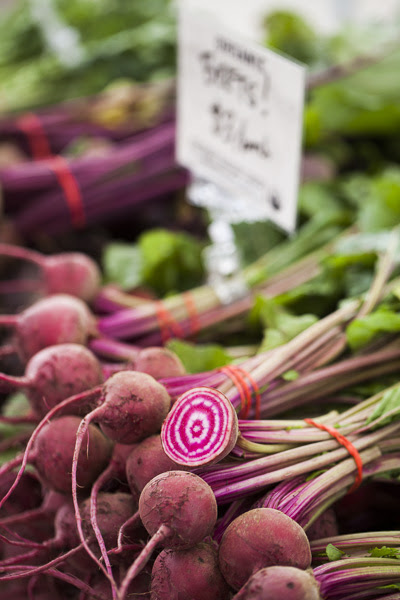 A 365 day project of unique panorama photos by Austin photographer Scott David Gordon
A 365 day project of unique panorama photos by Austin photographer Scott David Gordon
Another interesting feature of beets are the rings which you can see when slicing through the bulb. The darkest rings are the vascular tissue of the beets - structures called xylem and phloem. Xylem is responsible for transporting water and nutrients from the soil into the beet, and phloem is responsible for carrying sugars from the leaves. The lighter rings visible in beets are simply storage tissues, and in the case of beets, they’re storing lots of sugar. Beets are one of the sweetest vegetables around, and there is even a type of beet called a sugar beet that is grown specifically to produce sugar. In fact, over half of the world’s refined sugar is made from beets!
NUTRITION
When beets were first domesticated, the leaves were consumed for food, and the roots as medicine. Which makes sense, because beetroots are just zinging with nutrition. Beetroots have an impressive amount of vitamins and minerals. A single serving of beets contains a healthy dose (2 grams) of fiber as well as Vitamin C, B6, Folate, Magnesium, Potassium, Phosphorous, Manganese, and Iron. Nutrition experts claim beets can help reduce blood pressure, improve athletic performance, fight inflammation, improve digestive health, support brain health, and so much more.
RECIPES
Beets are often described as “earthy” tasting which can be attributed to a compound called geosmin (which means “dirt smell”). For some, this dirt-taste is a delicasey. For others, it can be off-putting. In her article “The Beet Goes On”, botanist Katherine Preston, PhD, poses a good question: “There are many scents and flavors that attract or repel, depending on their context. Parmesan cheese smells like vomit, white pepper smells like wet dog, and expensive Italian truffles smell like feet. Geosmin flavor in water or wine is off-putting because it indicates contamination (harmless as it may be), but we love it after a gentle rain because it belongs there. Beet lovers welcome geosmin as a normal flavor component of beets. Do beet haters, by contrast, attribute it to something unhealthy?”
Below are some recipes, both in and out of the box, to help you adore your beets.
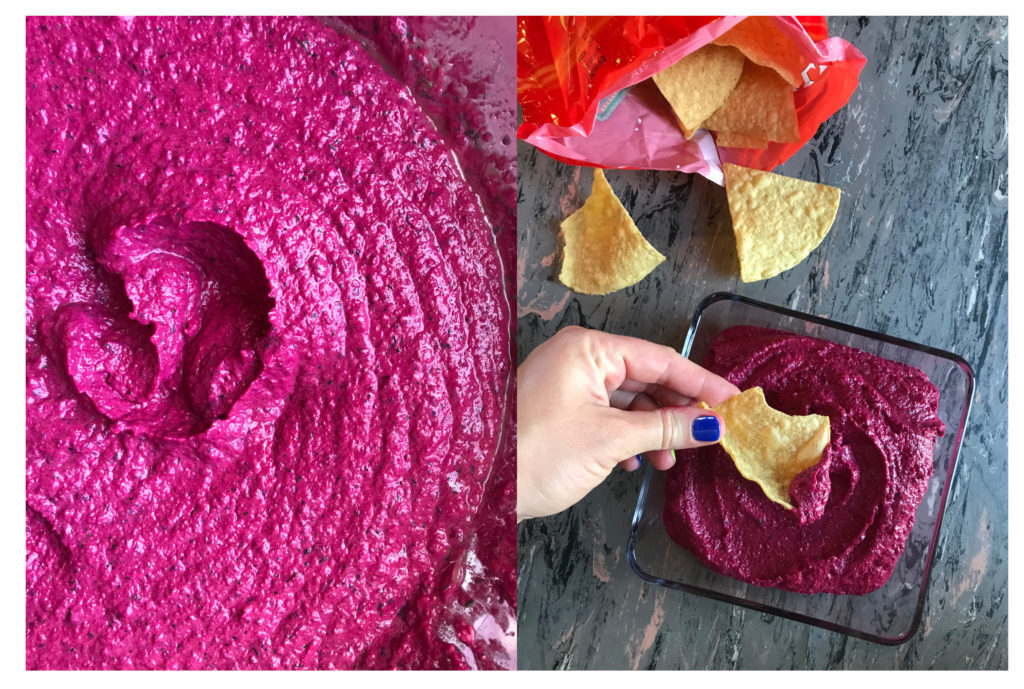
Beet Hummus: Beets can make a wonderful anchor to an entire meal, but they can also be foundational as a snack. Enter: beet hummus. There are a dozen ways to blitz roasted beets and make the vegetable into a dippable, spreadable snack. Optional ingredients include things like yogurt, tahini, chickpeas, and herbs.
Beet Chips: Since we’re on the snack train, why not make chips out of your beets, and then use these as vessels for regular-hummus? Or dip beet chips in beet-hummus if you’re looking for full immersion.
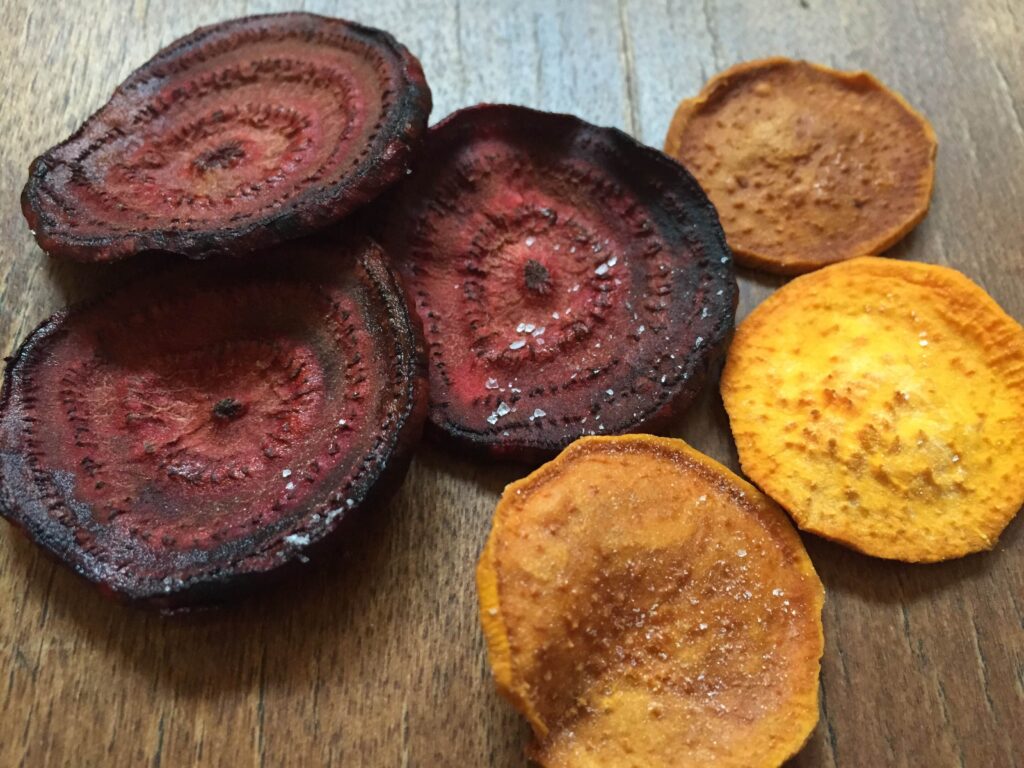
Beet Kvas:
Beet Kvas is an easy-to make fermented beet beverage. This salty, sour, and sweet beverage is perfect on its own, taken as a post-workout shot, mixed into a cocktail, or even stirred with sparkling water. If you’re looking for a quick, no-frills recipe to use those beets, look no further.
Beet Ketchup A bounty of beets can be preserved in the form of ketchup - a perfectly dippy alternative to tomato-ketchup, there to tide you over as you anxiously await the summer fruit.
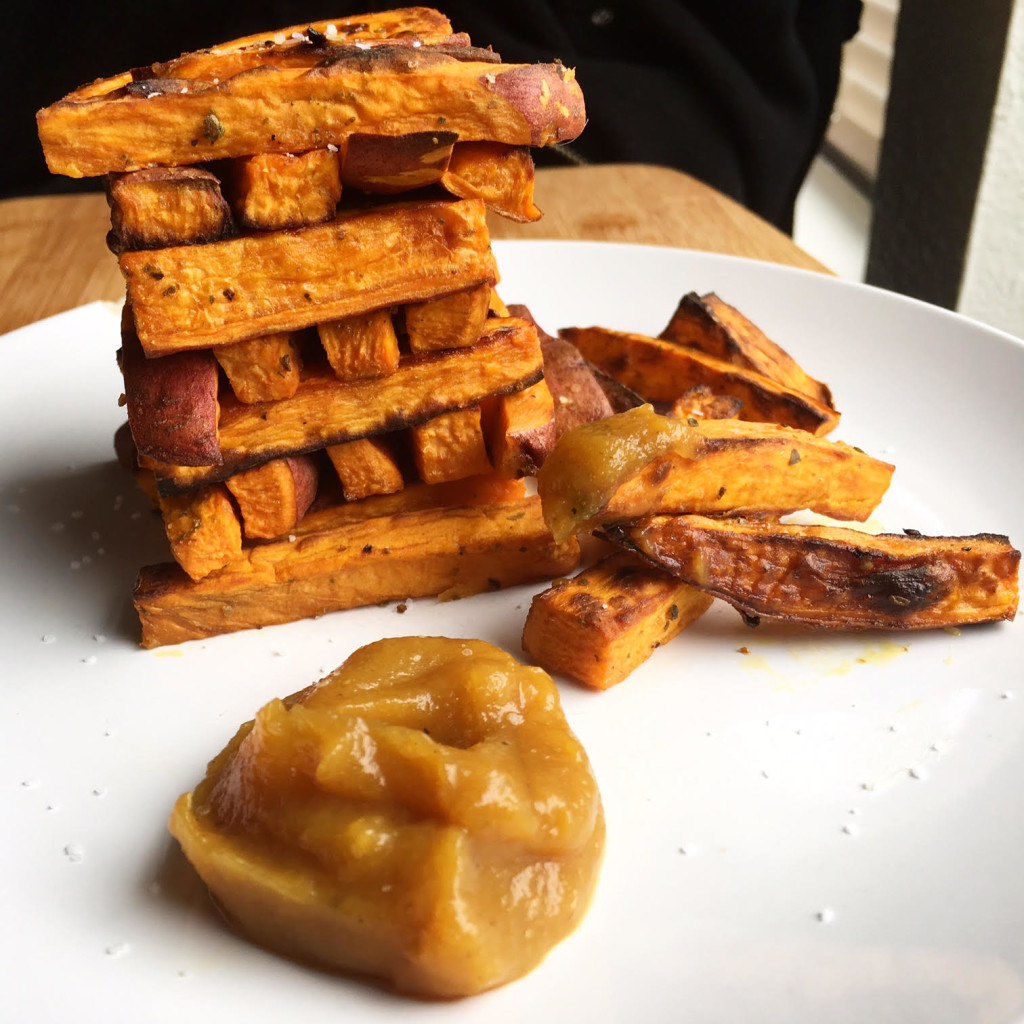
Chocolate Beet Cupcakes Just trust us. You’ll never look back.

Beet Salad There are endless options that play off the classic combination of roasted beets, a tangy cheese, good olive oil and herbs. This version includes citrus. Additions like fennel, onions, herbs, nuts, and cooked grains are all wonderful ways to build a salad around roasted beets.
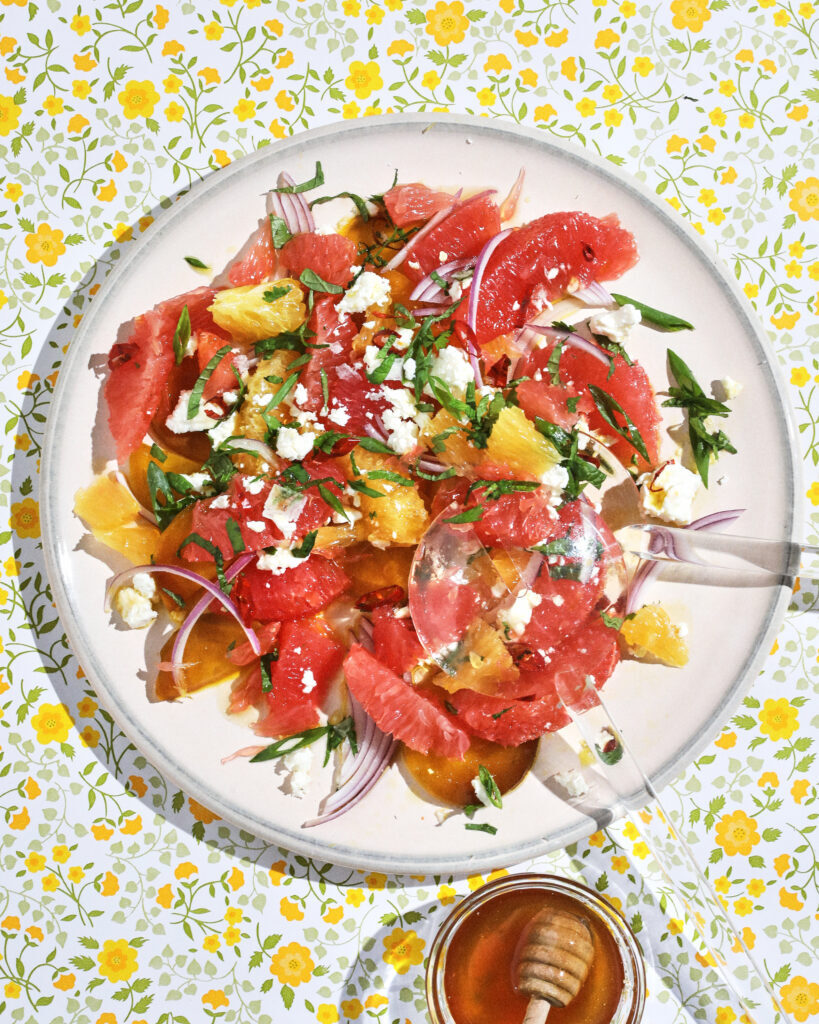 All Rights Reserved
All Rights Reserved
Fried Beets This recipe is really a story about a fried-beet-failure, but the story includes links to actual fried beet recipes. Breaded and fried beets + creamy dip = heavily snack even for the most skeptical consumer.
For more beet recipes, checkout our recipe archive. And don’t forget about the leaves!
PHOTOS FROM THE FARM: 3.10.21
03/12/21 — Ada Broussard
Very suddenly, it seems like acres of reminders of the winter storm have vanished. We've cleaned up just about every field of dead crops, the mushy leaves mowed, pulverized, and then turned into the soil adding organic matter back into the ground. Many of these beds have already been replanted, and many more will be replanted soon. Believe it or not, there are certain areas of the farm that are still too wet to work the soil, and we're waiting until they dry out a bit more to work the beds and get new crops planted. Memories of ice and snow feel distant, and we are fully engrossed in all-things spring. This week we planted tomatoes, cucumbers, eggplant, and peppers! Our Transplant Sale is still happening every Saturday from 9 am-1 pm at our Garfield, Texas greenhouses and we are SO grateful to everyone who has visited. We re-arranged the greenhouse a bit and have made for a more streamlined shopping experience. Here is an Instagram video where we give a tour of the sale. In addition to transplants, we are also setting up a market stand at the sale so you can snag your transplants and weekly vegetables. We are really enjoying having visitors out to the farm on Saturdays, and this year's Transplant Sale has us dreaming of setting up a more permanent "market stand" at the Garfield farm because really, is there any place to get your veggies that from the farm itself? Hope you'll join us this weekend. Don some sneakers, and walk the fields! It's beautiful out there!
![]() The green onions are looking green again! Photo by Scott David Gordon.
The green onions are looking green again! Photo by Scott David Gordon.
![]() Green garlic - use the green and white parts of this baby-garlic for a mild, sweet, garlicy punch. Photo by Scott David Gordon.
Green garlic - use the green and white parts of this baby-garlic for a mild, sweet, garlicy punch. Photo by Scott David Gordon.
![]() Before we are ready to get on the tractor and transplanter, we "pop" the cells trays of the baby plants. We use slender wooden dowels and gently push up through the drainage hole that is at the bottom of each plant. Photo by Scott David Gordon.
Before we are ready to get on the tractor and transplanter, we "pop" the cells trays of the baby plants. We use slender wooden dowels and gently push up through the drainage hole that is at the bottom of each plant. Photo by Scott David Gordon.
![]() Cucumbers are ready to roll. Photo by Scott David Gordon.
Cucumbers are ready to roll. Photo by Scott David Gordon.
![]() Each plastic cell tray holds 128 plants. Photo by Scott David Gordon.
Each plastic cell tray holds 128 plants. Photo by Scott David Gordon.
![]() Freshly planted. Photo by Scott David Gordon.
Freshly planted. Photo by Scott David Gordon.
![]() Farm manager Jack is giving the thumbs up. Wheels, water, hands.... it's all working as it should. Photo by Scott David Gordon.
Farm manager Jack is giving the thumbs up. Wheels, water, hands.... it's all working as it should. Photo by Scott David Gordon.
![]() Checkout those lines. Photo by Scott David Gordon.
Checkout those lines. Photo by Scott David Gordon.
![]() Harvest manager Vicente checking out the carrot progress. Photo by Scott David Gordon.
Harvest manager Vicente checking out the carrot progress. Photo by Scott David Gordon.
![]() Cover crop seed going in the ground. Photo by Scott David Gordon.
Cover crop seed going in the ground. Photo by Scott David Gordon.
![]() Ada showing off an oregano transplant. Photo by Scott David Gordon.
Ada showing off an oregano transplant. Photo by Scott David Gordon.
![]() Ada and Adam checking out the herb inventory. Photo by Scott David Gordon.
Ada and Adam checking out the herb inventory. Photo by Scott David Gordon.
![]() Views from inside the greenhouse. Photo by Scott David Gordon.
Views from inside the greenhouse. Photo by Scott David Gordon.
![]() Successions of tomato transplants ready to go for the transplant sale. Photo by Scott David Gordon.
Successions of tomato transplants ready to go for the transplant sale. Photo by Scott David Gordon.
![]() The man behind the lens! We turned the camera on Scott this week, shown smiling in front of some cover crop. Photo by Scott David Gordon.
The man behind the lens! We turned the camera on Scott this week, shown smiling in front of some cover crop. Photo by Scott David Gordon.
![]() Giana and Ada chatting about transplants. Photo by Scott David Gordon.
Giana and Ada chatting about transplants. Photo by Scott David Gordon.
![]() Green leaf lettuce was one of the first crops we transplanted after the storm. They're sizing up nicely! Photo by Scott David Gordon.
Green leaf lettuce was one of the first crops we transplanted after the storm. They're sizing up nicely! Photo by Scott David Gordon.
![]() Baby, baby bok choy. Photo by Scott David Gordon.
Baby, baby bok choy. Photo by Scott David Gordon.
![]() Krishna, Angel, and Jack in a parking lot meeting, dreaming about a new tractor.
Krishna, Angel, and Jack in a parking lot meeting, dreaming about a new tractor.
 The green onions are looking green again! Photo by Scott David Gordon.
The green onions are looking green again! Photo by Scott David Gordon.
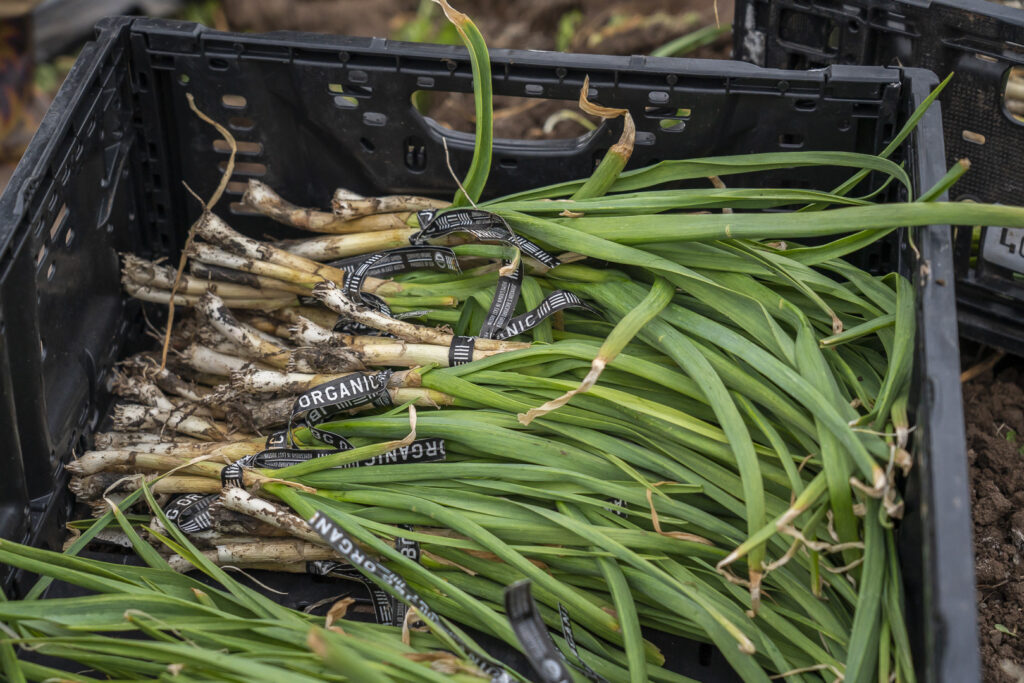 Green garlic - use the green and white parts of this baby-garlic for a mild, sweet, garlicy punch. Photo by Scott David Gordon.
Green garlic - use the green and white parts of this baby-garlic for a mild, sweet, garlicy punch. Photo by Scott David Gordon.
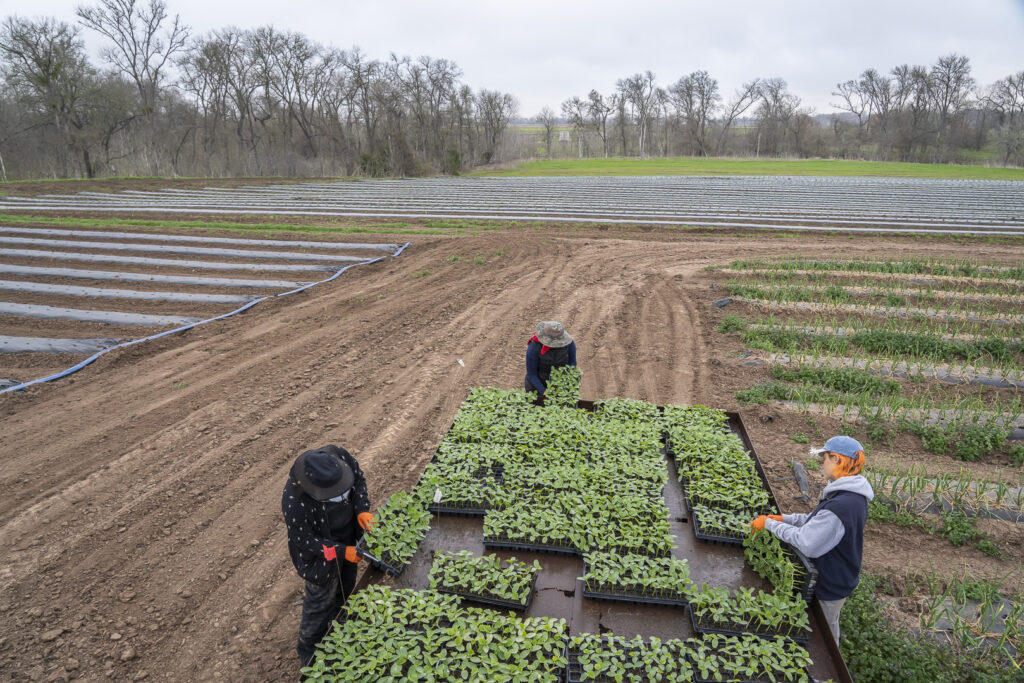 Before we are ready to get on the tractor and transplanter, we "pop" the cells trays of the baby plants. We use slender wooden dowels and gently push up through the drainage hole that is at the bottom of each plant. Photo by Scott David Gordon.
Before we are ready to get on the tractor and transplanter, we "pop" the cells trays of the baby plants. We use slender wooden dowels and gently push up through the drainage hole that is at the bottom of each plant. Photo by Scott David Gordon.
 Cucumbers are ready to roll. Photo by Scott David Gordon.
Cucumbers are ready to roll. Photo by Scott David Gordon.
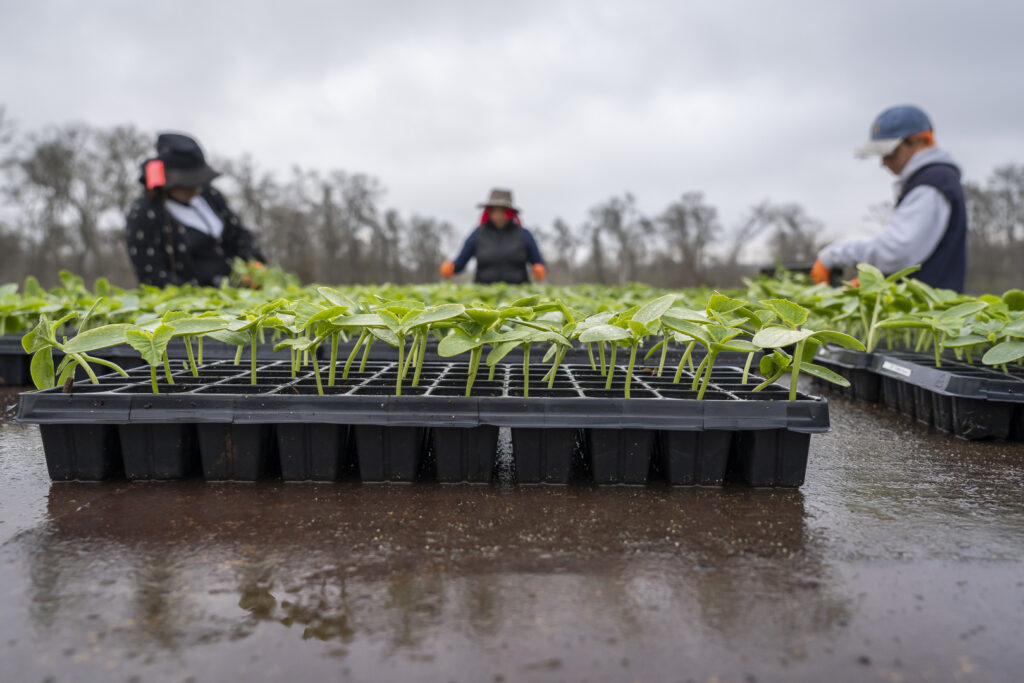 Each plastic cell tray holds 128 plants. Photo by Scott David Gordon.
Each plastic cell tray holds 128 plants. Photo by Scott David Gordon.
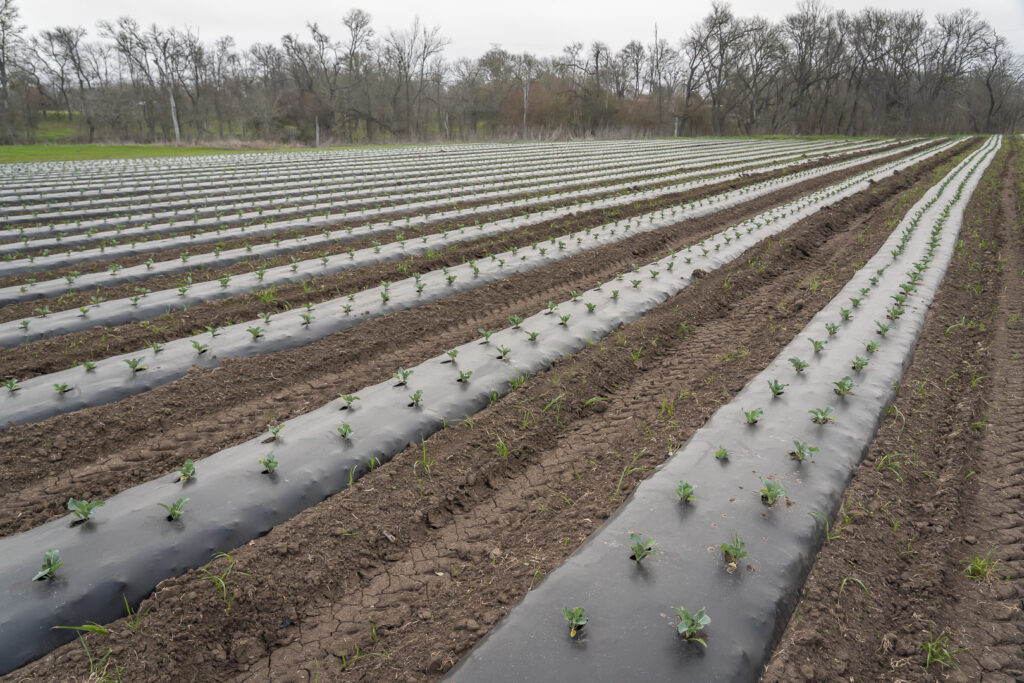 Freshly planted. Photo by Scott David Gordon.
Freshly planted. Photo by Scott David Gordon.
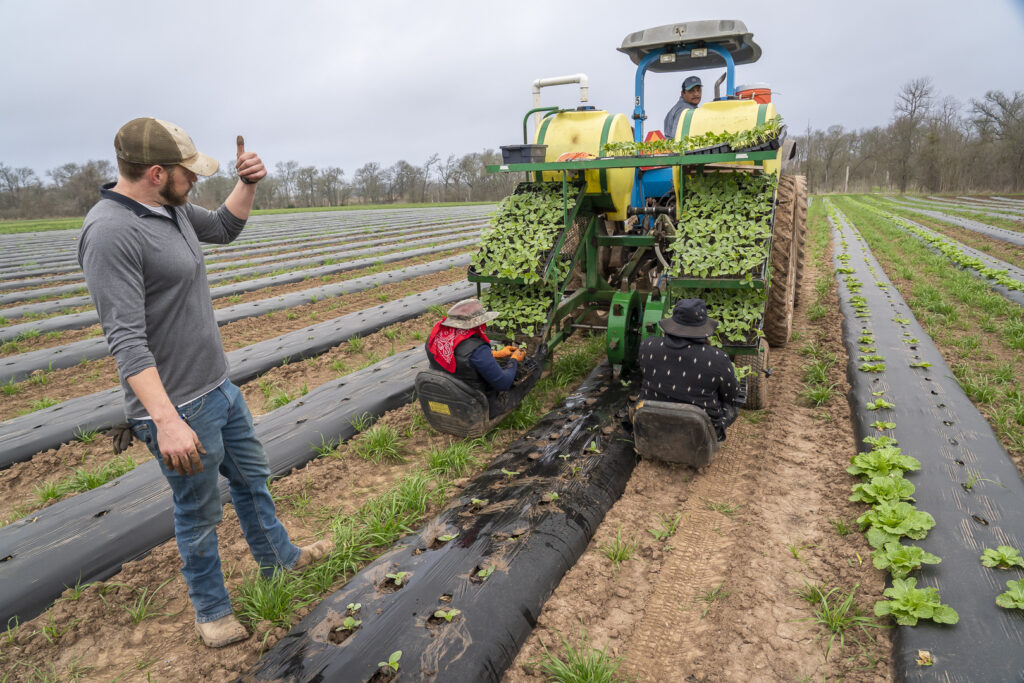 Farm manager Jack is giving the thumbs up. Wheels, water, hands.... it's all working as it should. Photo by Scott David Gordon.
Farm manager Jack is giving the thumbs up. Wheels, water, hands.... it's all working as it should. Photo by Scott David Gordon.
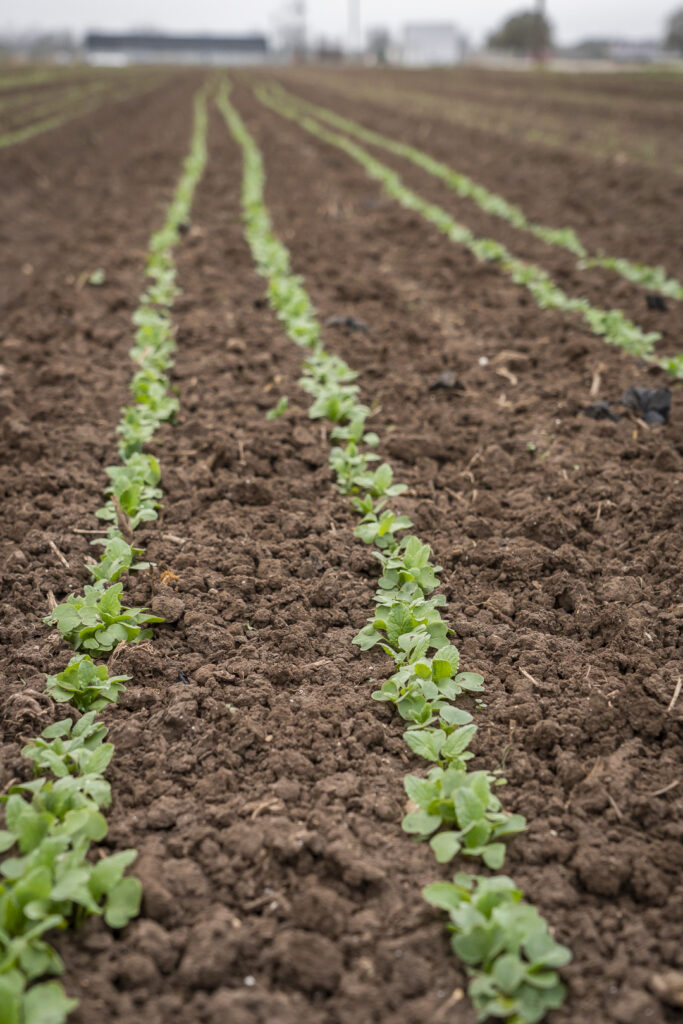 Checkout those lines. Photo by Scott David Gordon.
Checkout those lines. Photo by Scott David Gordon.
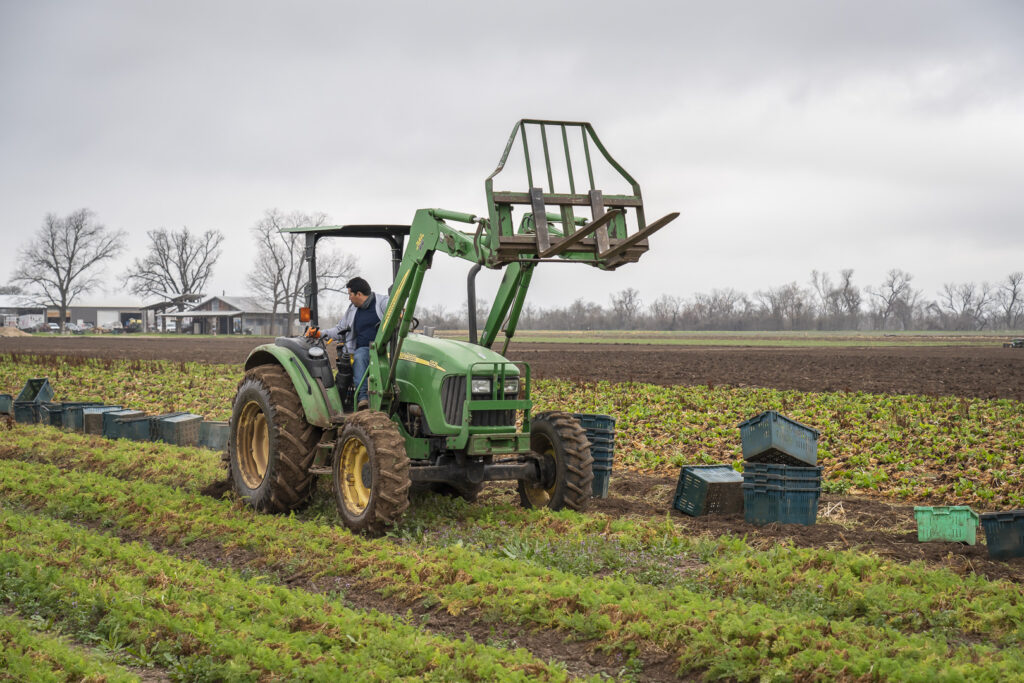 Harvest manager Vicente checking out the carrot progress. Photo by Scott David Gordon.
Harvest manager Vicente checking out the carrot progress. Photo by Scott David Gordon.
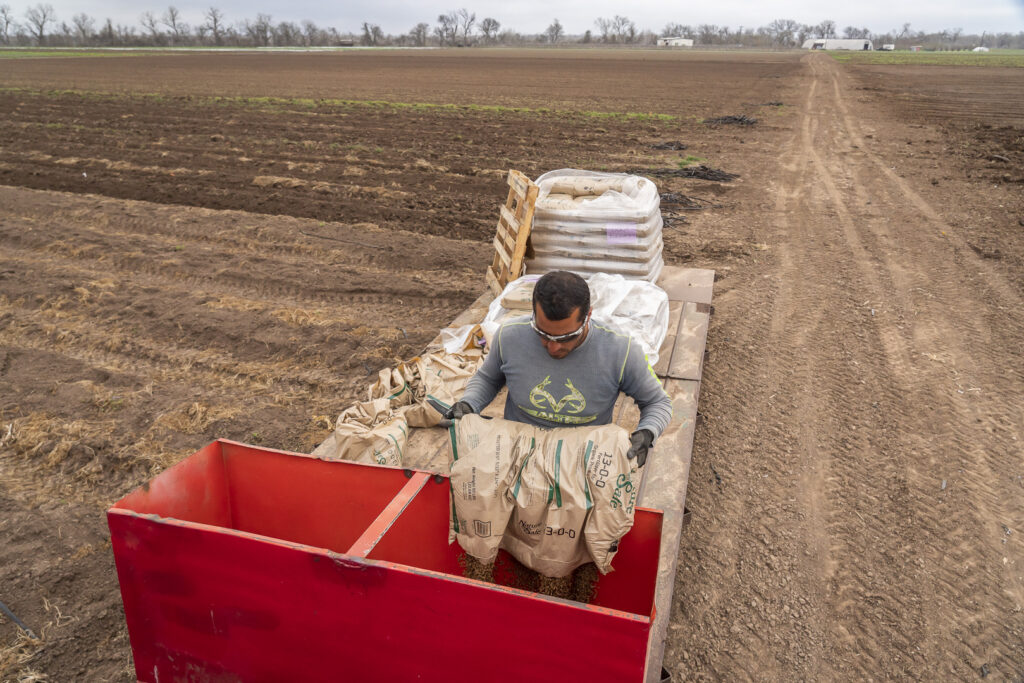 Cover crop seed going in the ground. Photo by Scott David Gordon.
Cover crop seed going in the ground. Photo by Scott David Gordon.
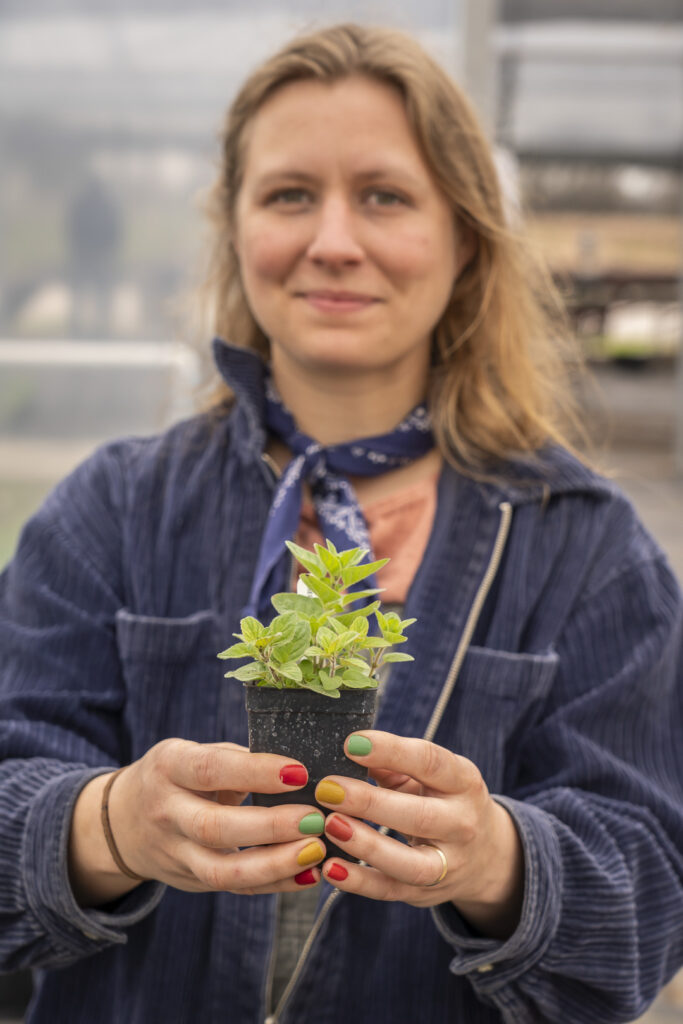 Ada showing off an oregano transplant. Photo by Scott David Gordon.
Ada showing off an oregano transplant. Photo by Scott David Gordon.
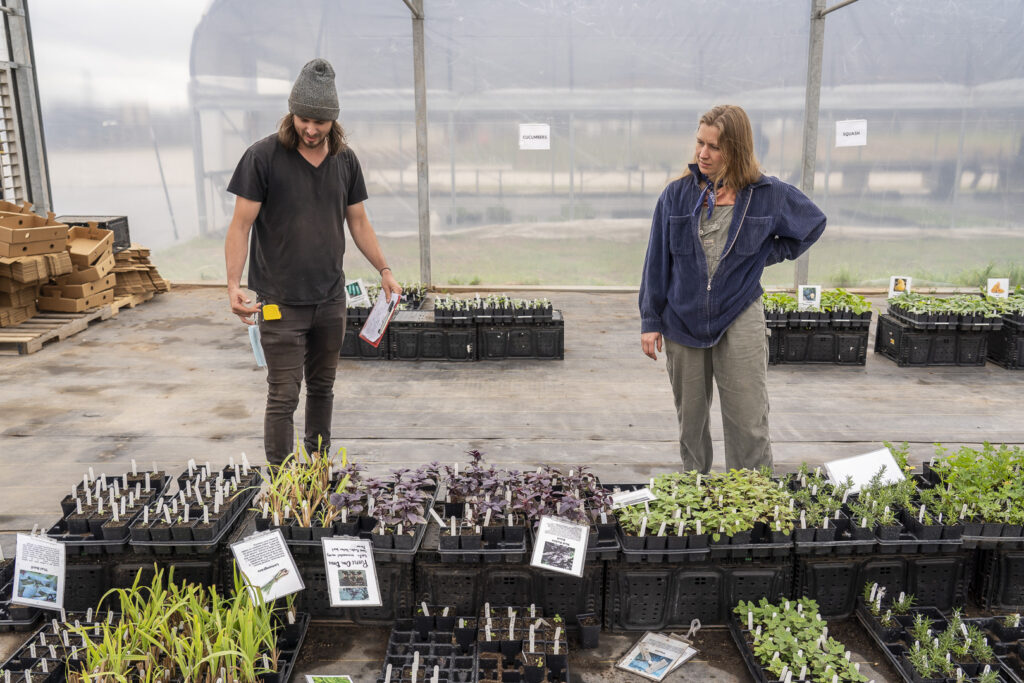 Ada and Adam checking out the herb inventory. Photo by Scott David Gordon.
Ada and Adam checking out the herb inventory. Photo by Scott David Gordon.
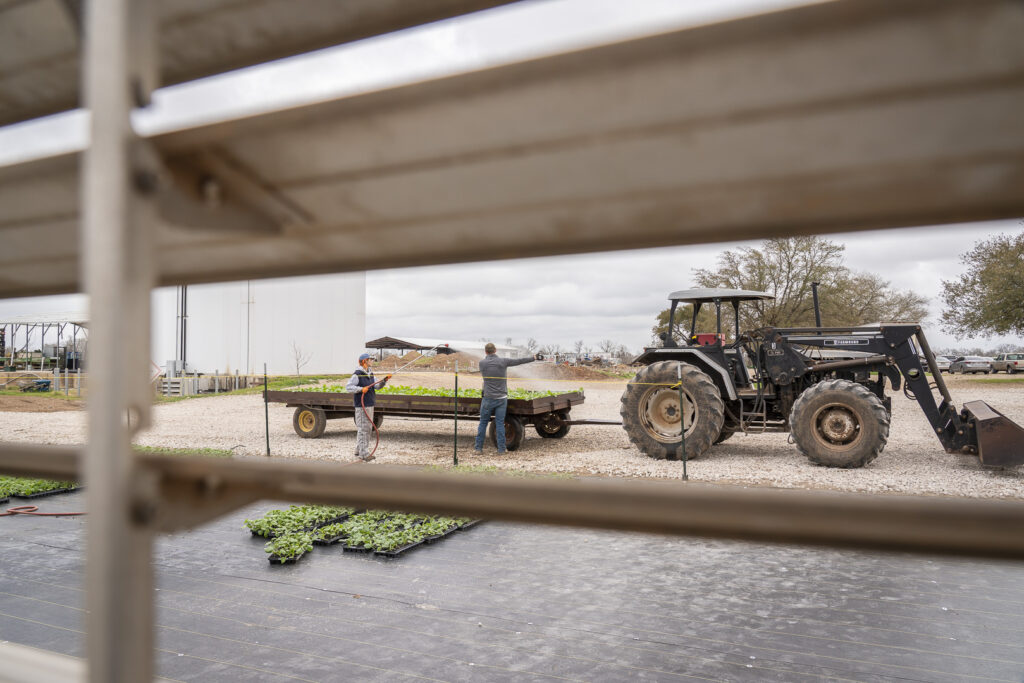 Views from inside the greenhouse. Photo by Scott David Gordon.
Views from inside the greenhouse. Photo by Scott David Gordon.
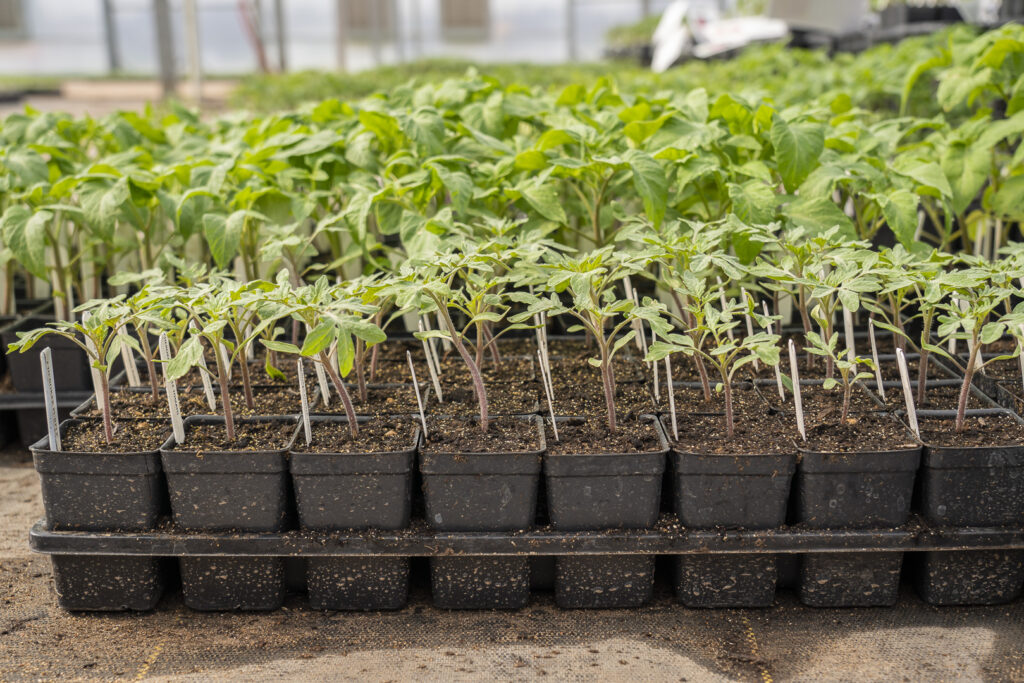 Successions of tomato transplants ready to go for the transplant sale. Photo by Scott David Gordon.
Successions of tomato transplants ready to go for the transplant sale. Photo by Scott David Gordon.
 The man behind the lens! We turned the camera on Scott this week, shown smiling in front of some cover crop. Photo by Scott David Gordon.
The man behind the lens! We turned the camera on Scott this week, shown smiling in front of some cover crop. Photo by Scott David Gordon.
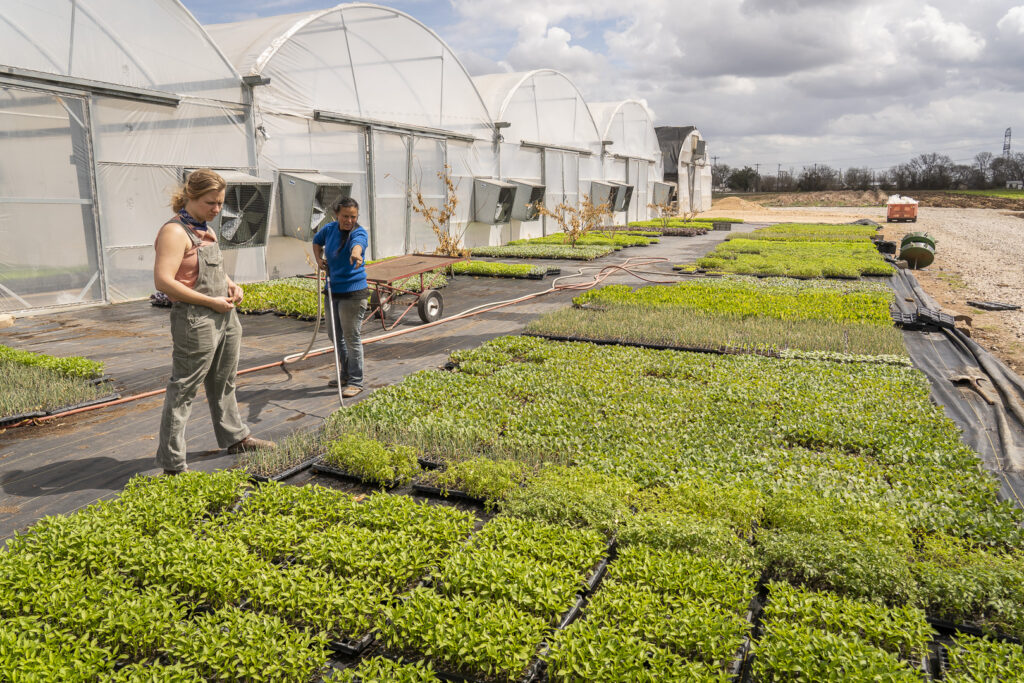 Giana and Ada chatting about transplants. Photo by Scott David Gordon.
Giana and Ada chatting about transplants. Photo by Scott David Gordon.
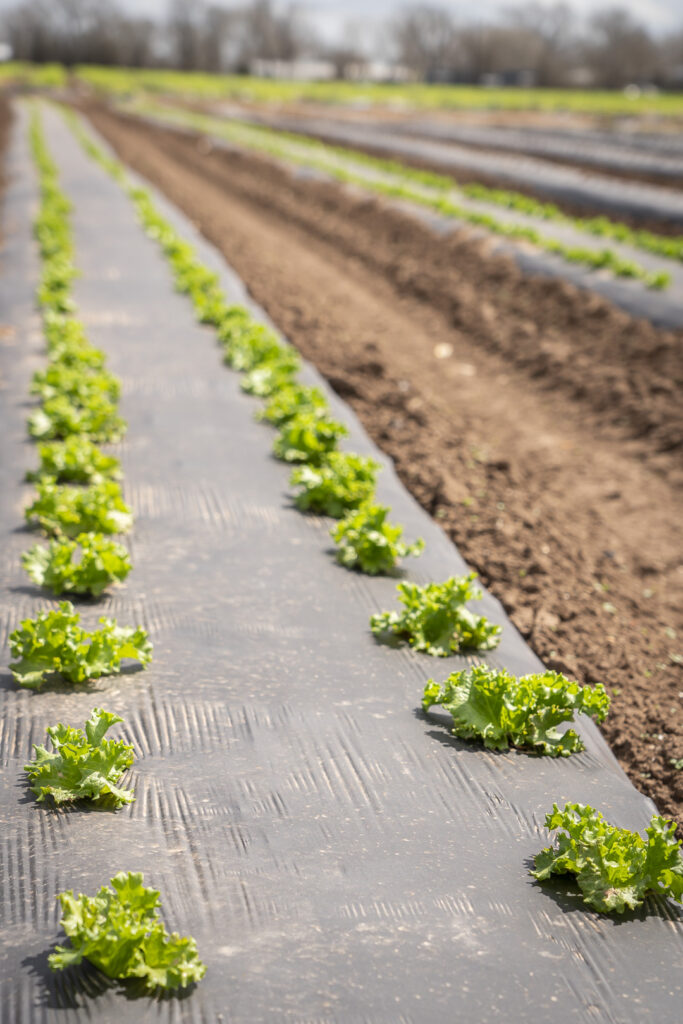 Green leaf lettuce was one of the first crops we transplanted after the storm. They're sizing up nicely! Photo by Scott David Gordon.
Green leaf lettuce was one of the first crops we transplanted after the storm. They're sizing up nicely! Photo by Scott David Gordon.
 Baby, baby bok choy. Photo by Scott David Gordon.
Baby, baby bok choy. Photo by Scott David Gordon.
 Krishna, Angel, and Jack in a parking lot meeting, dreaming about a new tractor.
Krishna, Angel, and Jack in a parking lot meeting, dreaming about a new tractor.CREAMY SWISS CHARD AND BUTTERNUT SQUASH
03/18/21 — Ada Broussard
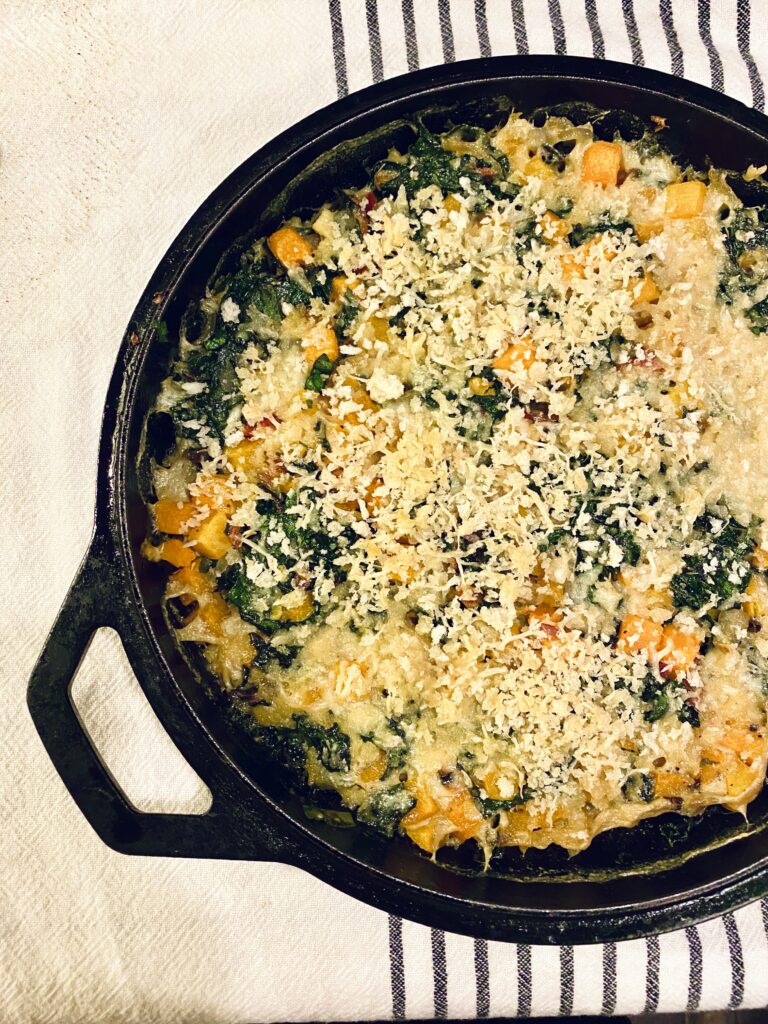
Recipe and photos by Christina Hurt Smith.
INGREDIENTS:
- 1 bunch of Swiss chard, chopped, leaves and stems separated
- 2 c butternut squash, cubed
- Salt
- Pepper
- 2 tbsp Olive oil
- 2 shallots, sliced thinly
- 3 cloves garlic, minced
- 2 tsp crushed red pepper
- 1/3 c Gruyère, shredded
- 4 oz whole milk
- 1/2 c panko breadcrumbs
- 1/4 parmesan, shredded
- Preheat oven to 400 degrees.
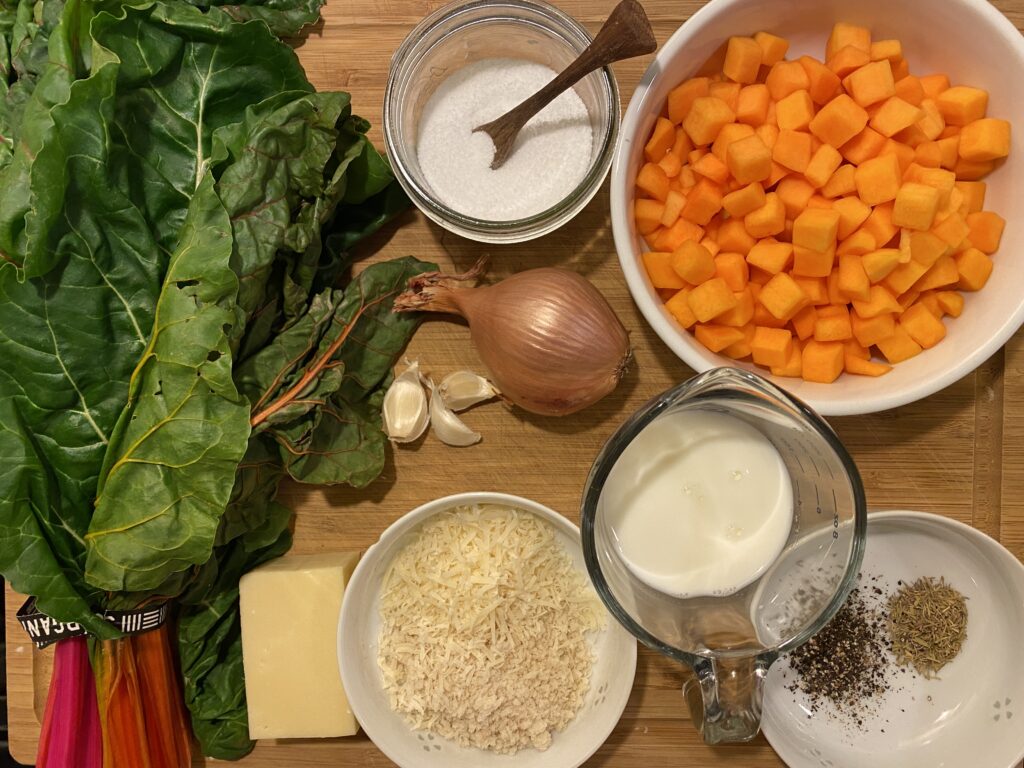
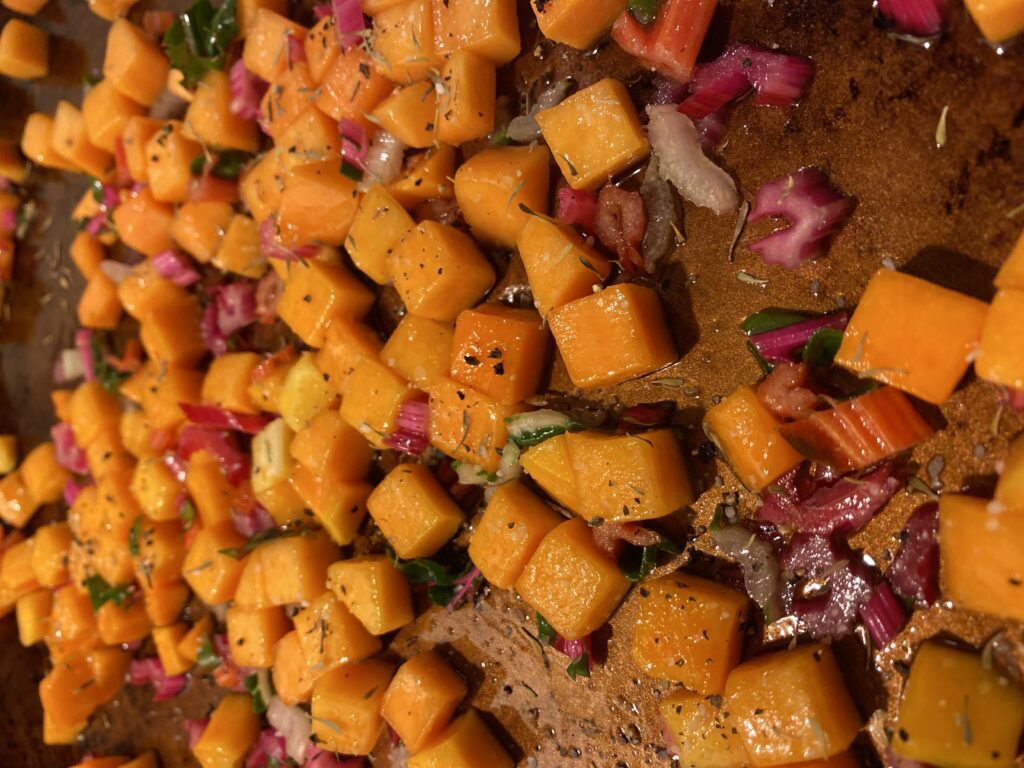
DIRECTIONS:
- On a large baking sheet, combine Swiss chard stems and butternut squash, 1 tbsp olive oil, and a dash of salt and pepper. Toss to coat, arrange in a single layer and roast for 12- 14 minutes or until butternut squash is tender.
- While the squash and chard are baking, bring a deep skillet (I prefer a cast iron) to medium-high heat and add the other tbsp of olive oil. Add garlic and shallot. Sauté for about 1 minute and then add chard leaves, about a 1/2 tsp of salt, cracked pepper, and crushed red pepper. Cook until wilted which should only take about 2-3 minutes tops.
- Turn skillet heat to medium-low. Add in baked chard stems and butternut squash, gruyère, and milk. Stir continuously until the cheese is completely melted. If you cooked the mixture in a cast iron you can keep it in the same pan for the next step. If not, transfer the mixture to an 8in x 8in baking dish.
- Toss panko breadcrumbs with a drizzle of olive oil and then toss in parmesan cheese. Top the chard and squash mixture with the breadcrumb mixture. Bake for 20 minutes. Mixture should be thick and bubbly. Turn oven to broil for a couple minutes to brown the crumb mixture.
- Let cool for a few minutes and then serve! Enjoy!
AN ODE TO HERBS
03/19/21 — Ada Broussard
An ode to herbs. We love to grow herbs at JBG. If you are a CSA Members, you know. When putting together your boxes, we usually put the herbs in last, and so they are likely the first vegetable to greet you when unpacking. If you’re a farmers’ market customer, you are likely used to herbal bouquets framing the cash register. While some of our other crops assume the role of an anchor vegetable, the type of thing you can build a meal around, herbs are different. They are the sparkle that can make even the most mundane plate shine. Having a fluency with fresh herbs can be a tell tale that you are a CSA Member, or at least have a relationship with someone who grows food. We shower you with these tiny, flavorful leaves year-round, and you, in turn, shower your plates, your bowls, and your platters with these fragrant plants.
![]() A kholrabi and fennel slaw, sprinkled with all the herbs. Photo and recipe by Mackenzie Smith. :
A kholrabi and fennel slaw, sprinkled with all the herbs. Photo and recipe by Mackenzie Smith. :
Herbs can brighten any dish, and like a squeeze of lemon, can add freshness to even the heaviest stew. Dill, tastes like spring itself - like grass, and deviled eggs, and potato salad and pickles. Herbs can garnish, but they can also stand alone. One of my absolute favorite ways to use herbs is to roughly chop a bunch (of anything) that has been well washed and well dried, and simply add the entire mount to a bowl of lettuce. There’s no reason why your salads shouldn’t contain leaves that pack a bit more flavor.
We’re in a bit of an herbal transition at the moment. Parsley, cilantro, and dill are still around, but soon these cooler weather crops will be replaced with the all glorious Genovese or Thai or Red Ruben basil - the herbal superstar of summer that makes a Caprese a Caprese and a pesto a pesto.
![]() A Caprese Salad, also by Mackenzie Smith.
A Caprese Salad, also by Mackenzie Smith.
Here at the farm, we grow tender herbs like parsley cilantro dill and basil. These crops can be eaten in their entirety, leaves to stems, and in the case of cilantro and parsley, roots too… though we don’t harvest those at JBG. Tender herbs with their delicate and glossy chlorophyll-packed-leaves like to be eaten sooner rather than later. Like a fresh bunch of flowers, these herbs like to be stored in a glass of water, in the fridge. You can even trim the ends to facilitate better water uptake and what we like to call refreshing. And then we’ve got the woody herbs. In this camp we have thyme, oregano, rosemary, and we’ll invite lemongrass, too, even those these tall blades almost seem to sway in a category all themselves. Woody herbs can provide flavor and depth, and a sense of place, to any dish. Regular roasted potatoes feel Italian when roasted with rosemary, and making a paste of lemongrass can transform normal-chicken to Southeast Asian chicken. All of the woody herbs from JBG dry well. Simply hang them somewhere in your kitchen. I like to just crinkle a dried bunch over my pan, until eventually only the naked stems are left.
Eat them raw, sprinkle on everything, or blitz them together and store in the freezer for another day. We love herbs, and we hope you do too. Please read on to hear about one man’s herbventure. The person, if you’re wondering, is Héctor González, Mexican at large, Abuelita Profesional, and our Social Media Manager
Part 1 of an Herbal Story, by Héctor:
PREAMBLE
My mother, Doña Licha, has a natural green thumb. I grew up surrounded by more green than I paid attention to. Isn’t it funny how these traits can be ignored, only to finally pay notice in retrospect?
Doña Licha kept so many wonderful plants alive and thriving. I recall with great warmth how she once got peaches for me and my sibling from el mercado. We were eating these duraznos in our room on the second floor of our home. My mother was there with us, eating and being playful. We needed to throw the pits to the trash but we didn’t want to walk ALL THE WAY to the bathroom. So, in our childish laziness, we threw the pits outside the window, directly into the front garden. We joked we would have a peach tree growing out soon.
My mother found those pits we threw, tended them, and made them grow SO TALL, that our peach tree grew above our two-story home. We often opened our window and stretched out our arms to grab a ripe durazno, giving it a quick rub against our clothes to remove the fuzz, to then sink into it with great gusto.
![]() Peach and loquat trees of Hectors childhood.
Peach and loquat trees of Hectors childhood.
I have ZERO plants in my home. I enjoy grabbing flowers at the farmers markets and bike back to my place with the bouquet shining inside my panniers. These brighten my place but these don’t require a lot of care or attention. I often marvel at other people's Instagram pages at how green and lush their places are. A silent voice in my childhood memories is ruffled.
----
I love to cook. More importantly, I love to eat and try new ideas. I have the fortune of working at JBG, which makes my food exploration easier. However, I have the romantic idea that while cooking, I just take a few steps outside, grab a few herbs from somewhere, and come back to continue the process in a seamless manner. It’s a fantasy. All fantasies are based in hope. Call it pandemic brain, foolish innocence, or just plain optimism, but I felt this year would be the one where I made that happen.
Now, here are the challenges: Space: I live in an apartment without any sort of earth-filled patio, and the space is limited Sun: I get a few hours of sun in the evening Experience: I helped my mother at times when I was young and I had a garden when I lived at a house. I still have a lot to learn Budget: I don’t want to make it a big expense.
![]()
 A kholrabi and fennel slaw, sprinkled with all the herbs. Photo and recipe by Mackenzie Smith. :
A kholrabi and fennel slaw, sprinkled with all the herbs. Photo and recipe by Mackenzie Smith. :
Herbs can brighten any dish, and like a squeeze of lemon, can add freshness to even the heaviest stew. Dill, tastes like spring itself - like grass, and deviled eggs, and potato salad and pickles. Herbs can garnish, but they can also stand alone. One of my absolute favorite ways to use herbs is to roughly chop a bunch (of anything) that has been well washed and well dried, and simply add the entire mount to a bowl of lettuce. There’s no reason why your salads shouldn’t contain leaves that pack a bit more flavor.
We’re in a bit of an herbal transition at the moment. Parsley, cilantro, and dill are still around, but soon these cooler weather crops will be replaced with the all glorious Genovese or Thai or Red Ruben basil - the herbal superstar of summer that makes a Caprese a Caprese and a pesto a pesto.
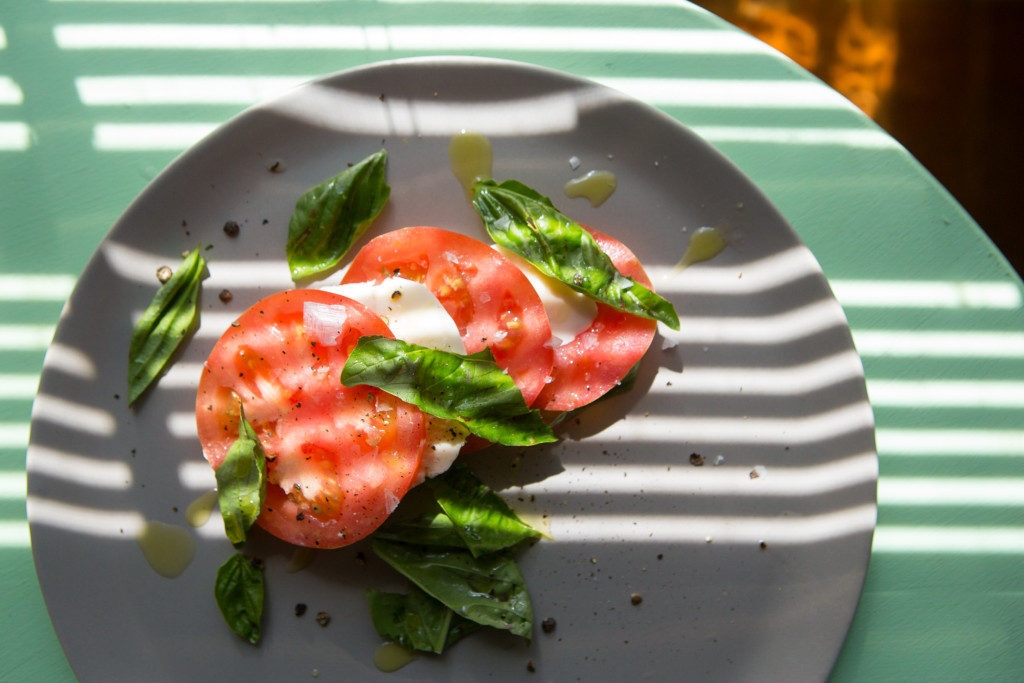 A Caprese Salad, also by Mackenzie Smith.
A Caprese Salad, also by Mackenzie Smith.
Here at the farm, we grow tender herbs like parsley cilantro dill and basil. These crops can be eaten in their entirety, leaves to stems, and in the case of cilantro and parsley, roots too… though we don’t harvest those at JBG. Tender herbs with their delicate and glossy chlorophyll-packed-leaves like to be eaten sooner rather than later. Like a fresh bunch of flowers, these herbs like to be stored in a glass of water, in the fridge. You can even trim the ends to facilitate better water uptake and what we like to call refreshing. And then we’ve got the woody herbs. In this camp we have thyme, oregano, rosemary, and we’ll invite lemongrass, too, even those these tall blades almost seem to sway in a category all themselves. Woody herbs can provide flavor and depth, and a sense of place, to any dish. Regular roasted potatoes feel Italian when roasted with rosemary, and making a paste of lemongrass can transform normal-chicken to Southeast Asian chicken. All of the woody herbs from JBG dry well. Simply hang them somewhere in your kitchen. I like to just crinkle a dried bunch over my pan, until eventually only the naked stems are left.
Eat them raw, sprinkle on everything, or blitz them together and store in the freezer for another day. We love herbs, and we hope you do too. Please read on to hear about one man’s herbventure. The person, if you’re wondering, is Héctor González, Mexican at large, Abuelita Profesional, and our Social Media Manager
Part 1 of an Herbal Story, by Héctor:
PREAMBLE
My mother, Doña Licha, has a natural green thumb. I grew up surrounded by more green than I paid attention to. Isn’t it funny how these traits can be ignored, only to finally pay notice in retrospect?
Doña Licha kept so many wonderful plants alive and thriving. I recall with great warmth how she once got peaches for me and my sibling from el mercado. We were eating these duraznos in our room on the second floor of our home. My mother was there with us, eating and being playful. We needed to throw the pits to the trash but we didn’t want to walk ALL THE WAY to the bathroom. So, in our childish laziness, we threw the pits outside the window, directly into the front garden. We joked we would have a peach tree growing out soon.
My mother found those pits we threw, tended them, and made them grow SO TALL, that our peach tree grew above our two-story home. We often opened our window and stretched out our arms to grab a ripe durazno, giving it a quick rub against our clothes to remove the fuzz, to then sink into it with great gusto.
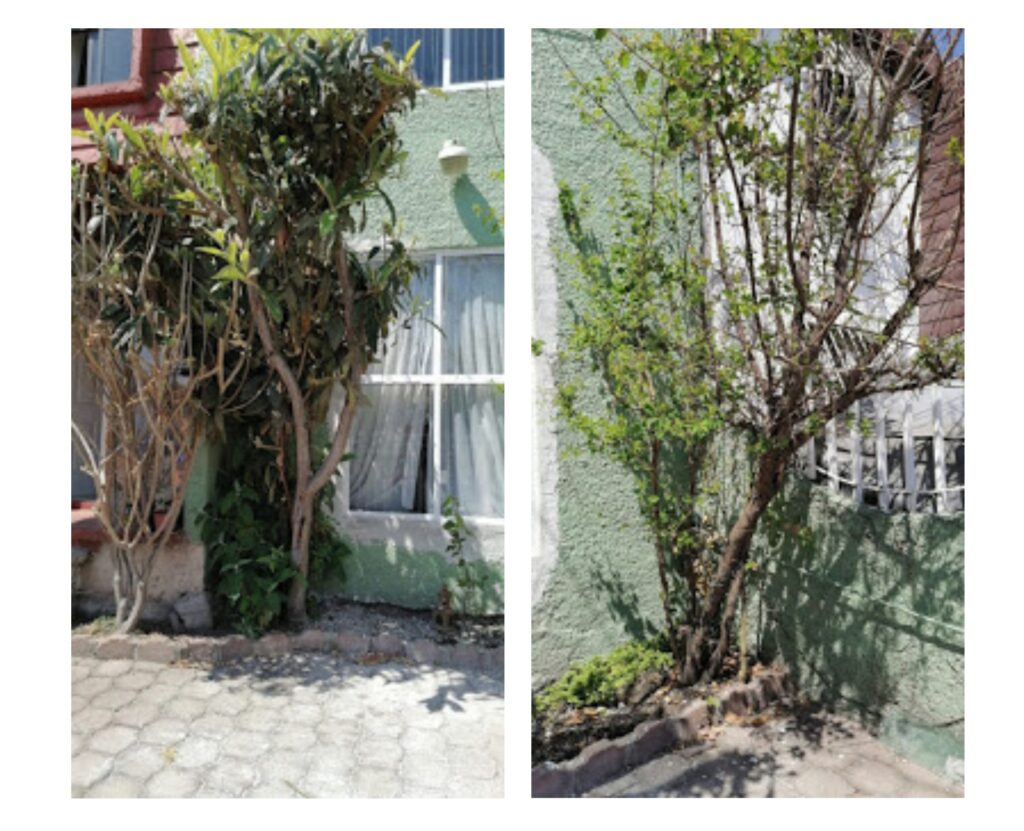 Peach and loquat trees of Hectors childhood.
Peach and loquat trees of Hectors childhood.
I have ZERO plants in my home. I enjoy grabbing flowers at the farmers markets and bike back to my place with the bouquet shining inside my panniers. These brighten my place but these don’t require a lot of care or attention. I often marvel at other people's Instagram pages at how green and lush their places are. A silent voice in my childhood memories is ruffled.
----
I love to cook. More importantly, I love to eat and try new ideas. I have the fortune of working at JBG, which makes my food exploration easier. However, I have the romantic idea that while cooking, I just take a few steps outside, grab a few herbs from somewhere, and come back to continue the process in a seamless manner. It’s a fantasy. All fantasies are based in hope. Call it pandemic brain, foolish innocence, or just plain optimism, but I felt this year would be the one where I made that happen.
Now, here are the challenges: Space: I live in an apartment without any sort of earth-filled patio, and the space is limited Sun: I get a few hours of sun in the evening Experience: I helped my mother at times when I was young and I had a garden when I lived at a house. I still have a lot to learn Budget: I don’t want to make it a big expense.

SOUTH INDIAN YOGURT COOLER
03/25/21 — Ada Broussard
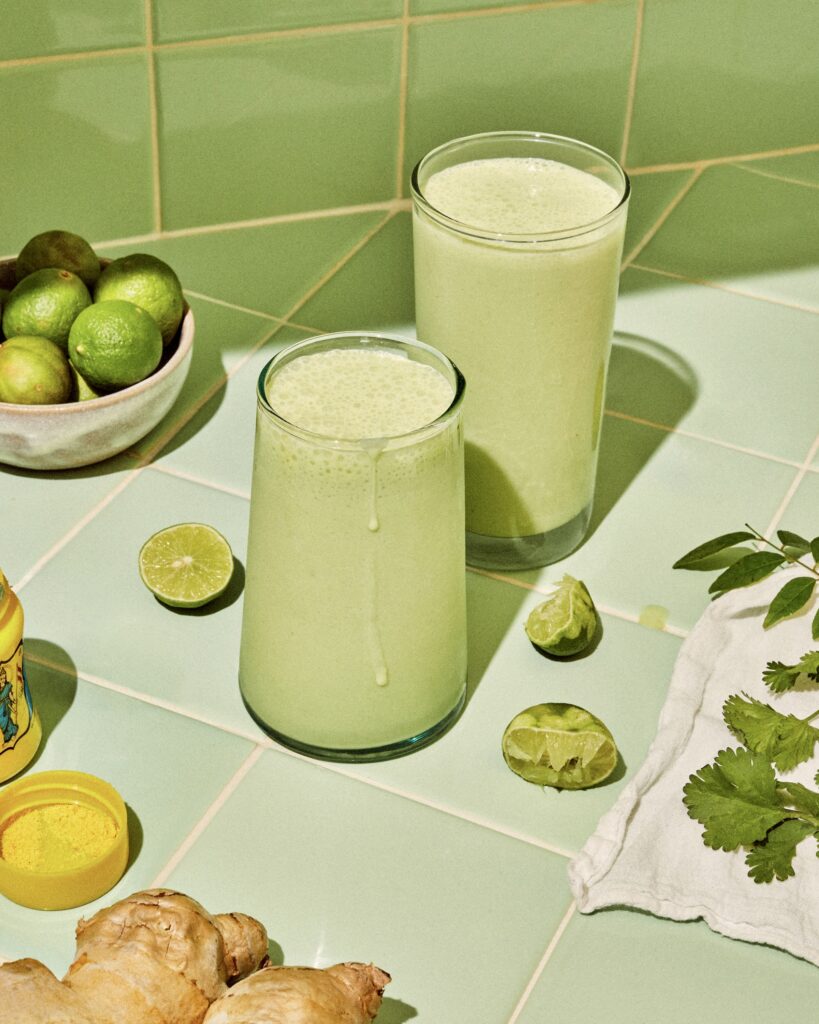 A yogurt cooler, made and shot by Mackenzie Smith Kelley.
A yogurt cooler, made and shot by Mackenzie Smith Kelley.
It was very hot and humid in June 2018, and I was about 7 and a half months pregnant. My husband and I drove to Dallas so he could work as my digital tech and I could shoot the last leg of the Indian-ish cookbook with Priya, her parents Ritu and Shelly, and our food stylist Judy Kim.
We all posted up at the Krishnas for the weekend, where we would photograph the new cover option and a few stragglers that didn’t make it into the first round of recipes we shot for the book earlier in the year. One of those was Ritu’s South Indian Yogurt Cooler, a refreshing drink she would often share with her friends when they met up on the weekends for long social hikes.
Priya and I thought it would be fun to shoot the yogurt cooler by driving about 30 minutes out to the spot where they liked to hike and include Ritu with some of her friends in the shot. But, we were only there for the weekend, and shooting the cover was the priority. The Yogurt Cooler was not.
Instead of driving out for a hike at 7am, Ritu got up with me while the rest of the house was still asleep, donned her hiking gear, and blended a big batch of the icy, spicy yogurt cooler that has become a beloved staple in our home over the past few years.
I tasted that frothy mix of yogurt, cilantro, curry leaves, ginger, hot pepper, hing, a pinch of salt, and a handful of ice for the first time right before we headed down to the small stream in the Krishna’s backyard. We did our best to make it look like Ritu might be breaking for the yogurt cooler after a long hike with friends and wrapped the shot within 15 minutes, pretty quick, given our 30-45 minute average per shot with that book. I was admittedly very motivated to get back inside with a full glass of my new favorite refreshment, which I made every single day until my baby was born that August, and again on many summer days since then.
There are so many gems in Indian-ish that Ritu’s yogurt cooler hasn’t gotten a ton of attention, but I am here to tell you that it’s worth a try, especially as we move into warmer months and cilantro is still thriving.
Hing, or Aesafetida, is a flavor enhancer that Priya says makes food taste more Indian. I don't know about that, but I do know it makes food taste more delicious, and it's worth a trip to one of Austin's Indian grocers for a small jar of it. While you're there, pick up some fresh curry leaves (buy the whole plant if they are available!) I could tell you to make something else with the leftover leaves, but if you're anything like me, you'll be making the yogurt cooler often enough you won't need any inspiration for the curry leaves.
Recipe
- 1 1/2 cups full-fat plain yogurt
- 2 tablespoons fresh chopped cilantro
- 4 fresh curry leaves
- 1 teaspoon minced fresh ginger
- 1 small Indian green chile or serrano chile, chopped
- pinch of hing
- pinch of salt
- 1/4 cup ice cubes
- (I also love to add 1 small squeeze of lime and about half a teaspoon of zest for an extra boost of vitamin c and even more zing!)
 Ritu and her yogurt cooler. Photo by Mackenzie Smith Kelley, shot originally for Indian-ish.
Ritu and her yogurt cooler. Photo by Mackenzie Smith Kelley, shot originally for Indian-ish.HECTOR'S HERBVENTURE: PART 2
03/26/21 — Ada Broussard
At the end of last week's blog post, An Ode to Herbs, we shared Part 1 of Hector's Herbventure - his journey into growing his first-ever herb garden! We know you've been on pins and needles, curious to see how his herbventure is coming together, and so without further adieu, part 2.
Photos and story by JBG's Social Media Manager, Héctor. For more Héctor, checkout his food-centric Instagram.
![]()
I want a cute herb garden in my apartment’s tiny patio. I have adorable tags ready. What else do I need? Planters. I started to pay more attention during my regular walks around the neighborhood. I saw how people in the nearby apartments grew herbs and flowers with apparent ease. I started to feel hopeful.
I recall a few years ago some of my friends did their herb gardens inside a wooden wine box crate. The project looked very twee and functional. I wanted that. I started messaging the nearby liquor stores, asking if they received wine in wood boxes. Sadly, no luck. The local HEB shared similar results.
I messaged the Central Market and the next day someone from their wine department called me. Yes, they receive wine in these boxes from time to time. They didn’t have any at the moment but they could call me when some arrived. Potentially, I had wine boxes. I contacted the main office at JBG and they reserved some herbs for me. I got: Chives Curly parsley Flat parsley Oregano Genovese basil Thyme Rosemary
A few minutes after I sent that email, I got a call from Central Market. They received a few boxes. I reserved two, for pickup later that day. My bike ride there was peaceful but the return was amusing. I got a lot of quizzical looks from drivers.
![]()
These boxes still needed some work done. I need soil. I still need to learn how to keep my new herb babies alive. So much to do, so much to see*.
*The writer doesn’t assume responsibility for you having All Star from Smash Mouth now stuck on your head.
"Last fall I asked if you thought the walking onions in my CSA box would grow if planted. Your response was try it and send a picture if it worked. I planted six individual onions and they are doing quite well. Even survived the 5” of snow in my yard (in a temporary greenhouse). Each individual onion is now a clump of 5 or 6 spring onions!"
![]() Green onions for days! Photo by Joy.
Green onions for days! Photo by Joy.
![]()
![]() The famed rosemary bush, before it died. Photo by Kimberly.
The famed rosemary bush, before it died. Photo by Kimberly.
![]() Rosemary cuttings, counted out and ready for rooting.
Rosemary cuttings, counted out and ready for rooting.
![]() Your rosemary bush started in Kimberly's kitchen!
Your rosemary bush started in Kimberly's kitchen!
![]() Farmer Brenton is excited about rosemary. Are you?
Farmer Brenton is excited about rosemary. Are you?
Photos and story by JBG's Social Media Manager, Héctor. For more Héctor, checkout his food-centric Instagram.
PREPAREDNESS
The Texas Farmers Markets used to do these kitchen rummage sales, where people brought in their kitchen tools and toys that fell into disuse or were simply forgotten. At one of these I managed to score my first sous vide circulator for only $50! I have donated and scored knick knacks there through the years. Some I have used regularly, others got gifted to friends who needed these. One of those purchases was a set of 8 terracotta labels for the garden. I remember seeing the box while looking at a cocktail shaker set. I think it was less than $2 and thought “I don’t have a garden now but someday, someday I will.”
I want a cute herb garden in my apartment’s tiny patio. I have adorable tags ready. What else do I need? Planters. I started to pay more attention during my regular walks around the neighborhood. I saw how people in the nearby apartments grew herbs and flowers with apparent ease. I started to feel hopeful.
I recall a few years ago some of my friends did their herb gardens inside a wooden wine box crate. The project looked very twee and functional. I wanted that. I started messaging the nearby liquor stores, asking if they received wine in wood boxes. Sadly, no luck. The local HEB shared similar results.
I messaged the Central Market and the next day someone from their wine department called me. Yes, they receive wine in these boxes from time to time. They didn’t have any at the moment but they could call me when some arrived. Potentially, I had wine boxes. I contacted the main office at JBG and they reserved some herbs for me. I got: Chives Curly parsley Flat parsley Oregano Genovese basil Thyme Rosemary
A few minutes after I sent that email, I got a call from Central Market. They received a few boxes. I reserved two, for pickup later that day. My bike ride there was peaceful but the return was amusing. I got a lot of quizzical looks from drivers.

These boxes still needed some work done. I need soil. I still need to learn how to keep my new herb babies alive. So much to do, so much to see*.
*The writer doesn’t assume responsibility for you having All Star from Smash Mouth now stuck on your head.
A Few More Herbventures, submitted by our Farm Family.
This herbal story was message to us on Facebook by CSA Member Joy:
"Last fall I asked if you thought the walking onions in my CSA box would grow if planted. Your response was try it and send a picture if it worked. I planted six individual onions and they are doing quite well. Even survived the 5” of snow in my yard (in a temporary greenhouse). Each individual onion is now a clump of 5 or 6 spring onions!"
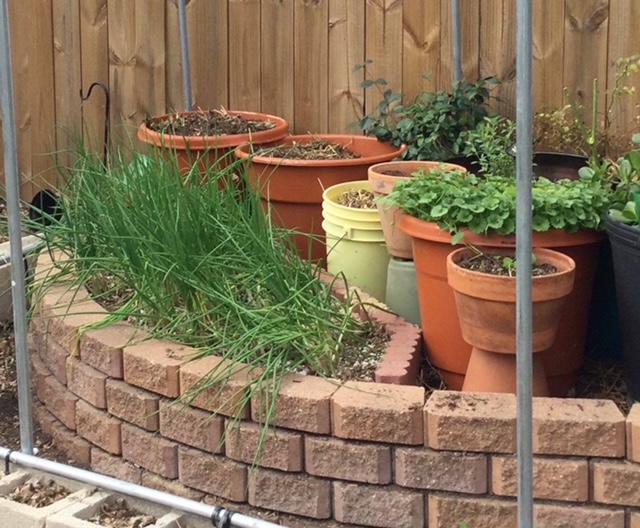 Green onions for days! Photo by Joy.
Green onions for days! Photo by Joy.
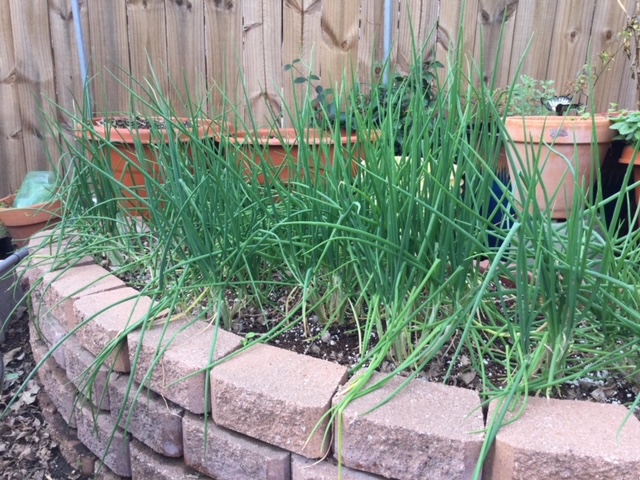
Did you buy a rosemary transplant from this year's transplant sale? Here is the origin story of these transplants, submitted by Kimberly!
"In 2004 when I first moved to Austin I brought a rosemary plant that I kept in a pot, until I finally planted it in the ground at my house in east Austin in 2013. Over the years I started to lovingly refer to it as "the blob" because once it was in the ground it started taking up more and more real estate in the yard. Brenton asked me to take cuttings of it for Gianna to root for the transplant sale. It was so massive that I cut off probably 200 large stems and you couldn't even see that it looked any different. I'm very sad to say that my beautiful, long-beloved, ever larger and larger rosemary died in the super cold snow and ice storm, but I'm so, so happy that it has little babies that will be growing all over Austin now. I think the last of them may have sold last weekend, but I'm glad I got one before they were gone. " The famed rosemary bush, before it died. Photo by Kimberly.
The famed rosemary bush, before it died. Photo by Kimberly.
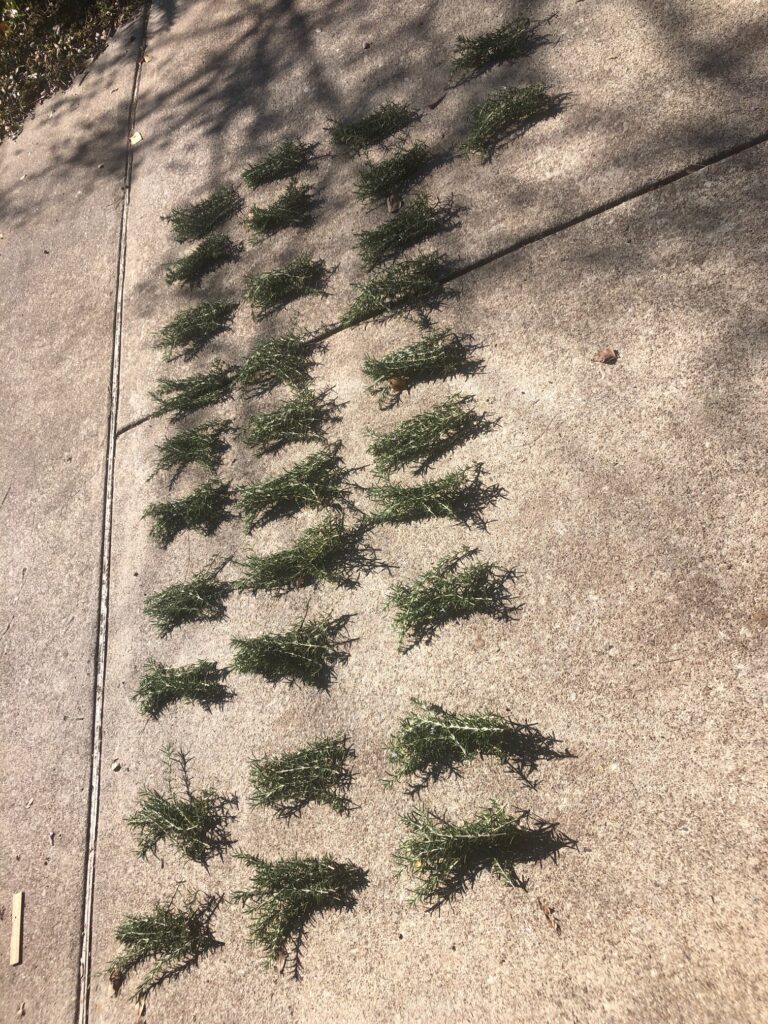 Rosemary cuttings, counted out and ready for rooting.
Rosemary cuttings, counted out and ready for rooting.
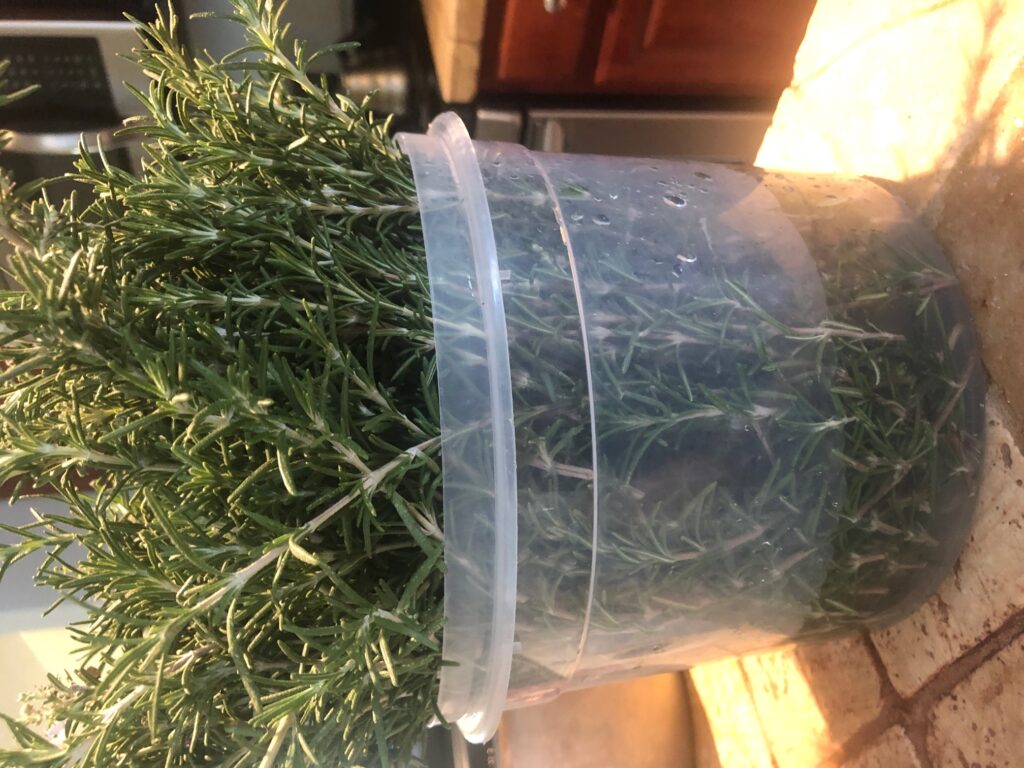 Your rosemary bush started in Kimberly's kitchen!
Your rosemary bush started in Kimberly's kitchen!
 Farmer Brenton is excited about rosemary. Are you?
Farmer Brenton is excited about rosemary. Are you?
PHOTOS FROM THE FARM: 3.23.21
03/26/21 — Ada Broussard
An array of photos this week showing the dimensional corners of the farm: plants, flowers, equipment, people, soil, and tractors. We love them all. Happy Spring!
![]() Early morning at JBG, captured by Scott David Gordon.
Early morning at JBG, captured by Scott David Gordon.
![]() Green and red leaf lettuce looking very happy after a morning sprinkle. Photo by Scott David Gordon.
Green and red leaf lettuce looking very happy after a morning sprinkle. Photo by Scott David Gordon.
![]() Bulk bins, lined up among the lush grass, grown as a cover crop to protect and enrich unused soil. Photo by Scott David Gordon.
Bulk bins, lined up among the lush grass, grown as a cover crop to protect and enrich unused soil. Photo by Scott David Gordon.
![]() The leaves on this spinach are ginormous! Photo by Scott David Gordon.
The leaves on this spinach are ginormous! Photo by Scott David Gordon.
![]() A very hearty spinach harvest, that would make Popeye proud. Photo by Scott David Gordon.
A very hearty spinach harvest, that would make Popeye proud. Photo by Scott David Gordon.
![]() Red leaf lettuce, ready to be transplanted into the ground. Photo by Scott David Gordon.
Red leaf lettuce, ready to be transplanted into the ground. Photo by Scott David Gordon.
![]() Rich burgundy carpet. Photo by Scott David Gordon.
Rich burgundy carpet. Photo by Scott David Gordon.
![]() Green lettuce getting transplanted by hand, filling in the holes left empty by the recent winter storm. Photo by Scott David Gordon.
Green lettuce getting transplanted by hand, filling in the holes left empty by the recent winter storm. Photo by Scott David Gordon.
![]() Perky romaine, glowing in the sun. Photo by Scott David Gordon.
Perky romaine, glowing in the sun. Photo by Scott David Gordon.
![]() Tim, working on the discs! His to-do list is never actually done. Photo by Scott David Gordon.
Tim, working on the discs! His to-do list is never actually done. Photo by Scott David Gordon.
![]() Did you see this week's recipe for a South Indian Yogurt Cooler? The perfect beverage to enjoy this cilantro before it's gone! Photo by Scott David Gordon.
Did you see this week's recipe for a South Indian Yogurt Cooler? The perfect beverage to enjoy this cilantro before it's gone! Photo by Scott David Gordon.
![]() Rainbow chard stem, when diced, makes a colorful addition to any stir fry. Photo by Scott David Gordon.
Rainbow chard stem, when diced, makes a colorful addition to any stir fry. Photo by Scott David Gordon.
![]() This beautiful chard grew directly out of the mess of chard that died during the storm. If you look closely, you can see the dead leaves on the ground which look like mulch. We applaud chard's resiliency! Photo by Scott David Gordon.
This beautiful chard grew directly out of the mess of chard that died during the storm. If you look closely, you can see the dead leaves on the ground which look like mulch. We applaud chard's resiliency! Photo by Scott David Gordon.
![]() In the spring, these are our transplant boxes. In the summer, they get filled with tomatoes. Checkout our transplant sale happening this Saturday from 9-1 at our Garfield farm. Photo by Scott David Gordon.
In the spring, these are our transplant boxes. In the summer, they get filled with tomatoes. Checkout our transplant sale happening this Saturday from 9-1 at our Garfield farm. Photo by Scott David Gordon.
![]() All of the transplants on the far-right aisle in this picture are our "Spring" transplants - brassicas like collards and kale, as well as lettuces and cabbage. These will all be discounted this weekend to half-off. Come and get 'em! Photo by Scott David Gordon.
All of the transplants on the far-right aisle in this picture are our "Spring" transplants - brassicas like collards and kale, as well as lettuces and cabbage. These will all be discounted this weekend to half-off. Come and get 'em! Photo by Scott David Gordon.
![]() Vegetal color blocking. Photo by Scott David Gordon.
Vegetal color blocking. Photo by Scott David Gordon.
![]() Our farm manager Jack attaching the plastic mulch layer to the John Deere. Photo by Scott David Gordon.
Our farm manager Jack attaching the plastic mulch layer to the John Deere. Photo by Scott David Gordon.
![]() This tree line backs up to Dry Creek, a creek that runs through the middle of the farm. Habitat like this, as well as rows of these yellow flowers, make for a wonderful home for beneficial insects and pollinators. Photo by Scott David Gordon.
This tree line backs up to Dry Creek, a creek that runs through the middle of the farm. Habitat like this, as well as rows of these yellow flowers, make for a wonderful home for beneficial insects and pollinators. Photo by Scott David Gordon.
![]() Some cilantro that we've let go to flower. Every good farmer knows you've gotta feed the bees! Photo by Scott David Gordon.
Some cilantro that we've let go to flower. Every good farmer knows you've gotta feed the bees! Photo by Scott David Gordon.
 Early morning at JBG, captured by Scott David Gordon.
Early morning at JBG, captured by Scott David Gordon.
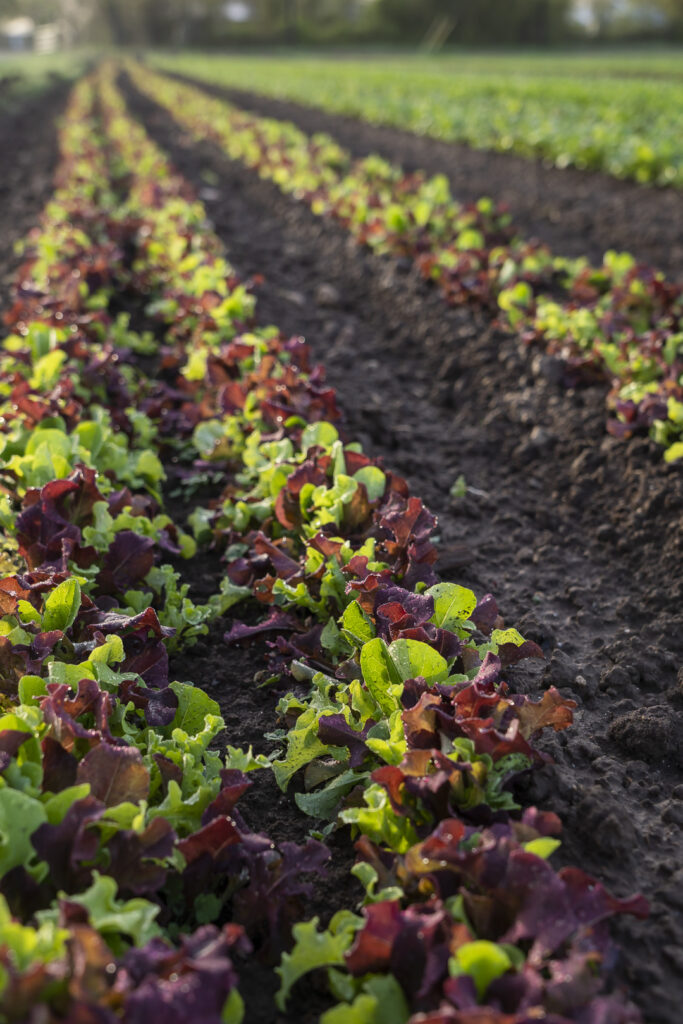 Green and red leaf lettuce looking very happy after a morning sprinkle. Photo by Scott David Gordon.
Green and red leaf lettuce looking very happy after a morning sprinkle. Photo by Scott David Gordon.
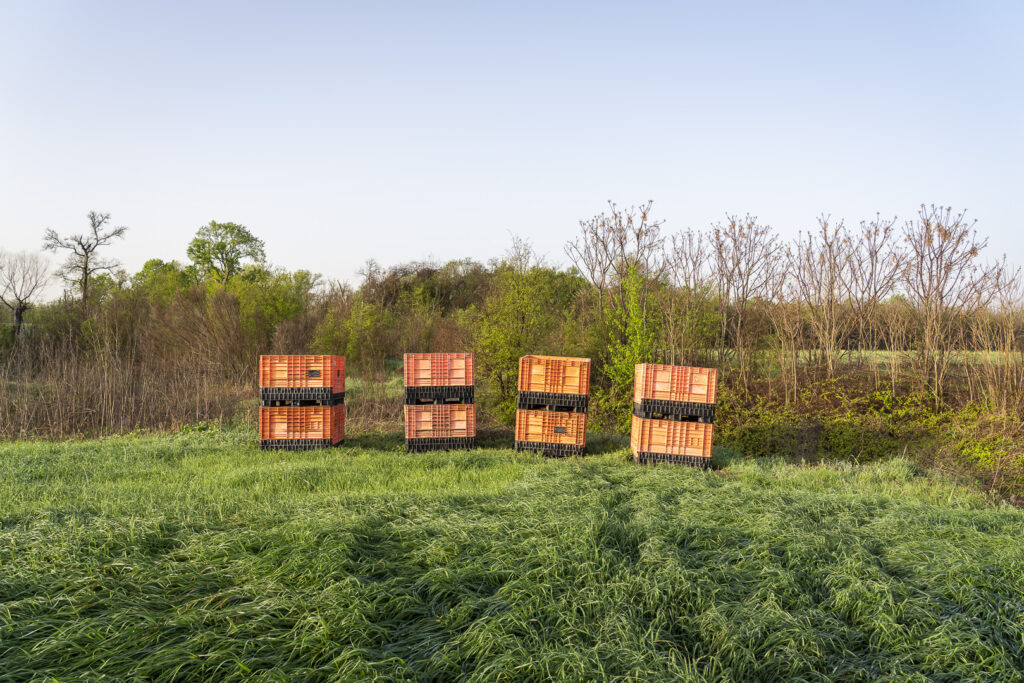 Bulk bins, lined up among the lush grass, grown as a cover crop to protect and enrich unused soil. Photo by Scott David Gordon.
Bulk bins, lined up among the lush grass, grown as a cover crop to protect and enrich unused soil. Photo by Scott David Gordon.
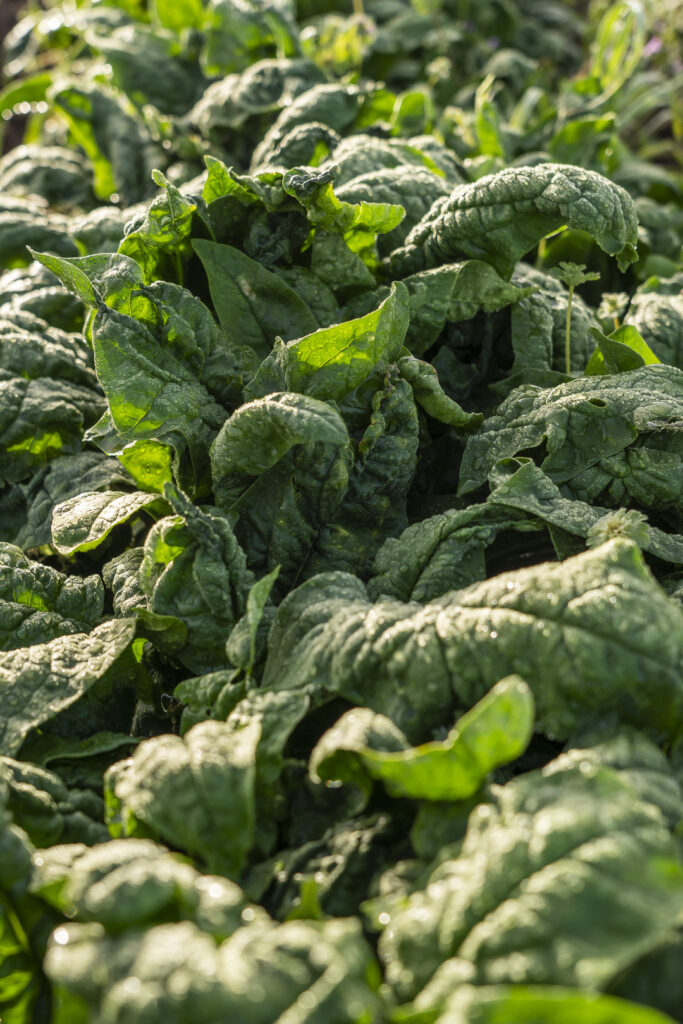 The leaves on this spinach are ginormous! Photo by Scott David Gordon.
The leaves on this spinach are ginormous! Photo by Scott David Gordon.
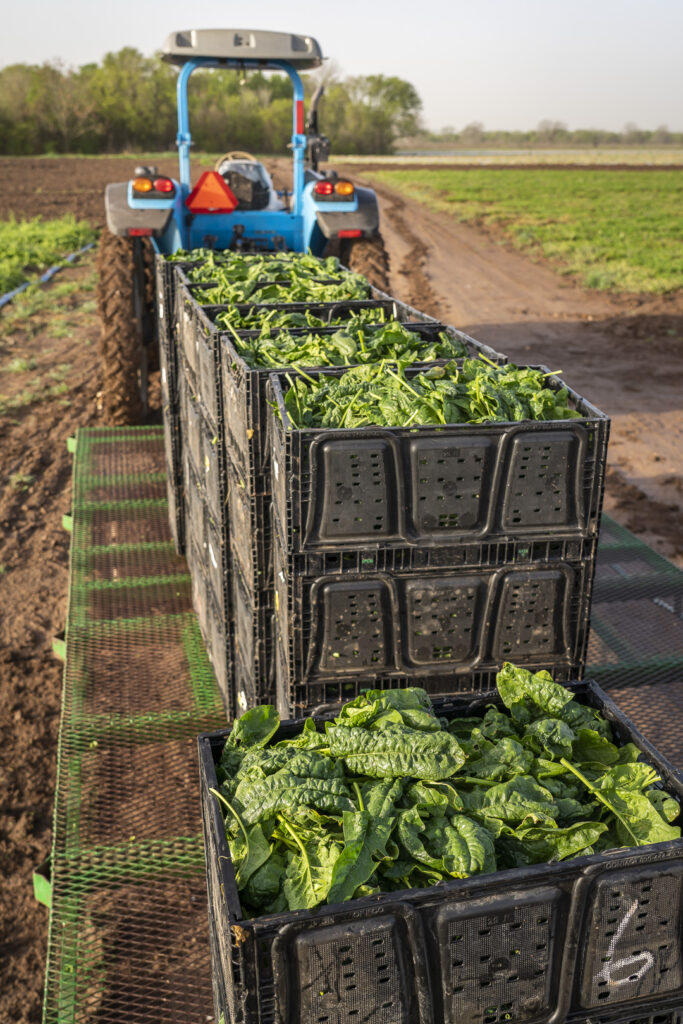 A very hearty spinach harvest, that would make Popeye proud. Photo by Scott David Gordon.
A very hearty spinach harvest, that would make Popeye proud. Photo by Scott David Gordon.
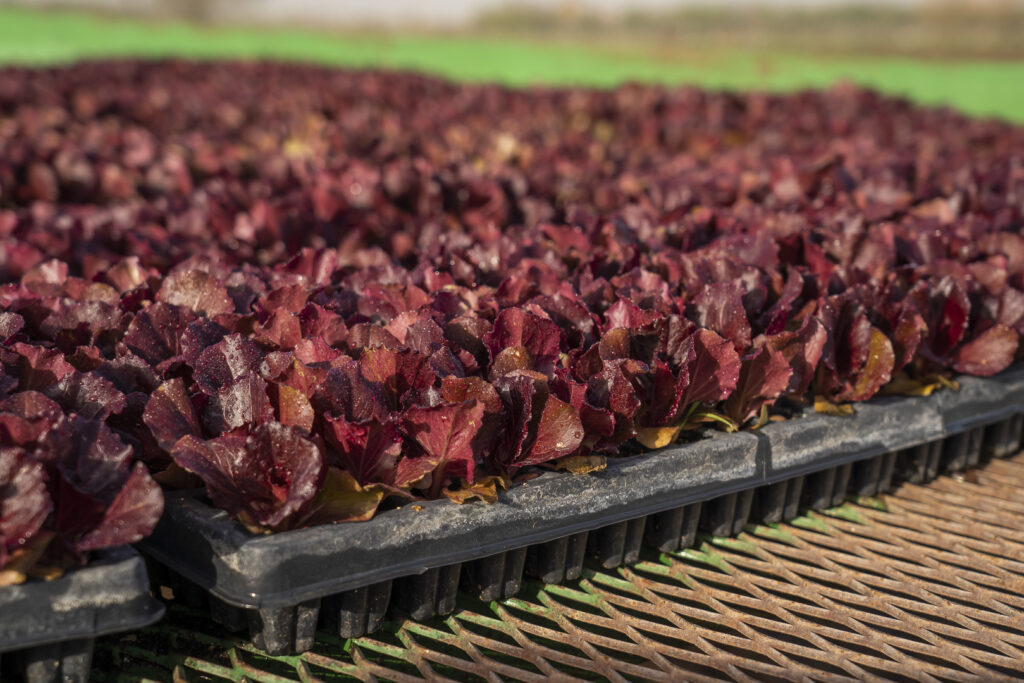 Red leaf lettuce, ready to be transplanted into the ground. Photo by Scott David Gordon.
Red leaf lettuce, ready to be transplanted into the ground. Photo by Scott David Gordon.
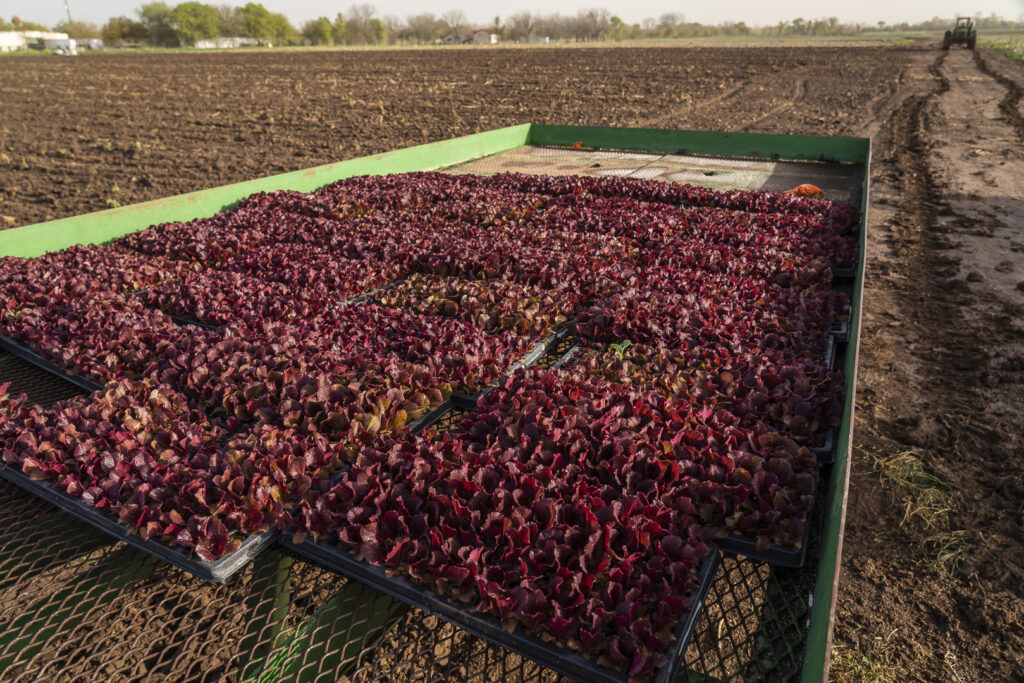 Rich burgundy carpet. Photo by Scott David Gordon.
Rich burgundy carpet. Photo by Scott David Gordon.
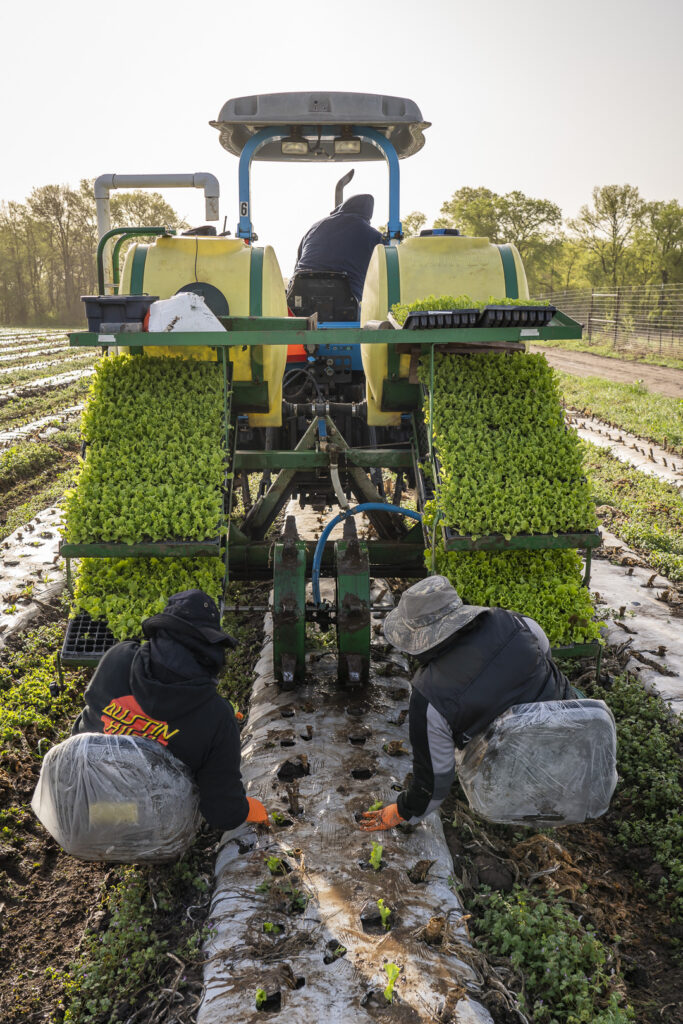 Green lettuce getting transplanted by hand, filling in the holes left empty by the recent winter storm. Photo by Scott David Gordon.
Green lettuce getting transplanted by hand, filling in the holes left empty by the recent winter storm. Photo by Scott David Gordon.
 Perky romaine, glowing in the sun. Photo by Scott David Gordon.
Perky romaine, glowing in the sun. Photo by Scott David Gordon.
 Tim, working on the discs! His to-do list is never actually done. Photo by Scott David Gordon.
Tim, working on the discs! His to-do list is never actually done. Photo by Scott David Gordon.
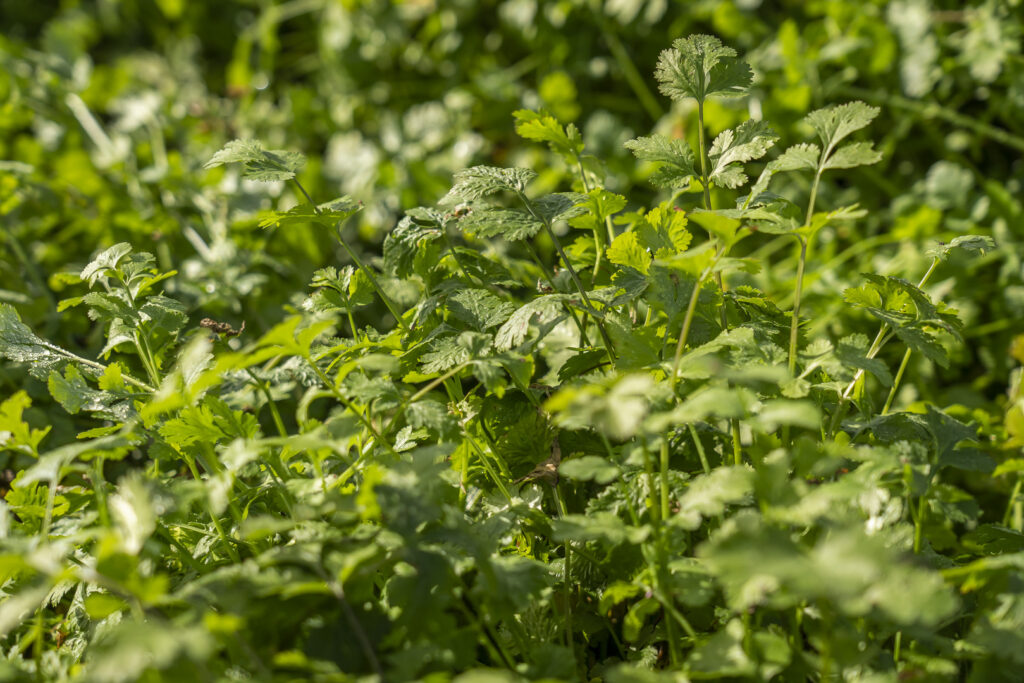 Did you see this week's recipe for a South Indian Yogurt Cooler? The perfect beverage to enjoy this cilantro before it's gone! Photo by Scott David Gordon.
Did you see this week's recipe for a South Indian Yogurt Cooler? The perfect beverage to enjoy this cilantro before it's gone! Photo by Scott David Gordon.
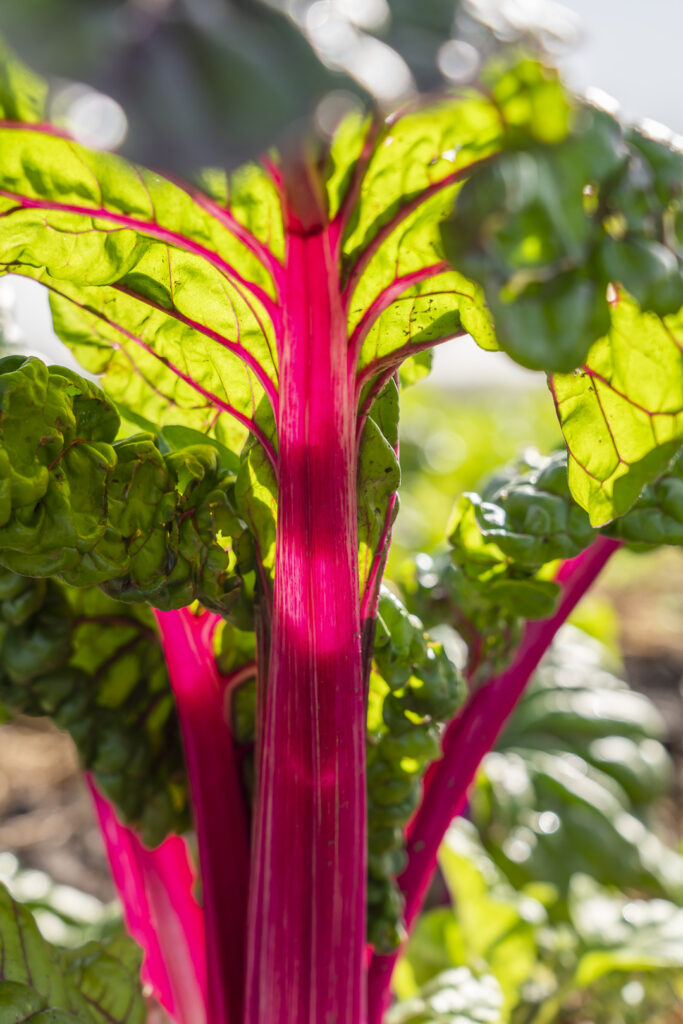 Rainbow chard stem, when diced, makes a colorful addition to any stir fry. Photo by Scott David Gordon.
Rainbow chard stem, when diced, makes a colorful addition to any stir fry. Photo by Scott David Gordon.
 This beautiful chard grew directly out of the mess of chard that died during the storm. If you look closely, you can see the dead leaves on the ground which look like mulch. We applaud chard's resiliency! Photo by Scott David Gordon.
This beautiful chard grew directly out of the mess of chard that died during the storm. If you look closely, you can see the dead leaves on the ground which look like mulch. We applaud chard's resiliency! Photo by Scott David Gordon.
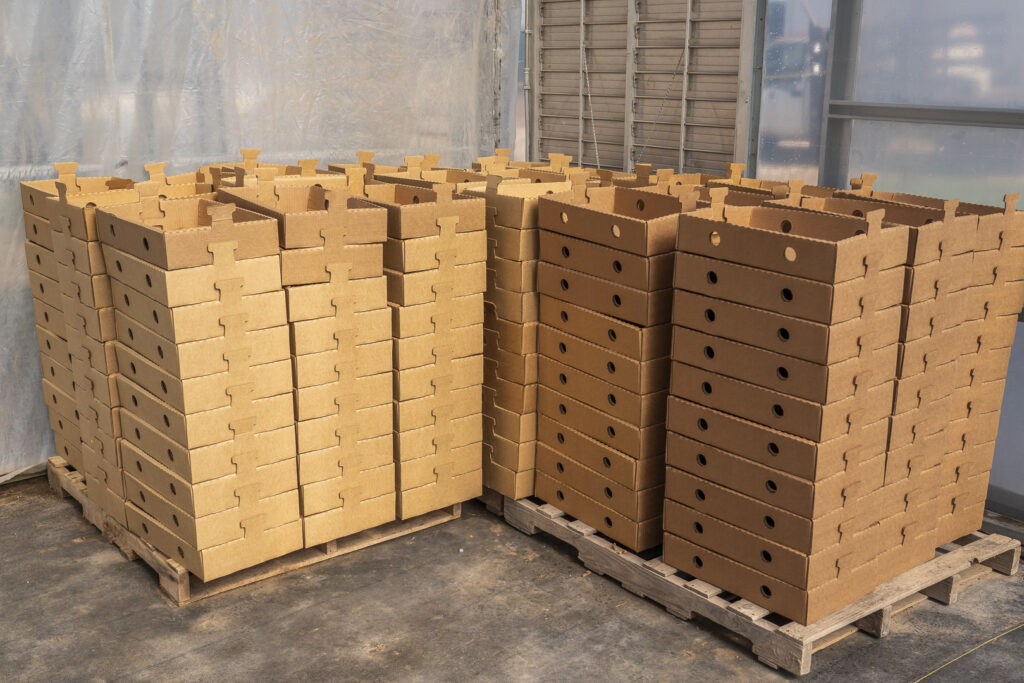 In the spring, these are our transplant boxes. In the summer, they get filled with tomatoes. Checkout our transplant sale happening this Saturday from 9-1 at our Garfield farm. Photo by Scott David Gordon.
In the spring, these are our transplant boxes. In the summer, they get filled with tomatoes. Checkout our transplant sale happening this Saturday from 9-1 at our Garfield farm. Photo by Scott David Gordon.
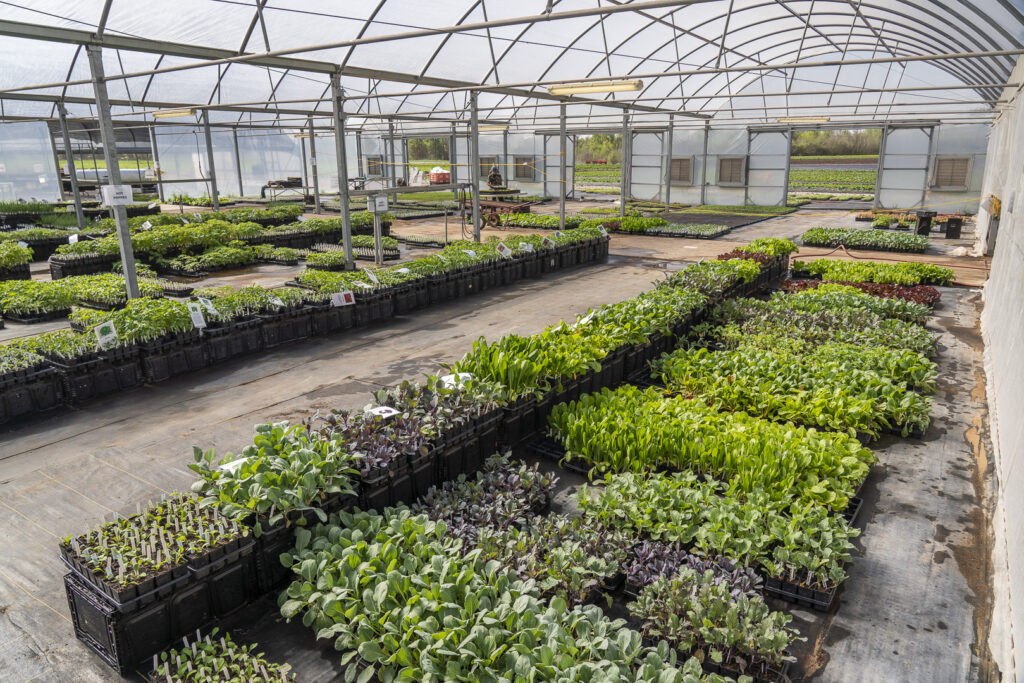 All of the transplants on the far-right aisle in this picture are our "Spring" transplants - brassicas like collards and kale, as well as lettuces and cabbage. These will all be discounted this weekend to half-off. Come and get 'em! Photo by Scott David Gordon.
All of the transplants on the far-right aisle in this picture are our "Spring" transplants - brassicas like collards and kale, as well as lettuces and cabbage. These will all be discounted this weekend to half-off. Come and get 'em! Photo by Scott David Gordon.
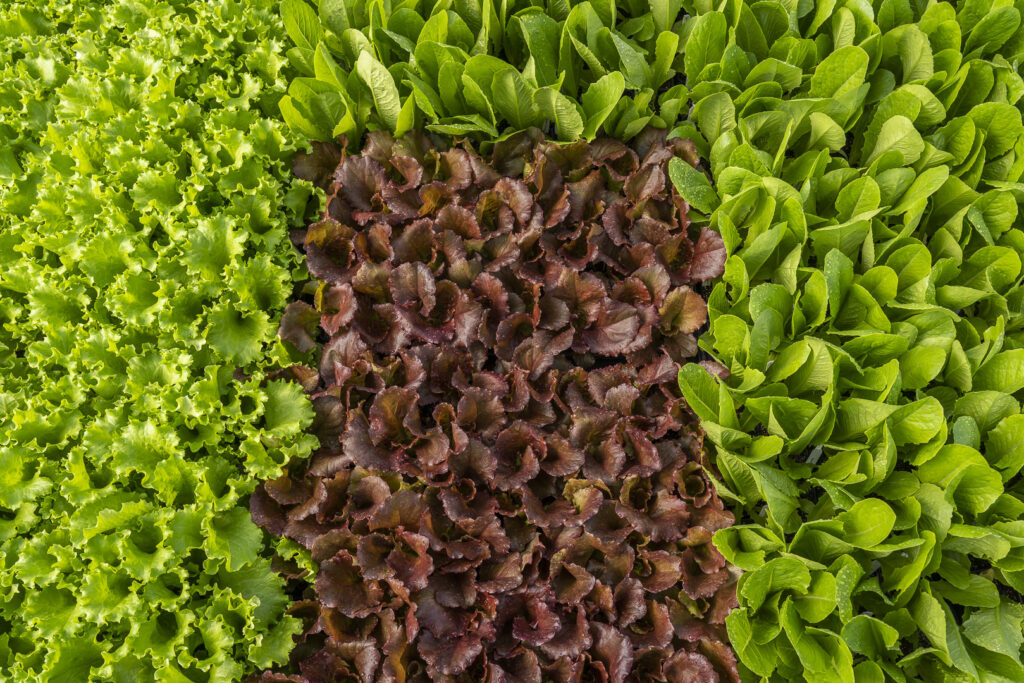 Vegetal color blocking. Photo by Scott David Gordon.
Vegetal color blocking. Photo by Scott David Gordon.
 Our farm manager Jack attaching the plastic mulch layer to the John Deere. Photo by Scott David Gordon.
Our farm manager Jack attaching the plastic mulch layer to the John Deere. Photo by Scott David Gordon.
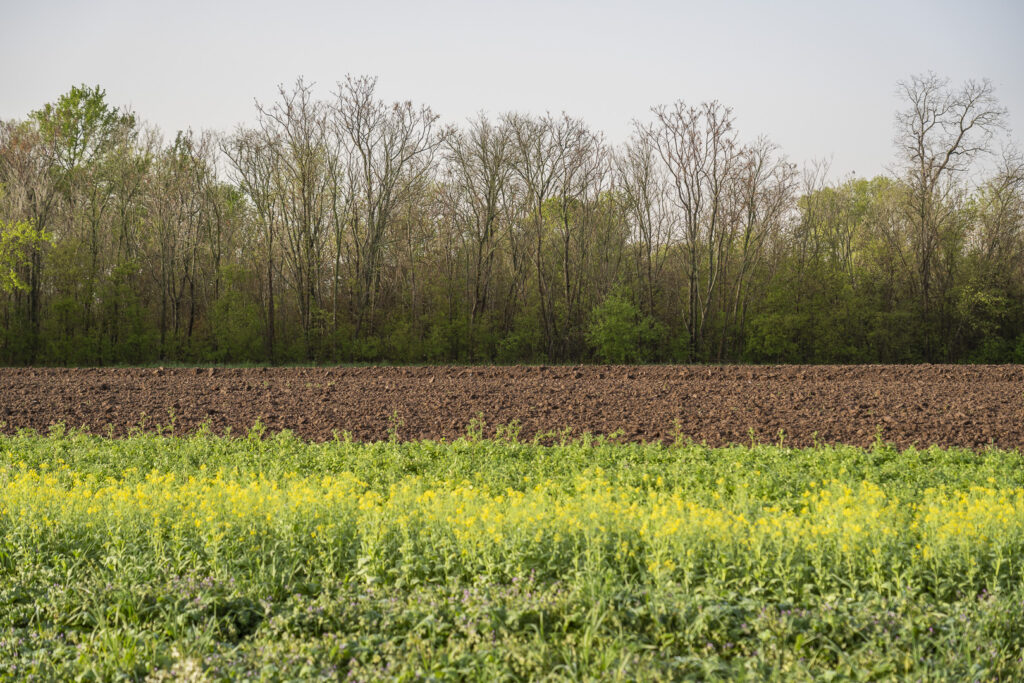 This tree line backs up to Dry Creek, a creek that runs through the middle of the farm. Habitat like this, as well as rows of these yellow flowers, make for a wonderful home for beneficial insects and pollinators. Photo by Scott David Gordon.
This tree line backs up to Dry Creek, a creek that runs through the middle of the farm. Habitat like this, as well as rows of these yellow flowers, make for a wonderful home for beneficial insects and pollinators. Photo by Scott David Gordon.
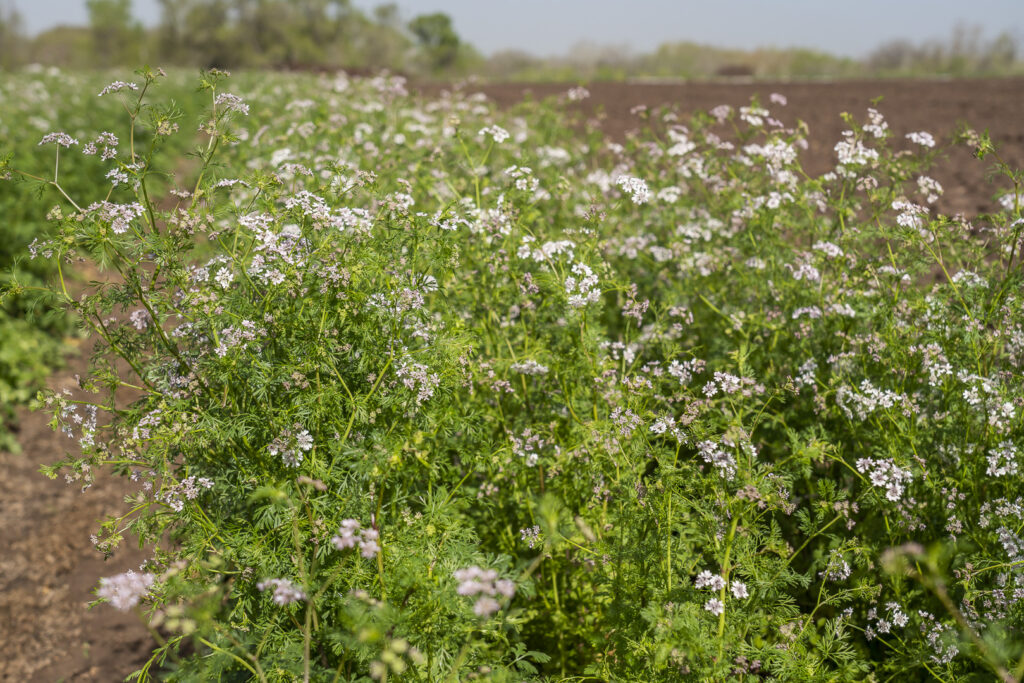 Some cilantro that we've let go to flower. Every good farmer knows you've gotta feed the bees! Photo by Scott David Gordon.
Some cilantro that we've let go to flower. Every good farmer knows you've gotta feed the bees! Photo by Scott David Gordon.






 0 ITEMS IN CART
0 ITEMS IN CART 

